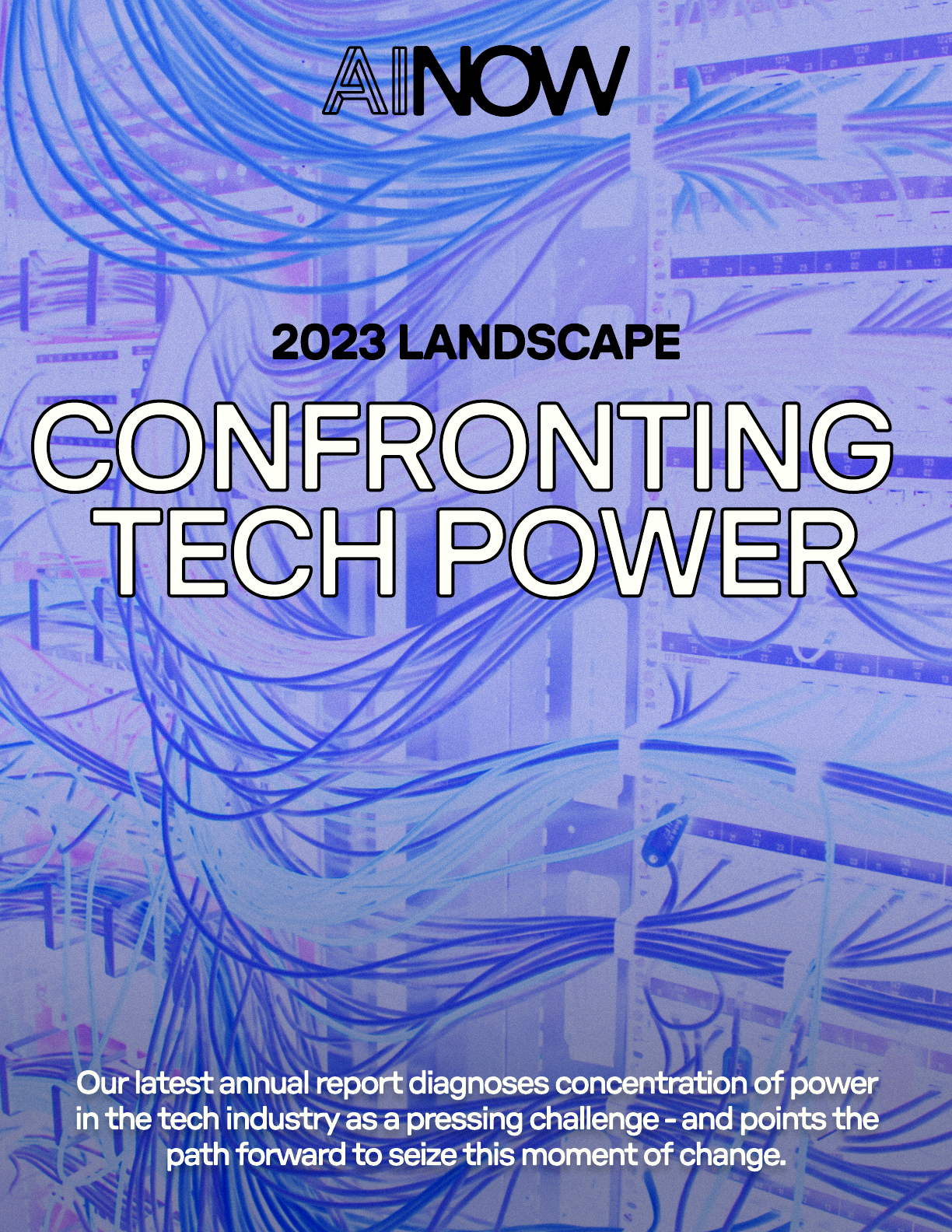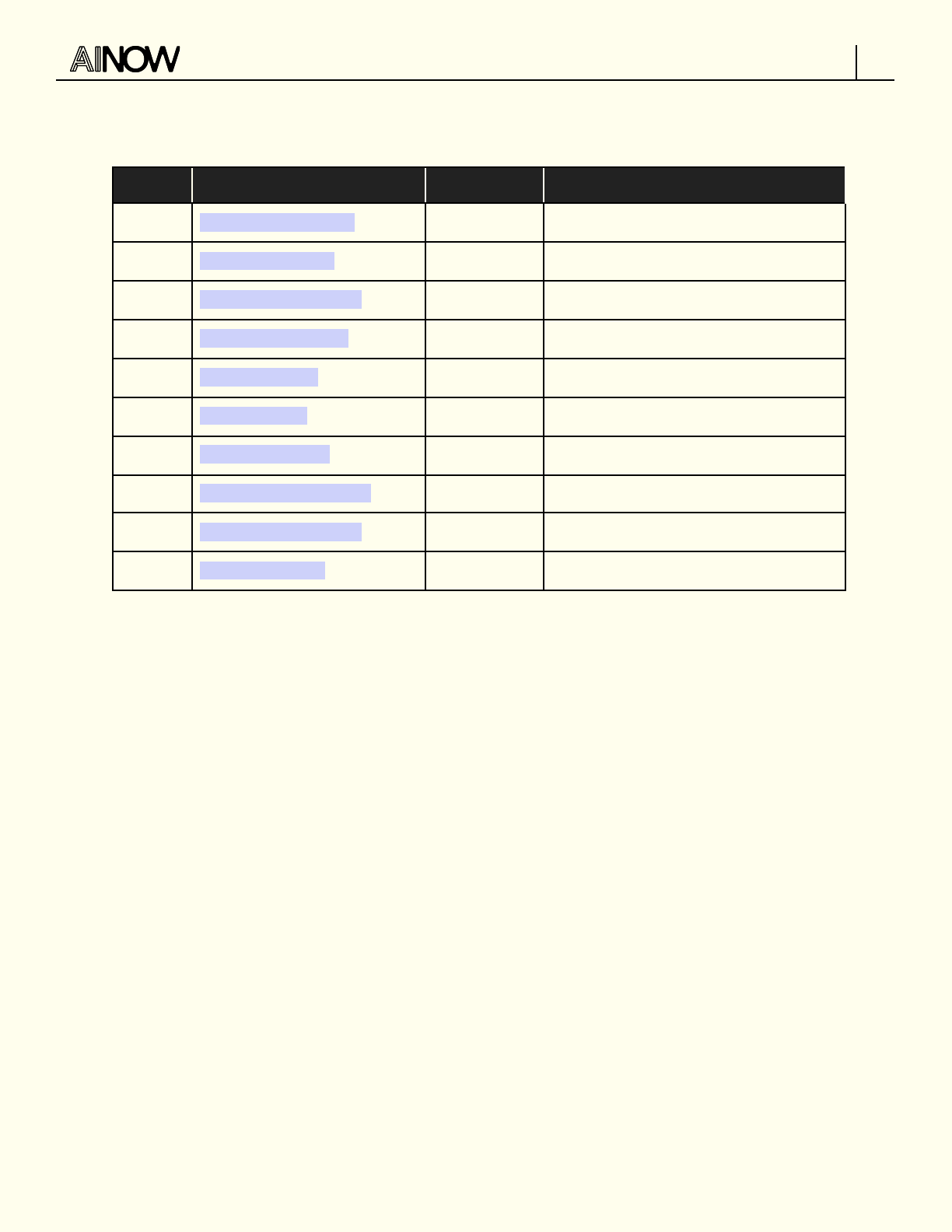

2023 Landscape
2
ACKNOWLEDGEMENTS
Authored by Amba Kak and Dr. Sarah Myers West.
With research and editorial contributions from Alejandro Calcaño, Jane Chung, Dr. Kerry McInerney and
Meredith Whittaker.
Copyediting by Caren Litherland.
Design by Partner & Partners.
Special thanks to all those that provided feedback on sections in the report including Veena Dubal,
Ryan Gerety, Sara Geoghegan, Ellen Goodman, Alex Harman, Daniel Leufer, Estelle Masse, Fanny
Hidvegi, Tamara Kneese, J. Nathan Mathias, Julia Powles, Daniel Rangel, Gabrielle Rejouis, Maurice
Stucke, Charlotte Slaiman, Lori Wallach, Ben Winters, and Jai Vipra.
Cite as: Amba Kak and Sarah Myers West, “AI Now 2023 Landscape: Confronting Tech Power”, AI Now
Institute, April 11, 2023, https://ainowinstitute.org/2023-landscape.

2023 Landscape
3
Table of Contents
Executive Summary............................................................................................................................................................5
chatGPT And More: Large Scale AI Models Entrench Big Tech Power.................................................................16
Toxic Competition: Regulating Big Tech’s Data Advantage....................................................................................24
Algorithmic Accountability: Moving beyond audits..................................................................................................35
SPOTLIGHT: Data Minimization as a Tool for AI accountability............................................................................. 44
Algorithmic Management: Creating Bright-Line Rules to Restrain Workplace Surveillance.........................48
SPOTLIGHT: Tech and Financial Capital...................................................................................................................... 58
Antitrust: It’s Time for Structural Reforms to Big Tech........................................................................................... 64
Biometric Surveillance Is Quietly Expanding: Bright-Line Rules Are Key........................................................... 75
International “Digital Trade” Agreements: The Next Frontier.................................................................................80
US-China Arms Race: AI Policy as Industrial Policy.................................................................................................86
SPOTLIGHT: The Climate Costs of Big Tech............................................................................................................. 100

2023 Landscape
4
Executive Summary
Artificial intelligence
1
is captivating our attention, generating both fear and awe about what’s coming
next. As increasingly dire prognoses about AI’s future trajectory take center stage in the headlines
about generative AI, it’s time for regulators, and the public, to ensure that there is nothing about
artificial intelligence (and the industry that powers it) that we need to accept as given. This watershed
moment must also swiftly give way to action: to galvanize the considerable energy that has already
accumulated over several years towards developing meaningful checks on the trajectory of AI
technologies. This must start with confronting the concentration of power in the tech industry.
The AI Now Institute was founded in 2017, and even within that short span we’ve witnessed similar hype
cycles wax and wane: when we wrote the 2018 AI Now report, the proliferation of facial recognition
systems already seemed well underway, until pushback from local communities pressured government
ocials to pass bans in cities across the United States and around the world.
2
Tech firms were
associated with the pursuit of broadly beneficial innovation,
3
until worker-led organizing, media
investigations, and advocacy groups shed light on the many dimensions of tech-driven harm.
4
These are only a handful of examples, and what they make clear is that there is nothing about
artificial intelligence that is inevitable. Only once we stop seeing AI as synonymous with progress
can we establish popular control over the trajectory of these technologies and meaningfully confront
their serious social, economic, and political impacts—from exacerbating patterns of inequality in
housing,
5
credit,
6
healthcare,
7
and education
8
to inhibiting workers’ ability to organize
9
and incentivizing
content production that is deleterious to young people’s mental and physical health.
10
In 2021, several members of AI Now were asked to join the Federal Trade Commission (FTC) to advise
the Chair’s oce on artificial intelligence.
11
This was, among other things, a recognition of the growing
centrality of AI to digital markets and the need for regulators to pay close attention to potential harms
11
Federal Trade Commission, “FTC Chair Lina M. Khan Announces New Appointments in Agency Leadership Positions,” press release, November 19,
2021.
10
See Zach Praiss, “New Poll Shows Dangers of Social Media Design for Young Americans, Sparks Renewed Call for Tech Regulation,” Accountable
Tech, March 29, 2023; and Tawnell D. Hobbs, Rob Barry, and Yoree Koh, “‘The Corpse Bride Diet’: How TikTok Inundates Teens with Eating-Disorder
Videos,” Wall Street Journal, December 17, 2021.
9
Ibid.
8
Rashida Richardson and Marci Lerner Miller, “The Higher Education Industry Is Embracing Predatory and Discriminatory Student Data Practices,”
Slate, January 13, 2021.
7
Ziad Obermeyer, Brian Powers, Christine Vogeli, and Sendhil Mullainathan, “Dissecting Racial Bias in an Algorithm Used to Manage the Health of
Populations,” Science 366, no. 6464 (October 25, 2019): 447–53.
6
Christopher Gilliard. “Prepared Testimony and Statement for the Record,” Hearing on “Banking on Your Data: The Role of Big Data in Financial
Services,” House Financial Services Committee Task Force on Financial Technology, 2019.
5
Robert Bartlett, Adair Morse, Richard Stanton, and Nancy Wallace, “Consumer-Lending Discrimination in the FinTech Era,” Journal of Financial
Economics 143, no. 1 (January 1, 2022): 30–56.
4
Varoon Mathur, Genevieve Fried, and Meredith Whittaker, “AI in 2019: A Year in Review,” Medium , October 9, 2019.
3
See Jenna Wortham, “Obama Brought Silicon Valley to Washington,” New York Times, October 25, 2016,; and Cecilia Kang and Juliet Eilperin, “Why
Silicon Valley Is the New Revolving Door for Obama Staers,” Washington Post, February 28, 2015.
2
Meredith Whittaker, Kate Crawford, Roel Dobbe, Genevieve Fried, Elizabeth Kaziunas, Varoon Mathur, Sarah Myers West, Rashida Richardson, Jason
Schultz, Oscar Schwartz, AI Now 2018 Report, AI Now Institute, December 2018.
Tom Simonite, “Face Recognition Is Being Banned—But It’s Still Everywhere,” Wired, December 22, 2021.
1
The term ‘artificial intelligence’ has come to mean many dierent things over the course of its history, and may be best understood as a marketing
term rather than a fixed object. See for example: Michael Atleson, “Keep your AI Claims in Check”, Federal Trade Commission, February 27, 2023,;
Meredith Whittaker, “Signal, and the Tech Business Model Shaping Our World”, Conference on Steward-Ownership 2023,, Annie Lowery, “AI Isn’t
Omnipotent. It’s Janky”, The Atlantic, April 3, 2023.

2023 Landscape
5
to consumers and competition. Our experience within the US government helped clarify the path for
the work ahead.
ChatGPT was unveiled during the last month of our time at the FTC, unleashing a wave of AI hype that
shows no signs of letting up. This underscored the importance of addressing AI’s role and impact, not
as a philosophical futurist exercise but as something that is being used to shape the world around us
here and now. We urgently need to be learning from the “move fast and break things” era of Big Tech;
we can’t allow companies to use our lives, livelihoods, and institutions as testing grounds for novel
technological approaches, experimenting in the wild to our detriment. Happily, we do not need to draft
policy from scratch: artificial intelligence, the companies that produce it, and the aordances required
to develop these technologies already exist in a regulated space, and companies need to follow the
laws already in eect. This provides a foundation, but we’ll need to construct new tools and
approaches, built on what we already have.
There is something dierent about this particular moment: it is primed for action. We have
abundant research and reporting that clearly documents the problems with AI and the companies
behind it. This means that more than ever before, we are prepared to move from identifying and
diagnosing harms to taking action to remediate them. This will not be easy, but now is the
moment for this work. This report is written with this task in mind: we are drawing from our experiences
inside and outside government to outline an agenda for how we—as a group of individuals,
communities, and institutions deeply concerned about the impact of AI unfolding around us—can
meaningfully confront the core problem that AI presents, and one of the most dicult challenges of our
time: the concentration of economic and political power in the hands of the tech industry—Big
Tech in particular.
There is no AI without Big Tech.
Over the past several decades, a handful of private actors have accrued power and resources that rival
nation-states while developing and evangelizing artificial intelligence as critical social infrastructure. AI
is being used to make decisions that shape the trajectory of our lives, from the deeply impactful, like
what kind of job we get and how much we’re paid; whether we can access decent healthcare and a
good education; to the very mundane, like the cost of goods on the grocery shelf and whether the route
we take home will send us into trac.
Across all of these domains, the same problems show themselves: the technology doesn’t work as
claimed, and it produces high rates of error or unfair and discriminatory results. But the visible problems
are only the tip of the iceberg. The opacity of this technology means we may not be informed when AI
is in use, or how it’s working. This ensures that we have little to no say about its impact on our lives.

2023 Landscape
6
This is underscored by a core attribute of artificial intelligence: it is foundationally
reliant on resources that are owned and controlled by only a handful of Big Tech firms.
The dominance of Big Tech in artificial intelligence plays out along three key dimensions:
1. The Data Advantage: Firms that have access to the widest and deepest swath of behavioral
data insights through surveillance will have an edge in the creation of consumer AI products.
This is reflected in the acquisition strategies adopted by tech companies, which have of late
focused on expanding this data advantage. Tech companies have amassed a tremendous
degree of economic power, which has enabled them to embed themselves as core
infrastructure within a number of industries, from health to consumer goods to education to
credit.
2. Computing Power Advantage: AI is fundamentally a data-driven enterprise that is heavily
reliant on substantial computing power to train, tune, and deploy these models. This is
expensive and runs up against material dependencies such as chips and the location of data
centers that mean eciencies of scale apply, as well as labor dependencies on a relatively small
pool of highly skilled tech workers that can most eciently use these resources.
12
Only a
handful of companies actually run their own infrastructure – the cloud and compute resources
foundational to building AI systems. What this means is that even though “AI startups” abound,
they must be understood as barnacles on the hull of Big Tech – licensing server infrastructure,
and as a rule competing with each other to be acquired by one or another Big Tech firm. We are
already seeing these firms wield their control over necessary resources to throttle competition.
For example, Microsoft recently began penalizing customers for developing potential
competitors to GPT-4, threatening to restrict their access to Bing search data.
13
3. Geopolitical Advantage: AI systems (and the companies that produce them) are being recast
not just as commercial products but foremost as strategic economic and security assets for the
nation that need to be boosted by policy, and never restrained. The rhetoric around the
US-China AI race has evolved from a sporadic talking point to an increasingly institutionalized
stance (represented by collaborative initiatives between government, military, and Big Tech
companies) that positions AI companies as crucial levers within this geopolitical fight. This
narrative conflates the continued dominance of Big Tech as synonymous with US economic
prowess, and ensures the continued accrual of resources and political capital to these
companies.
To understand how we got here, we need to look at how tech firms presented themselves in their
incipiency: their rise was characterized by marketing rhetoric promising that commercial tech would
serve the public interest, encoding democratic values like freedom, democracy, and progress. But
what’s clear now is that the companies developing and deploying AI and related technologies are
motivated by the same things that—structurally and necessarily—motivate all corporations: growth,
profit, and rosy market valuations. This has been true from the start.
13
Leah Nylen and Dina Bass, “Microsoft Threatens to Restrict Data in Rival AI Search,” March 24, 2023.
12
For example, Microsoft is even rationing access to server hardware internally for some of its AI teams to ensure it has the capacity to run GPT-4.
See Aaron Holmes and Kevin McLaughlin, “Microsoft Rations Access to AI Hardware for Internal Teams,” The Information.

2023 Landscape
7
Why “Big Tech”?
In this report, we pay special attention to policy interventions that target large tech companies.
The term “Big Tech” became popular around 2013
14
as a way to describe a handful of US-based
megacorporations, and while it doesn’t have a definite composition, today it’s typically used as
shorthand for Google, Apple, Facebook, Amazon, and Microsoft (often abbreviated as GAFAM), and
sometimes also includes companies like Uber or Twitter.
It’s a term that draws attention to the unique scale at which these companies operate: the
network eects, data, and infrastructural advantages they have amassed. Big Tech’s financial
leverage has allowed these firms to consolidate this advantage across sectors from social media
to healthcare to education and across media (like the recent pivot to virtual and augmented
realities), often through strategic acquisitions. They seek to protect this advantage from regulatory
threats through lobbying and similar non-capital strategies that leverage their deep pockets.
15
Following on from narratives around “Big Tobacco,” “Big Pharma,” and “Big Oil,” this framing draws
upon lessons from other domains where consolidation of power in industries has led to
movements to reassert public accountability. (As one commentator puts it, “society does not
prepend the label ‘Big’ with a capital B to an industry out of respect or admiration. It does so out of
loathing and fear – and in preparation for battle.”
16
) Recent name changes, like Google to Alphabet
or Facebook to Meta, also make Big Tech helpful terminology to capture the sprawl of these
companies and their continually shifting contours.
17
Focusing on Big Tech is a useful prioritization exercise for tech policy interventions for several
reasons:
● Tackling challenges that either originate from or are exemplified by Big Tech
companies can address the root cause of several key concerns: invasive data
surveillance, the manipulation of individual and collective autonomy, the consolidation of
economic power, and exacerbation of patterns of inequality and discrimination, to name a
few.
● The Big Tech business and regulatory playbook has a range of knock-on eects on
the broader ecosystem, incentivizing and even compelling other companies to fall in
line. Google and Facebook’s adoption of the behavioral advertising business model that
eectively propelled commercial surveillance into becoming the business model of the
internet is just one example of this.
17
Kean Birch Kean and Kelly Bronson, “Big Tech,” Science as Culture 31, no. 1 (January 2, 2022): 1–14.
16
Will Oremus, “Big Tobacco. Big Pharma. Big Tech?” Slate, November 17, 2017.
15
Zephyr Teachout and Lina Khan, “Market Structure and Political Law: A Taxonomy of Power,” Duke Journal of Constitutional Law & Public Policy 9,
no. 1 (2014): 37–74.
14
Nick Dyer-Witheford and Alessandra Mularoni, “Framing Big Tech: News Media, Digital Capital and the Antitrust Movement,” Political Economy of
Communication 9, no. 2 (2021): 2–20.

2023 Landscape
8
● Growing dependencies on Big Tech across the tech industry and government make
them a single point of failure. A core business strategy for these firms is to make
themselves infrastructural, and much of the wider tech ecosystem relies on them in one
way or another, from cloud computing to advertising ecosystems and, increasingly, to
payments. This makes these companies both a choke point and a single point of failure.
We’re also seeing spillover into the public sector. While a whole spectrum of vendors for AI
and tech products sells to government agencies, the dependence of government on Big
Tech aordances came into particular focus during the height of the pandemic, when
many national governments needed to rely on Big Tech infrastructure, networks, and
platforms for basic governance functions.
Finally, this report takes aim not just at the pathologies associated with these
companies, but also at the broader narratives that justify and normalize them. From
unrestricted innovation as a social good to digitization, to data as the only way to see and interpret
the world, to platformization as necessarily beneficial to society and synonymous with
progress—and regulation as chilling this progress—these narratives pervade the tech industry (and,
increasingly, government functioning as well).
Strategic priorities
Where do we go from here? Across the chapters of this report, we oer a set of approaches that, in
concert, will collectively enable us to confront the concentrated power of Big Tech. Some of these are
bold policy reforms that oer bright-line rules and structural changes. Others aren’t in the traditional
domain of policy at all, but acknowledge the importance of non regulatory interventions such as
collective action, worker organizing, while acknowledging the role public policy can play in bolstering or
kneecapping these eorts. We also identify trendy policy responses that seem positive on their surface,
but because they fail to meaningfully address power discrepancies should be abandoned. The primary
jurisdictional focus for these recommendations is the US, although where relevant we point to policy
windows or trends in other jurisdictions (such as the EU) with necessarily global impacts.
Four strategic priorities emerge as particularly crucial for this moment:
1. Employ strategies that place the burden on companies to demonstrate that they are
not doing harm, rather than on the public and regulators to continually investigate,
identify, and find solutions for harms after they occur.
Investigative journalism and independent research has been critical to tech accountability: the hard
work of those testing opaque systems has surfaced failures that have been crucial for establishing
evidence for tech-enabled harms. But, as we outline in the section on Algorithmic Accountability, as a
policy response, audits and similar accountability frameworks dependent on third-party evaluation play

2023 Landscape
9
directly into the tech company playbook by positioning responsibility for identifying and addressing
harms outside of the company.
The finance sector oers a useful corollary for thinking this through. Much like AI, the actions taken by
large financial firms have diuse and unpredictable eects on the broader financial system and the
economy at large. It’s hard to predict any particular harm these may cause, but we know the
consequences can be severe, and the communities hit hardest are those that already experience
significant inequality. After multiple crisis cycles, there’s now widespread consensus that the onus
needs to be on companies to demonstrate that they are mitigating harms and to comply with
regulations, rather than on the broader public to root these out.
The tech sector, likewise has diuse and unpredictable eects not only on our economy, but our
information environment and labor market, among many other things. We see value in a due-diligence
approach that requires firms to demonstrate their compliance with the law rather than turn to
regulators or civil society to show where they haven’t complied—similar in orientation to how we already
regulate many goods that have significant public impact, like food and medicine. And we need
structural curbs like bright lines and no-go zones that identify types of use and domains of
implementation that should be barred in any instance, as many cities have already established by
passing bans on facial recognition. For example, in the chapter on Algorithmic Management we identify
emotion recognition as a type of technology that should never be deployed, but particularly in the
workplace: aside from the clear concerns about its use of pseudoscience and accompanying
discriminatory eects, it is fundamentally unethical for employers to seek to draw inferences about
their employees’ inner state to maximize their profit. And in Biometric Surveillance, we identify the
absence of such bright-line measures as the animating force behind a slow creep of facial recognition
and other surveillance systems into domains like cars and virtual reality.
We also need to lean further toward scrutiny of harms before they happen rather than waiting to rectify
harms after they’ve already occurred. We discuss what this might look like in the context of merger
reviews in the Toxic Competition section, advocating for an approach to merger reviews that looks to
predict and prevent abusive practices before they manifest, and in Antitrust, we break down how
needed legal reforms would render certain kinds of mergers invalid in the first place, and put the onus
on companies to demonstrate they aren’t anti-competitive.
2. Break down silos across policy areas, so we’re better prepared to address where
advancement of one policy agenda impacts others. Firms play this isolation to their
advantage.
One of the primary sources of Big Tech power is the expansiveness of their reach across markets, with
digital ecosystems that stretch across vast swathes of the economy. This means that eective tech
policy must be similarly expansive, attending to how measures adopted in the advancement of one
policy agenda ramify across other policy domains. For example, as we underscore in the section on
Toxic Competition, legitimate concerns about third-party data collection must be addressed in a way
that doesn’t inadvertently enable further concentration of power in the hands of Big Tech firms.
Disconnection between the legal and policy approaches to privacy on the one hand and competition on
the other have enabled firms to put forward self-regulatory measures like Google’s Privacy Sandbox in

2023 Landscape
10
the name of privacy that ultimately will lead to the depletion of both privacy and competition by
strengthening Google’s ability to collect information on consumers directly while hollowing out its
competitors. These disconnects can also prevent progress in one policy domain from carrying over to
another. Despite years of carefully accumulated evidence on the fallibility of AI-based content filtration
tools, we’re seeing variants of the magical thinking that AI tools will be able to scan eectively for illegal
content, crop up once again in encryption policy with the EU’s recent “chat control” client-side
scanning proposals.
18
Policy and advocacy silos can also blunt strategic creativity in ways that foreclose alliance or
cross-pollination. We’ve made progress on this front in other domains, ensuring for example that
privacy and national security are increasingly seen as consonant, rather than mutually exclusive,
objectives. But AI policy has been undermined too often by a failure to understand AI materially, as a
composite of data, algorithmic models, and large-scale computational power. Once we view AI this
way, we can understand data minimization and other approaches that limit data collection not only as
protecting consumer privacy, but as mechanisms that help mitigate some of the most egregious AI
applications, by reducing firms’ data advantage as a key source of their power and rendering certain
types of systems impossible to build. It was through data protection law that Italy's privacy regulator
was the first to issue a ban on ChatGPT
19
and, the week before that, Amsterdam's Court of Appeal ruled
automated firing and opaque algorithmic wages to be illegal.
20
FTC ocials also recently called for
leveraging antitrust as a tool to enhance worker power, including to push back against worker
surveillance.
21
This opens up space for advocates working on AI-related issues to form strategic
coalitions with those that have been leveraging these policy tools in other domains. This multivariate
approach has the added advantage of necessitating that those focused on AI-related issues form
strategic coalitions with those that have been leveraging these policy tools in other domains.
Throughout this report, we attempt to establish links between related, but often siloed domains: data
protection or competition reform as AI policy (see section on Data Minimization); Antitrust]), or AI policy
as industrial policy (see section on Algorithmic Accountability).
3. Identify when policy approaches get co-opted and hollowed out by industry, and
pivot our strategies accordingly.
The tech industry, with its billions of dollars and deep political networks, has been both nimble and
creative in its response to anything perceived as a policy threat. There are relevant lessons from the
European experience around the perils of shifting from a “rights-based” regulatory framework, as in the
GDPR, to a “risk-based” approach, as in the upcoming AI Act and how the framing of “risk” (as opposed
to rights) could tip the playing field in favor of industry-led voluntary frameworks and technical
standards.
22
Responding to the growing chorus calling for bans on facial recognition technologies in sensitive social
domains, several tech companies pivoted from resisting regulation to claiming to support it, something
they often highlighted in their marketing. The fine print showed that what these companies actually
22
Fanny Hidvegi and Daniel Leufer, “The EU should regulate AI on the basis of rights, not risks”, Access Now, February 17, 2021.
21
Elizabeth Wilkins, “Rethinking Antitrust“, March 30, 2023
20
Worker Info Exchange, “Historic Digital Rights Win for WIE and the ADCU Over Uber and Ola at the Amsterdam Court of Appeals“, April 4, 2023
19
Clothilde Goujard, “Italian Privacy Regulator Bans ChatGPT” Politico, March 31, 2023.
18
Ross Anderson, “Chat Control or Child Protection?”, University of Cambridge Computer Lab, October 13, 2022.

2023 Landscape
11
supported were soft moves positioned to undercut bolder reform. For example, Washington state’s
widely critiqued facial recognition law passed with Microsoft’s support. The bill prescribed audits and
stakeholder engagement, a significantly weaker stance than banning police use which is what many
advocates were calling for (see section on Biometrics).
For example, mountains of research and advocacy demonstrate the discriminatory impacts of AI
systems and the fact that these issues cannot be addressed solely at the level of code and data. While
the AI industry has accepted that bias and discrimination is an issue, companies have also been quick
to narrowly cast bias as a technical problem with a technical fix.
Civil society responses must be nimble in responding to Big Tech subterfuge, and we must learn to
recognize such subterfuge early. We draw from these lessons when we argue that there is
disproportionate policy energy being directed toward AI and algorithmic audits, impact assessments,
and “access to data” mandates. Indeed, such approaches have the potential to eclipse and nullify
structural approaches to curbing the harms of AI systems (see section on Algorithmic Accountability).
In an ideal world, such transparency-oriented measures would live alongside clear standards of
accountability and bright-line prohibitions. But this is not what we see happening. Instead, a steady
stream of proposals position algorithmic auditing as the primary policy approach toward AI.
Finally, we also need to stay on top of companies’ moves to evade regulatory scrutiny entirely: for
example, firms have been seeking to introduce measures in global trade agreements (see section on
Global Digital Trade) that would render regulatory eorts seeking accountability by signatory countries
presumptively illegal. And companies have sought to use promises of AI magic as a means of evading
stronger regulatory measures, such as by clinging to the familiar false argument that AI can provide a
fix for unsolvable problems, such as in content moderation.
23
4. Move beyond a narrow focus on legislative and policy levers and embrace a
broad-based theory of change.
To make progress and ensure the longevity of our wins, we must be prepared for the long game, and
author strategies that keep momentum going in the face of inevitable political stalemates. We can learn
from ongoing organizing in other domains, from climate advocacy (see section on Climate) that
identifies the long-term nature of these stakes, to worker-led organizing (see section on Algorithmic
Management) which has emerged as one of the most eective approaches to challenging and
changing tech company practice and policy. We can also learn from shareholder advocacy (see section
on Tech & Financial Capital), which uses companies’ own capital strategies to push for accountability
measures - one example is the work of the Sisters of St. Joseph of Peace using shareholder proposals
to hold Microsoft to account for human rights abuses. The Sisters also used such proposals to seek a
ban on the sale of facial recognition to government entities, and to require Microsoft to evaluate how
the company’s lobbying aligns with its stated principles.
24
Across these fronts, there is much to learn
from the work of organizers and advocates well-versed in confronting corporate power.
24
See Chris Mills Rodrigo, “Exclusive: Scrutiny Mounts on Microsoft’s Surveillance Technology,” The Hill, June 17, 2021; and Issie Lapowsky, “These
Nuns Could Force Microsoft to Put Its Money Where Its Mouth Is,” Protocol, November 19, 2021,
23
Federal Trade Commission, “Combatting Online Harms Through Innovation”, Federal Trade Commission, June 2022.

2023 Landscape
12
Windows for policy movement
These strategic priorities are designed to take advantage of current windows for action. We summarize
them below, and review each in more detail in the body of the report.
WINDOWS FOR ACTION: THE AI POLICY LANDSCAPE
Contain tech firms’ data
advantage.
See: Toxic Competition
Data minimization
Data policy is AI policy, and steps taken to curb companies’ data
advantage are a key lever in limiting concentration.
Create bright-line rules that limit firms’ ability to collect data on
consumers or produce data about them (also known as data minimization).
Connect privacy and competition law both in enforcement and in the
development of AI policy. Firms are using these disjuncts to their own
advantage.
Reform the merger guidelines and enforcement measures such that
consolidation of data advantages receives scrutiny as part of determining
whether to allow a merger, and enable enforcers to intervene to stop
abusive practices before the harms take place.
Build support for
competition reforms as
a key lever to reduce
concentration in tech.
See: Antitrust
Enforce competition laws by aggressively curbing mergers that expand
firms’ data advantage and investigating and penalizing companies when
they engage in anti-competitive behaviors.
Be wary of US versus China “AI race” rhetoric used for deregulatory
arguments in policy debates on competition, privacy, and algorithmic
accountability.
Pass the full package of antitrust bills from th e 117th Congress to give
antitrust enforcers stronger tools to challenge abusive practices specific
to the tech industry.
Integrate competition analysis across all tech policy domains – identifying
places where platform companies might take advantage of privacy
measures to consolidate their own advantage, for example, or how
concentration in the cloud market has follow-on eects for security by
distributing risk systemically.
25
Regulate ChatGPT and
other large-scale
models.
See: General Purpose AI
Apply lessons from the ongoing debate on the EU AI Act to prevent
regulatory carveouts for “general-purpose AI”: large language models
(LLMs) and other similar technologies carry systemic risks; their ability to
be fine-tuned toward a range of uses requires more regulatory scrutiny,
not less.
25
For example, a 2017 outage in Amazon Web Service’s S3 server took out several healthcare and hospital systems: Casey Newton, “How a typo took
down S3, the backbone of the internet”, The Verge, March 2, 2017,

2023 Landscape
13
Regulate ChatGPT and
other large-scale
models. (CONT.)
Mandate documentation requirements that can provide the evidence to
ensure developers of these models are held accountable for data and
design choices.
Enforce existing law on the books to create public accountability in the
rollout of generative AI systems and prevent harm to consumers and
competition.
Closely scrutinize claims to ‘openness’; generative AI has structural
dependencies on resources available to only a few firms.
Displace audits as the
primary policy response
to harmful AI.
See: Algorithmic
Accountability
Audits and data-access proposals should not be the primary policy
response to harmful AI. These approaches fail to confront the power
imbalances between Big Tech and the public, and risk further entrenching
power in the tech industry.
Closely scrutinize claims from a burgeoning audit economy with
companies oering audits-as-a-service despite no clarity on the
standards and methodologies for algorithmic auditing, nor consensus on
their definitions of risk and harm.
Impose strong structural curbs on harmful AI, such as bans, moratoria,
and rules that put the burden on companies to demonstrate that they are
fit for public and/or commercial release.
Future-proof against
the quiet expansion of
biometric surveillance
into new domains like
cars.
See: Biometrics
Develop comprehensive bright-line rules to future-proof biometric
regulation from changing forms and use cases.
Make sure biometric regulation addresses broader inferences, beyond just
identification.
Impose stricter enforcement of data minimization provisions that exist in
data protection laws globally as a way to curb the expansion of biometric
data collection in new domains like virtual reality and automobiles.
Enact strong curbs on
worker surveillance.
See: Algorithmic
Management
Worker surveillance is fundamentally about employers gaining and
maintaining control over workers. Enact policy measures that even the
playing field.
Establish baseline worker protections from algorithmic management and
workplace surveillance.
Shift the burden of proof to developers and employers and away from
workers.
Establish clear red lines around domains (e.g., automated hiring and firing)

2023 Landscape
14
and types of technology (e.g., emotion recognition) that are inappropriate
for use in any context.
Prevent “international
preemption” by digital
trade agreements that
can be used to weaken
national regulation on
algorithmic
accountability and
competition policy.
See: Digital Trade
Nondiscrimination prohibitions in trade agreements should not be used to
protect US Big Tech companies from competition regulation abroad.
Expansive and absolute-secrecy guarantees for source code and
algorithms in trade agreements should not be used to undercut eorts to
enact laws on algorithmic transparency.
Upcoming trade agreements like the Indo-Pacific Economic Framework
should instead be used to set a more a progressive baseline for digital
policy.
It’s time to move: years of critical work and organizing has outlined a clear diagnosis of the problems we
face, regulators are primed for action, and we have strategies ready to be deployed immediately for this
eort. We’ll also need more: those engaged in this work are out-resourced and out-flanked amidst a
significant uptick in industry lobbying and a growing attack on critical work, from companies firing AI
Ethics teams to universities shutting down critical research centers. And we face a hostile narrative
landscape. The surge in AI hype that opened 2023 has moved things backwards, re-introducing the
notion that AI is associated with ‘innovation’ and ‘progress’ and drawing considerable energy toward
far-o hypotheticals and away from the task at hand.
We intend this report to provide strategic guidance to inform the work ahead of us, taking a bird’s eye
view of the landscape and of the many levers we can use to shape the future trajectory of AI - and the
tech industry behind it - to ensure that it is the public, not industry, that this technology serves – if we
let it serve at all.

2023 Landscape
15
Large Scale AI Models
chatGPT And More: Large
Scale AI Models Entrench
Big Tech Power
Industry is attempting to stave o regulation, but large-scale AI
needs more scrutiny, not less.
1. Large-scale general purpose AI models (such as GPT-3.5 and its user-facing
application chatGPT) are being promoted by industry as “foundational” and a major
turning point for scientific advancement in the field. They are also often associated
with slippery definitions of “open source.”
These narratives distract from what we call the “pathologies of scale” that become
more entrenched every day: large-scale AI models are still largely controlled by Big
Tech firms because of the enormous computing and data resources they require, and
also present well-documented concerns around discrimination, privacy and security
vulnerabilities, and negative environmental impacts.
Large-scale AI models like Large Language Models (LLMs) have received the most hype, and
fear-mongering, over the past year. Both the excitement and anxiety
26
around these systems serve to
reinforce the notion that these models are 'foundational' and a major turning point for advancement in
the field, despite manifold examples where these systems fail to provide meaningful responses to
26
Future of Life Institute. “Pause Giant AI Experiments: An Open Letter.” Accessed March 29, 2023.
https://futureoflife.org/open-letter/pause-giant-ai-experiments/.; Harari, Yuval, Tristan Harris, and Aza Raskin. “Opinion | You Can Have the Blue Pill
or the Red Pill, and We’re Out of Blue Pills.” The New York Times, March 24, 2023, sec. Opinion.
https://www.nytimes.com/2023/03/24/opinion/yuval-harari-ai-chatgpt.html.

2023 Landscape
16
prompts.
27
But the narratives associated with these systems distract from what we call the 'pathologies
of scale' that this emergent framing serves to both highlight and distract from. The term “foundational,”
for example, was introduced by Stanford University when announcing a new center of the same name
in early 2022,
28
in the wake of the publication of an article listing the many existential harms associated
with LLMs.
29
In notably fortuitous timing, the introduction of these models as “foundational’’ aimed to
equate them (and those espousing them) with unquestionable scientific advancement, a stepping
stone on the path to “Artificial General Intelligence”
30
(another fuzzy term evoking science-fiction
notions of replacing or superseding human intelligence) thereby making their wide-scale adoption
inevitable.
31
These discourses have since returned to the foreground following the launch of Open AI’s
newest LLM-based chatbot, chatGPT.
On the other hand, the term “general purpose AI” (GPAI) is being used in policy instruments like the EU’s
AI Act to underscore that these models have no defined downstream use and can be fine-tuned to
apply in specific contexts.
32
It has been wielded to make arguments such as because these systems
lack clear intention or defined objectives, they should be regulated dierently or not at all - eectively
creating a major loophole in the law (more on this in Section 2 below).
33
Such terms deliberately obscure another fundamental feature of these models: they currently require
computational and data resources at a scale that ultimately only the most well-resourced companies
33
Alex C. Engler, “To Regulate General Purpose AI, Make the Model Move,” Tech Policy Press, November 10, 2022,
https://techpolicy.press/to-regulate-general-purpose-ai-make-the-model-move.
32
The EU Council’s draft or “general position” on the AI Act text defines General Purpose AI (GPAI) as an AI system that “that – irrespective of how it
is placed on the market or put into service, including as open source software – is intended by the provider to perform generally applicable functions
such as image and speech recognition, audio and video generation, pattern detection, question answering, translation and others; a general purpose
AI system may be used in a plurality of contexts and be integrated in a plurality of other AI systems.” See Council of the European Union, “Proposal
for a Regulation of the European Parliament and of the Council Laying Down Harmonised Rules on Artificial Intelligence (Artificial Intelligence Act)
and Amending Certain Union Legislative Acts – General Approach,” November 25, 2022,
https://data.consilium.europa.eu/doc/document/ST-14954-2022-INIT/en/pdf; see also Future of Life Institute and University College London’s
proposal to define GPAI as an AI system “that can accomplish or be adapted to accomplish a range of distinct tasks, including some for which it was
not intentionally and specifically trained.” Carlos I. Gutierrez, Anthony Aguirre, Risto Uuk, Claire C. Boine, and Matija Franklin, “A Proposal for a
Definition of General Purpose Artificial Intelligence Systems,” Future of Life Institute, November 2022,
https://futureoflife.org/wp-content/uploads/2022/11/SSRN-id4238951-1.pdf.
31
See National Artificial Intelligence Research Resource Task Force, “Strengthening and Democratizing the U.S. Artificial Intelligence Innovation
Ecosystem: An Implementation Plan for a National Artificial Intelligence Research Resource,” January 2023,
https://www.ai.gov/wp-content/uploads/2023/01/NAIRR-TF-Final-Report-2023.pdf; and Special Competitive Studies Project, “Mid-Decade
Challenges to National Competitiveness,” September 2022,
https://www.scsp.ai/wp-content/uploads/2022/09/SCSP-Mid-Decade-Challenges-to-National-Competitiveness.pdf.
30
See Sam Altman, “Planning for AGI and beyond”, March 2023, https://openai.com/blog/planning-for-agi-and-beyond.
29
Emily Bender, Timnit Gebru, Angelina McMillan-Major, Shmargaret Shmitchell, “On the Dangers of Stochastic Parrots: Can Language Models Be Too
Big?” FAccT ’21: Proceedings of the 2021 ACM Conference on Fairness, Accountability, and Transparency, March 2021,
https://dl.acm.org/doi/10.1145/3442188.3445922.
28
See the Center for Research on Foundation Models, Stanford University, https://crfm.stanford.edu; and Margaret Mitchell (@mmitchell_ai),
“Reminder to everyone starting to publish in ML: ‘Foundation models’ is *not* a recognized ML term; was coined by Stanford alongside announcing
their center named for it; continues to be pushed by Sford as *the* term for what we’ve all generally (reasonably) called ‘base models’,” Twitter, June
8, 2022, 4:01 p.m., https://twitter.com/mmitchell_ai/status/1534626770820792320.
27
See Greg Noone, “‘Foundation models’ may be the future of AI. They’re also deeply flawed,” Tech Monitor, November 11, 2021 (updated February 9,
2023), https://techmonitor.ai/technology/ai-and-automation/foundation-models-may-be-future-of-ai-theyre-also-deeply-flawed; Dan McQuillan,
“We Come to Bury ChatGPT, Not to Praise It,” danmcquillan.org, February 6, 2023, https://www.danmcquillan.org/chatgpt.html; Ido Vock, “ChatGPT
Proves That AI Still Has a Racism Problem,” New Statesman, December 9, 2022,
https://www.newstatesman.com/quickfire/2022/12/chatgpt-shows-ai-racism-problem; Janice Gassam Asare, “The Dark Side of ChatGPT,” Forbes,
January 28, 2023, https://www.forbes.com/sites/janicegassam/2023/01/28/the-dark-side-of-chatgpt; and Billy Perrigo, “Exclusive: OpenAI Used
Kenyan Workers on Less Than $2 Per Hour to Make ChatGPT Less Toxic,” Time, January 18, 2023,
https://time.com/6247678/openai-chatgpt-kenya-workers.

2023 Landscape
17
can aord to sustain.
34
For a sense of the figures, some estimates suggest it will cost 3 million dollars a
month to run chatGPT
35
and 20 million dollars in computing costs to train Pathways Language Model
(PaLM), a recent LLM from Google.
36
Currently only a handful of companies with incredibly vast
resources are able to build them. That’s why the majority of existing large-scale AI models have been
almost exclusively developed by Big Tech, especially Google (Google Brain, Deepmind), Meta, and
Microsoft (and its investee OpenAI). This includes many o-the-shelf, pretrained AI models that are
oered as part of cloud AI services, a market already concentrated in Big Tech players, such as AWS
(Amazon), Google Cloud (Alphabet), and Azure (Microsoft). Even if costs are lower or come down as
these systems are deployed at scale (and this is a hotly contested claim
37
), Big Tech is likely to retain a
first mover advantage, having had the time and market experience needed to hone their underlying
language models and to develop invaluable in-house expertise. Smaller businesses or start ups may
consequently struggle to successfully enter this field, leaving the immense processing power of LLMs
concentrated in the hands of a few Big Tech firms.
38
This market reality cuts through growing narratives that highlight the potential for “open-source” and
“community or small and medium enterprise (SME)-driven” GPAI projects or even the conflation of GPAI
as synonymous with open source (as we’ve seen in discussions around the EU’s AI Act).
39
In September
2022, for example, a group of ten industry associations led by the Software Alliance (or BSA) published
a statement opposing the inclusion of any legal liability for the developers of GPAI models.
40
Their
headline argument was that this would “severely impact open source development in Europe” as well as
“undermine AI uptake, innovation, and digital transformation.”
41
The statement leans on hypothetical
examples that present a caricature of both how GPAI models work and what regulatory intervention
would entail—the classic case cited is of an individual developer creating an open source
document-reading tool and being saddled by regulatory requirements around future use cases it can
neither predict nor control.
41
BSA, “BSA Leads Joint Industry Statement on the EU Artificial Intelligence Act and High-Risk Obligations for General Purpose AI.”
40
See BSA | The Software Alliance, “BSA Leads Joint Industry Statement on the EU Artificial Intelligence Act and High-Risk Obligations for General
Purpose AI,” press release, September 27, 2022, ; and BSA, “Joint Industry Statement on the EU Artificial Intelligence Act and High-Risk Obligations
for General Purpose AI,” September 27, 2022, https://www.bsa.org/files/policy-filings/09272022industrygpai.pdf.
39
Ryan Morrison, “EU AI Act Should ‘Exclude General Purpose Artificial Intelligence’ – Industry Groups,” Tech Monitor, September 27, 2022,
https://techmonitor.ai/technology/ai-and-automation/eu-ai-act-general-purpose.
38
Richard Waters, “Falling costs of AI may leave its power in hands of a small group”, Financial Times, March 9, 2023,
https://www.ft.com/content/4fef2245-5559-4661-950d-6eb803fea329?accessToken=zwAAAYbcxVeYkc9P7yJFVVlGYdOVDW64A_6jKQ.MEUCIGlMq
MvMjHTpGNJ0wUPHEfszGIyW0kEj4nsjoDxiv6kAAiEAlqOLnI5WWEh8Yc9lLndBenSTWlzX4rs1T45XIQ3LEgs&sharetype=gift&token=e4fcef47-71f7-4e8
d-8958-b51acc82d2b8.
37
Andrew Lohn and Micah Musser, “AI and Compute”, Center for Security and Emerging Technology,
https://cset.georgetown.edu/wp-content/uploads/AI-and-Compute-How-Much-Longer-Can-Computing-Power-Drive-Artificial-Intelligence-Progre
ss_v2.pdf
36
Lennart Heim, “Estimating PaLM's training cost,” April 5, 2022, https://blog.heim.xyz/palm-training-cost; Peter J. Denning and Ted G. Lewis,
“Exponential Laws of Computing Growth,” Communications of the ACM 60, no. 1 (January 2017):54–65,
https://cacm.acm.org/magazines/2017/1/211094-exponential-laws-of-computing-growth/abstract.
35
See Tom Goldstein (@tomgoldsteincs), “I estimate the cost of running ChatGPT is $100K per day, or $3M per month. This is a
back-of-the-envelope calculation. I assume nodes are always in use with a batch size of 1. In reality they probably batch during high volume, but
have GPUs sitting fallow during low volume,” Twitter, December 6, 2022, 1:34 p.m.,
https://twitter.com/tomgoldsteincs/status/1600196995389366274; and MetaNews, “Does ChatGPT Really Cost $3M a Day to Run?” December 21,
2022, https://metanews.com/does-chatgpt-really-cost-3m-a-day-to-run.
34
See Ben Cottier, “Trends in the dollar training cost of machine learning systems”, Epoch, January 31, 2023,
https://epochai.org/blog/trends-in-the-dollar-training-cost-of-machine-learning-systems; Jerey Dastin and Stephen Nellis, “For tech giants, AI
like Bing and Bard poses billion-dollar search problem”, Reuters, February 22, 2023,
https://www.reuters.com/technology/tech-giants-ai-like-bing-bard-poses-billion-dollar-search-problem-2023-02-22/; Jonathan Vanian and Kif
Leswing, “ChatGPT and generative AI are booming, but the costs can be extraordinary”, CNBC, March 13, 2023,
https://www.cnbc.com/2023/03/13/chatgpt-and-generative-ai-are-booming-but-at-a-very-expensive-price.html?utm_term=Autofeed&utm_me
dium=Social&utm_content=Main&utm_source=Twitter#Echobox=1678712441; Dan Gallagher, “Microsoft and Google Will Both Have to Bear AI’s
Costs”, WSJ, January 18, 2023, https://www.wsj.com/articles/microsoft-and-google-will-both-have-to-bear-ais-costs-11674006102; Christopher
Mims, “The AI Boom That Could Make Google and Microsoft Even More Powerful,” Wall Street Journal, February 11, 2023,
https://www.wsj.com/articles/the-ai-boom-that-could-make-google-and-microsoft-even-more-powerful-9c5dd2a6; and Diane Coyle,
“Preempting a Generative AI Monopoly,” Project Syndicate, February 2, 2023,
https://www.project-syndicate.org/commentary/preventing-tech-giants-from-monopolizing-artificial-intelligence-chatbots-by-diane-coyle-2023-
02.

2023 Landscape
18
The discursive move here is to conflate “open source,” which has a specific meaning related to
permissions and licensing regimes, with the intuitive notion of being “open” in that they are accessible
for downstream use and adaptation (typically through Application Programming Interfaces, or APIs).
The latter is more akin to “open access,” though even in that sense they remain limited since they only
share the API, rather than the model or training data sources.
42
In fact, in OpenAI’s paper announcing its
GPT-4 model, the company said it would not provide details about the architecture, model size,
hardware, training compute, data construction or training method used to develop GPT-4, other than
noting it used its Reinforcement Learning from Human Feedback approach, asserting competitive and
safety concerns. Running directly against the current push to increase firms’ documentation
processes,
43
such moves compound what has already been described as a reproducibility crisis in
machine learning-based science, in which claims about the capabilities of AI-based models cannot be
validated or replicated by others.
44
Ultimately, this form of deployment only serves to increase Big Tech firms’ revenues and entrench their
strategic business advantage.
45
While there are legitimate reasons to consider potential downstream
harms associated with making such systems widely accessible,
46
even when projects might make their
code publicly available and meet other definitions of open source, the vast computational requirements
of these systems mean that dependencies between these projects and the commercial marketplace
will likely persist.
47
47
See Coyle, “Preempting a Generative AI Monopoly.”
46
Arvind Narayanan and Sayash Kapoor, “The LLaMA is Out of the Bag. Should We Expect a Tidal Wave of DIsinformation?” Knight First Amendment
Institute (blog), March 6, 2023. https://knightcolumbia.org/blog/the-llama-is-out-of-the-bag-should-we-expect-a-tidal-wave-of-disinformation
45
A report by the UK’s Competition & Markets Authority (CMA) points to how Google’s “open” approach with its Android OS and Play Store (in
contrast to Apple’s) proved to be a strategic advantage that eventually led to similar outcomes in terms of revenues and strengthening its
consolidation over various parts of the mobile phone ecosystem. See Competition & Markets Authority, “Mobile Ecosystems: Market Study Final
Report,” June 10, 2022,
https://assets.publishing.service.gov.uk/government/uploads/system/uploads/attachment_data/file/1096277/Mobile_ecosystems_final_report_-
_full_draft_-_FINAL__.pdf.
44
Sayash Kapoor and Arvind Narayanan. “Leakage and the Reproducibility Crisis in ML-based Science.” arXiv, July 14, 2022.
https://arxiv.org/abs/2207.07048
43
Margaret Mitchell, Simone Wu, Andrew Zaldivar, Parker Barnes, Lucy Vasserman, Ben Hutchinson, Elena Spitzer, Inioluwa Deborah Raji, Timnit
Gebru, “Model Cards for Model Reporting, arXiv, January 14, 2019, https://arxiv.org/abs/1810.03993; Emily Bender and Batya Friedman, “Data
Statements for Natural Language Model Processing: Toward Mitigating System Bias and Enabling Better Science”, Transactions of the Association
for Computational Linguistics, 6 (2018): 587-604. https://aclanthology.org/Q18-1041/; Timnit Gebru, Jamie Morgenstern, Briana Vecchione, Jennifer
Wortman Vaughan, Hanna Wallach, Hal Daumé Iii, and Kate Crawford, "Datasheets for Datasets." Communications of the ACM 64, no. 12 (2021):
86-92. https://arxiv.org/abs/1803.09010
42
Peter Suber, Open Access (Cambridge, MA: MIT Press, 2019), https://openaccesseks.mitpress.mit.edu.

2023 Landscape
19
On the Dangers of Stochastic Parrots: Can Language Models Be
Too Big? By Dr. Emily M. Bender, Dr. Timnit Gebru, Angelina
McMillan-Major, and Dr. Margaret Mitchell
“Are ever larger LMs inevitable or necessary? What costs are associated with this
research direction and what should we consider before pursuing it?”
In 2021, Dr. Emily M. Bender, Dr. Timnit Gebru, Angelina McMillan-Major, and Dr. Margaret Mitchell
warned against the potential costs and harms of large language models (LLMs) in a paper titled On
the Dangers of Stochastic Parrots: Can Language Models Be Too Big?.
48
The paper led to Google
forcing out both Gebru and Mitchell from their positions as the co-leads of Google’s Ethical AI
team.
49
This paper could not have been more prescient in identifying pathologies of scale that aict
LLMs. As public discourse is consumed by breathless hype around chatGPT and other LLMs as an
unarguable advancement in science, this research oers sobering reminders of the serious
concerns that aict these kinds of models. Rather than uncritically accept these technologies as
synonymous with progress, the arguments advanced in the paper raise existential questions to if,
not how, society should be building them at all. The key concerns raised in the paper are as
follows:
Environmental and Financial Costs
LLMs are hugely energy intensive to train and produce large CO
2
emissions. Well-documented
environmental racism means that marginalized people and people from the Majority World/Global
South are more likely to experience the harms caused by heightened energy consumption and
CO
2
emissions even though they are also least likely to experience the benefits of these models.
Additionally, the high cost of entry and training these models means that only a small global elite
is able to develop and benefit from LLMs. They argue that environmental and financial costs
should become a top consideration in Natural Language Processing (NLP) research.
Unaccountable Training Data
“In accepting large amounts of web text as ‘representative’ of ‘all’ of humanity we
risk perpetuating dominant viewpoints, increasing power imbalances, and further
reifying inequality.”
The use of large and uncurated training data sets risks creating LLMs that entrench dominant,
hegemonic views. The large size of these training data sets does not guarantee diversity, as they
49
Metz, Cade, and Daisuke Wakabayashi. “Google Researcher Says She Was Fired Over Paper Highlighting Bias in A.I.” The New York Times, December
3, 2020, sec. Technology. https://www.nytimes.com/2020/12/03/technology/google-researcher-timnit-gebru.html.
48
Bender, Emily M., Timnit Gebru, Angelina McMillan-Major, and Shmargaret Shmitchell. “On the Dangers of Stochastic Parrots: Can Language
Models Be Too Big? .” In Proceedings of the 2021 ACM Conference on Fairness, Accountability, and Transparency, 610–23. FAccT ’21. New York,
NY, USA: Association for Computing Machinery, 2021. https://doi.org/10.1145/3442188.3445922.

2023 Landscape
20
are often scraped from websites that exclude the voices of marginalized people due to issues
such as inadequate Internet access, underrepresentation, filtering practices, or harassment. These
data sets run the risk of ‘value-lock’ or encoding harmful bias into LLMs that are dicult to
thoroughly audit.
Creating Stochastic Parrots
Bender et al. further warn that the pursuit of LLM benchmarks may be a misleading direction for
research, as these models have access to form, but not meaning. They observe that “an LM is a
system for haphazardly stitching together sequences of linguistic forms it has observed in its vast
training data, according to probabilistic information about how they combine, but without any
reference to meaning: a stochastic parrot”. As stochastic parrots, these models are likely to absorb
hegemonic worldviews from their training data and produce outputs that contain both subtle
forms of stereotyping and outright abusive language. They can also lead to harms based on
translation errors, and through their misuse by bad actors to create propaganda, spread
misinformation, and deduce sensitive information.
2. Large scale AI models must be subject to urgent regulatory scrutiny, particularly
given the frenzied speed of rollout to the public. Documentation and scrutiny of data
and related design choices at the stage of model development is key to surfacing and
mitigating harm.
It’s not a blank slate. Legislative proposals on Algorithmic Accountability must be
expanded and strengthened and existing legal tools should be creatively applied to
introduce friction and shape the direction of innovation.
There is growing exceptionalism around generative AI models that underplays
inherent risks and justifies their exclusion from the purview of AI regulation. We
should draw lessons from the ongoing debate in Europe on the inclusion of General
Purpose AI under the “high risk” category of the upcoming AI Act.
Along with breathless hype around the future potential of AI, the release of chatGPT (and its
subsequent adaptation into Microsoft’s search chatbot) immediately surfaced thorny legal questions,
such as, who owns and has rights over the content generated by these systems?
50
Is generative AI
protected from lawsuits relating to illegal content they might generate under intermediary liability
protections like Section 230?
51
What’s clear is that there are already existing legal regimes that apply to large language models, and we
aren’t building them from the ground up. In fact, rhetoric that implies this is necessary works mostly to
industry’s best interests, by slowing the paths to enforcement and updates to the law.
51
Electronic Frontier Foundation, “Section 230”, Electronic Frontier Foundation, n.d., https://www.e.org/issues/cda230.
50
James Vincent, “The scary truth about AI copyright is that nobody knows what will happen next”, The Verge, November 15, 2022,
https://www.theverge.com/23444685/generative-ai-copyright-infringement-legal-fair-use-training-data

2023 Landscape
21
A blog post recently published by the FTC outlined several ways the Agency’s authorities already apply
to generative AI systems: if they’re used for fraud, cause substantial injury, or make false claims about
the system’s capabilities the FTC has cause to step in. There are many other domains where other legal
regimes are likely to apply: intellectual property law, anti-discrimination provisions, and cybersecurity
regulations are among them.
There’s also a forward looking question of what norms and responsibilities should apply to these
systems. The growing consensus around recognized harms from AI systems (particularly inaccuracies,
bias, and discrimination) has led to a flurry of policy movement over the last few years centering around
greater transparency and diligence around data and algorithmic design practices (See also: Algorithmic
Accountability). These emerging AI policy approaches will need to be strengthened to address the
particular challenges these models bring up, and the current public attention on AI is poised to
galvanize momentum where it’s been lacking.
In the EU, this question is not theoretical. It is at the heart of a hotly contested debate about whether
the original developers of so-called “general purpose AI” (GPAI) models should be subject to the
regulatory requirements of the upcoming AI Act.
52
Introduced by the European Commission in April
2021, the Commission’s original proposal (Article 52a) eectively exempted the developers of GPAI from
complying with the range of documentation and other accountability requirements in the law.
53
This
would therefore mean that GPAI that ostensibly had no predetermined use or context would not qualify
as ‘high risk’ – another provision (Article 28) confirmed this position, implying stating that developers of
GPAI would only become responsible for compliance if they significantly modified or adapted the AI
system for high-risk use. The European Council’s position took a dierent stance where original
providers of GPAI will be subject to certain requirements in the law, although working out the specifics
of what these would be delegated to the Commission. Recent reports suggest that the European
Parliament, too, is considering obligations specific to original GPAI providers.
As the inter-institutional negotiation in the EU has flip-flopped on this issue the debate seems to have
devolved into an unhelpful binary where either end users or original developers take on liability,
54
rather
than both having responsibilities of dierent kinds at dierent stages.
55
And a recently leaked unocial
US government position paper reportedly states that placing burdens on original developers of GPAI
could be “very burdensome, technically dicult and in some cases impossible.”
56
56
Luca Bertuzzi, “The US Unocial Position on Upcoming EU Artificial Intelligence Rules,” Euractiv, October 24, 2022,
https://www.euractiv.com/section/digital/news/the-us-unocial-position-on-upcoming-eu-artificial-intelligence-rules.
55
The Mozilla Foundation’s position paper on GPAI helpfully argues in favor of joint liability. See Maximilian Gahntz and Claire Pershan, “Artificial
Intelligence Act: How the EU Can Take on the Challenge Posed by General-Purpose AI Systems,” Mozilla Foundation, 2022,
https://assets.mofoprod.net/network/documents/AI-Act_Mozilla-GPAI-Brief_Kx1ktuk.pdf.
54
An article by Brookings Fellow Alex Engler, for example, argues that regulating downstream end users makes more sense because “good
algorithmic design for a GPAI model doesn’t guarantee safety and fairness in its many potential uses, and it cannot address whether any particular
downstream application should be developed in the first place.” See Alex Engler, “To Regulate General Purpose AI, Make the Model Move”, Tech Policy
Press, November 10, 2022, https://techpolicy.press/to-regulate-general-purpose-ai-make-the-model-move/; See also Alex Engler, “The EU’s
attempt to regulate general purpose AI is counterproductive”, Brookings, August 24, 2022,
https://www.brookings.edu/blog/techtank/2022/08/24/the-eus-attempt-to-regulate-open-source-ai-is-counterproductive/
53
European Commission, “Proposal for a Regulation of the European Parliament and of the Council Laying Down Harmonised Rules on Artificial
Intelligence (Artificial Intelligence Act) and Amending Certain Union Legislative Acts,” April 21, 2021,
https://eur-lex.europa.eu/legal-content/EN/TXT/?uri=celex:52021PC0206.
52
Creative Commons, “As European Council Adopts AI Act Position, Questions Remain on GPAI”, Creative Commons, December 13, 2022,
https://creativecommons.org/2022/12/13/as-european-council-adopts-ai-act-position-questions-remain-on-gpai/; Corporate Europe Observatory,
“The Lobbying Ghost in the Machine: Big Tech’s covert defanging of Europe’s AI Act”, February 2023, ‘
https://corporateeurope.org/sites/default/files/2023-02/The%20Lobbying%20Ghost%20in%20the%20Machine.pdf; Gian Volpicelli, ‘ChatGPT broke
the EU plan to regulate AI’, Politico, March 3, https://www.politico.eu/article/eu-plan-regulate-chatgpt-openai-artificial-intelligence-act/

2023 Landscape
22
These accounts lose sight of the two most important reasons that large-scale AI models require
oversight:
1. Data and design decisions made at the developer stage determine many of the model’s most
harmful downstream impacts, including the risks of bias and discrimination.
57
There is mounting
research and advocacy that argues for the benefits of rigorous documentation and
accountability requirements on the developers of large-scale models.
58
2. The developers of these models, many of which are Big Tech or Big Tech-funded, commercially
benefit from these models through licensing deals with downstream actors.
59
Companies
licensing these models for specific uses should certainly be accountable for conducting
diligence within the specific context in which these models are applied, but to make them
wholly liable for risks that emanate from data and design choices made at the stage of original
development would result in both unfair and ineective regulatory outcomes.
59
See for example Madhumita Murgia, “Big Tech companies use cloud computing arms to pursue alliances with AI groups”, Financial Times, February
5, 2023, https://www.ft.com/content/5b17d011-8e0b-4ba1-bdca-4fbfdba10363?shareType=nongift; Leah Nylen and Dina Bass, “Microsoft
Threatens Data Restrictions In Rival AI Search”, Bloomberg, March 25, 2023,
https://www.bloomberg.com/news/articles/2023-03-25/microsoft-threatens-to-restrict-bing-data-from-rival-ai-search-tools; OpenAI, Pricing,
https://openai.com/api/pricing; Jonathan Vanian, “Microsoft adds OpenAI technology to Word and Excel”, CNBC, March 16, 2023,
https://www.cnbc.com/2023/03/16/microsoft-to-improve-oce-365-with-chatgpt-like-generative-ai-tech-.html; and Patrick Seitz, “Microsoft
Stock Breaks Out After Software Giant Adds AI To Oce Apps”, Investor’s Business Daily, March 17, 2023,
https://www.investors.com/news/technology/microsoft-stock-fueled-by-artificial-intelligence-in-oce-apps/.
58
See Timnit Gebru, Jamie Morgenstern, Briana Vecchione, Jennifer Wortman Vaughan, Hanna Wallach, Hal Daumé III, and Kate Crawford,
“Datasheets for Datasets,” arXiv:1803.09010, December 2021, ; Mehtab Khan and Alex Hanna, “The Subjects and Stages of AI Dataset Development:
A Framework for Dataset Accountability,” Ohio State Technology Law Journal, forthcoming, accessed March 3, 2023, ; and Bender, Gebru,
McMillan-Major, and Shmitchell, “On the Dangers of Stochastic Parrots.”
57
Sasha Costanza-Chock, Design Justice: Community-Led Practices to Build the Worlds We Need. Cambridge: MIT Press.

2023 Landscape
23
Toxic Competition
Regulating Big Tech’s Data
Advantage
One of the key sources of tech firms' power is their data
advantage. Privacy and competition law are two tools that, used
in concert, can eectively curb this source of some of tech
firms' most harmful behavior. Doing so requires strategic
calibration of the eects of each on digital markets and on the
broader public, implementing a policy approach that takes in to
account the benefits firms seek to take advantage of via
information asymmetries.
In this section we identify two domains in which these
dynamics are currently playing out: data mergers and adtech.
These provide an illustrative example for analysis of the tech
industry playbook and a path forward.

2023 Landscape
24
Privacy and competition law are too often siloed from one another, leading to
interventions that easily compromise the objectives of one issue over the other. Firms
are taking advantage of this to amass information asymmetries that contribute to
further concentration of their power. Rather than accept the silos of legal expertise and
precedent, it’s clear that privacy and competition regulators need to work in concert to
regulate an industry that draws on invasive surveillance for competitive benefit.
60
Considered in isolation, traditional antitrust and privacy analyses could indeed lead in divergent
directions. But, as Maurice Stucke and Ariel Ezrachi underscore in their work, competition can be toxic.
61
As Stucke puts it, “in the digital platform economy, behavioral advertising can skew the platforms’, apps,
and websites’ incentives. The ensuing competition is about us, not for us. Here firms compete to exploit
us in discovering better ways to addict us, degrade our privacy, manipulate our behavior, and capture
the surplus.”
62
Scholars in the EU have taken this line of thinking as far as to explore how competition
law could be enforced as a substitute for data protection law given the endemic nature of such
practices within digital markets.
63
And though privacy measures that aim to curb data collection are in
some instances a significant step toward curbing tech firms’ data advantage, they only go so far —for
example, some proposals that focus on third-party tracking in isolation oer a giant loophole that
enables tech firms to entrench their power.
64
Bringing privacy and competition policy into closer consideration can, at best, oer a complementary
set of levers for tech accountability that work in concert with one another to check the power of big
tech firms.
65
If left unattended, pursuing privacy and competition in isolation will enable corporate
actors to “resolve” critiques through self-regulatory moves that ultimately expand and entrench, rather
than limit, concentrated tech power.
66
We see this playing out in two domains in particular: data mergers and adtech.
66
See Cudos, “The Fable of Self-Regulation: Big Tech and the End of Transparency,” n.d.,
https://www.cudos.org/blog/the-fable-of-self-regulation-big-tech-and-the-end-of-transparency-%F0%9F%8C%AB%EF%B8%8F; and Rys Farthing
and Dhakshayini Sooriyakumaran, “Why the Era of Big Tech Self-Regulation Must End,” Australian Quarterly 92 no. 4 (October–December 2021): 3–10,
https://www.jstor.org/stable/27060078.
65
Peter Swire, “Protecting Consumers: Privacy Matters in Antitrust Analysis,” Center for American Progress, October 19, 2007,
https://www.americanprogress.org/article/protecting-consumers-privacy-matters-in-antitrust-analysis.
64
Maurice E. Stucke, “The Relationship between Privacy and Antitrust,” Notre Dame Law Review Reflection 97, no. 5 (2022): 400–417,
https://ndlawreview.org/wp-content/uploads/2022/07/Stucke_97-Notre-Dame-L.-Rev.-Reflection-400-C.pdf
63
Giuseppe Colangelo and Mariateresa Maggiolino “Data Protection in Attention Markets: Protecting Privacy Through Competition?”, Journal of
European Competition Law & Practice, April 3, 2017, https://papers.ssrn.com/sol3/papers.cfm?abstract_id=2945085
62
Maurice E. Stucke, “The Relationship between Privacy and Antitrust,” Notre Dame Law Review Reflection 97, no. 5 (2022): 400–417,
https://ndlawreview.org/wp-content/uploads/2022/07/Stucke_97-Notre-Dame-L.-Rev.-Reflection-400-C.pdf
61
Maurice E. Stucke and Ariel Ezrachi, Competition Overdose: How Free Market Mythology Transformed Us from Citizen Kings to Market Servants
(New York: HarperCollins, 2020)
60
Jacques Crémer, Yves-Alexandre de Montjoye and Heike Schweitzer, “Competition policy for the digital era”, European Commission, 2019,
https://ec.europa.eu/competition/publications/reports/kd0419345enn.pdf; Autorité de la concurrence and Bundeskartellamt, “Competition Law and
Data”, Bundeskartellamt, May 10, 2016,
https://www.bundeskartellamt.de/SharedDocs/Publikation/DE/Berichte/Big%20Data%20Papier.pdf?__blob=publicationFile&v=2; Competition &
Markets Authority and the Information Commissioner’s Oce, “Competition and Data Protection in Digital Markets: A Joint Statement between the
CMA and the ICO,” May 19, 2021,
https://assets.publishing.service.gov.uk/government/uploads/system/uploads/attachment_data/file/987358/Joint_CMA_ICO_Public_statement
_-_final_V2_180521.pdf; Subcommittee on Antitrust, Commercial, and Administrative Law of the Committee on the Judiciary of the House of
Representatives, “Investigation of Competition in Digital Markets,” July 2022,
https://www.govinfo.gov/content/pkg/CPRT-117HPRT47832/pdf/CPRT-117HPRT47832.pdf; Australian Competition & Consumer Commission, “Digital
Platforms Inquiry: Final Report and Executive Summary,” video, July 26, 2019,
https://www.accc.gov.au/focus-areas/inquiries-finalised/digital-platforms-inquiry-0/final-report-executive-summary; and the Competition
Commission, “Online Intermediation Platforms Market Inquiry: Provisional Summary Report,” July 2022,
https://www.compcom.co.za/wp-content/uploads/2022/07/OIPMI-Provisional-Summary-Report.pdf.

2023 Landscape
25
Data Mergers and Acquisitions
Competition analysis must account for how firms leverage commercial surveillance tools
and strategies to amass power
Competition enforcers have largely now converged in agreement that data plays a critical role in digital
markets and that regulators need to attend to how data practices shape information asymmetries and
market power.
67
It then follows that competition analysis must account for how firms leverage
commercial surveillance tools and strategies to their competitive advantage and to the detriment of
user privacy.
68
One primary means through which tech firms have grown their market power is through the
consolidation of data they are able to collect—and when they can’t do so on their own, they buy their
way in. Google’s acquisition of DoubleClick in 2008 was a bellwether case that led to a practice now
widespread in the industry: the acquisition of firms in order to gain an information advantage.
69
Google-DoubleClick was itself not a conventional data merger. Google acquired DoubleClick because its
own publisher ad server had failed to gain traction in the adtech industry.
70
Through DoubleClick,
Google gained control of both the market-leading publisher and ad server, and an advertising exchange.
And at the time of the acquisition, Google emphasized that its privacy policies prohibited the company
from combining its own data streams with those obtained from other websites. But the company
quietly walked back this internal policy in 2016 - notably, a point at which the company had amassed
greater market power and thus was less exposed to the risk users would flock to a competitor
platform.
71
Following the change, Google could combine all its user data into a single user identification
that it could integrate into its buying tools to enable uniquely precise targeting of particular users—an
extremely valuable advantage for Google Ads’ advertising clients.
72
This also made it harder for
publishers to track users themselves by masking these user identifiers.
73
These negative eects led
publishers to complain that the acquisition was anticompetitive; the FTC, however, opted not to block
the merger from going forward.
74
74
Federal Trade Commission, “Statement of Federal Trade Commission Concerning Google/DoubleClick”, FTC File No. 071-0170, December 20, 2007,
https://www.ftc.gov/system/files/documents/public_statements/418081/071220googledc-commstmt.pdf.
73
United States et al. v. Google LLC at 39.
72
See United States et al. v. Google LLC, Case 1:23-cv-00108 (United States District Court for the Eastern District or Virginia, Alexandria Division,
January 24, 2023), https://storage.courtlistener.com/recap/gov.uscourts.vaed.533508/gov.uscourts.vaed.533508.1.0_1.pdf.
71
Justin Wise, “Val Demings repeatedly presses Google’s Pichai on ‘staggering’ consolidation of consumer data”, The Hill, July 29, 2020,
https://thehill.com/policy/technology/509642-val-demings-repeatedly-presses-googles-pichai-on-consolidation-of-consumer/.
70
Tony Yiu, “Why Did Google Buy DoubleClick?” Towards Data Science, Medium, May 5, 2020,
https://towardsdatascience.com/why-did-google-buy-doubleclick-22e706e1fb07.
69
See Louise Story and Miguel Helft, “Google Buys DoubleClick for $3.1 Billion,” New York Times, April 14, 2007,
https://www.nytimes.com/2007/04/14/technology/14DoubleClick.html; and Steve Lohr, “This Deal Helped Turn Google into an Ad Powerhouse. Is
That a Problem?” New York Times, September 21, 2020, https://www.nytimes.com/2020/09/21/technology/google-doubleclick-antitrust-ads.html.
68
Katharine Kemp, “Concealed data practices and competition law: why privacy matters”, European Competition Journal 16, no. 2-3 (2020): 628-672,
https://doi.org/10.1080/17441056.2020.1839228
67
See Federal Trade Commission, “Remarks of Chair Lina M. Khan as Prepared for Delivery,” IAPP Global Privacy Summit 2022, Washington, D.C., April
11, 2022,
https://www.ftc.gov/system/files/ftc_gov/pdf/Remarks%20of%20Chair%20Lina%20M.%20Khan%20at%20IAPP%20Global%20Privacy%20Summit%2
02022.pdf; ; Jacques Crémer, Yves-Alexandre de Montjoye and Heike Schweitzer, “Competition policy for the digital era”, European Commission,
2019, https://ec.europa.eu/competition/publications/reports/kd0419345enn.pdf; Autorité de la concurrence and Bundeskartellamt, “Competition
Law and Data”, Bundeskartellamt, May 10, 2016,
https://www.bundeskartellamt.de/SharedDocs/Publikation/DE/Berichte/Big%20Data%20Papier.pdf?__blob=publicationFile&v=2; The United
States Department of Justice, “Assistant Attorney General Jonathan Kanter of the Antitrust Division Delivers Remarks at the Keystone Conference
on Antitrust, Regulation & the Political Economy”, The United States Department of Justice, March 2, 2023,
https://www.justice.gov/opa/speech/assistant-attorney-general-jonathan-kanter-antitrust-division-delivers-remarks-keystone; Federal Trade
Commission, “FTC Hearing #6: Privacy, Big Data, and Competition”, FTC, November 6-8, 2018,
https://www.ftc.gov/news-events/events/2018/11/ftc-hearing-6-privacy-big-data-competition

2023 Landscape
26
List of data mergers
Date
Companies
Amount
Completed?
2007
Google — DoubleClick
$3.1b
Yes
2013
Facebook — Onavo
$120m
Yes
2014
Facebook — WhatsApp
$19b
Yes
2016
Microsoft — LinkedIn
$26.2b
Yes
2018
Apple — Shazam
$400M
Yes
2019
Google — Fitbit
$2.1b
Yes
2020
Facebook — Giphy
$315m
No - CMA forced to sell
2022
Alphabet — BrightBytes
Unknown
Yes
2022
Amazon — OneMedical
$3.9b
Yes
2022
Amazon — iRobot
$1.7b
No - EU set to launch an antitrust case

2023 Landscape
27
More explicit instances of data mergers followed, including instances where companies used nonpublic
data obtained through an acquisition in order to shape their decisionmaking. In another notable
example, Facebook’s acquisition of the virtual private network (VPN) Onavo enabled the company to
gain competitive insights by monitoring users’ network trac: internal documents released by UK
regulators demonstrate that Facebook was closely tracking the market reach of Facebook’s competitors
by drawing on Onavo trac data.
75
Facebook then paid users between the ages of 13 and 35 up to $20
per month to sign up for a rebranded version of Onavo called “Facebook Research” to enable the
company to gather even more granular data on their usage habits. Apple eventually blocked the app for
breaking Apple’s policies,
76
but the data Facebook collected from Onavo played a significant role in
Facebook’s decision to acquire WhatsApp, in one of the most famous cases of a larger firm buying and
neutralizing a fast-growing competitor, thereby further extending its reach and collection of data.
77
Competition Law Requires Understanding How Data Impacts Market Behavior
Given the clear anti-competitive eects of such mergers, the question that follows is why they were
allowed to proceed. Traditional merger analysis oers some foothold for making such claims: the legal
analysis involved in competition cases usually involves some form of harm identification to evaluate
whether a merger deserves closer scrutiny or is likely to substantially lessen competition or create a
monopoly. Given the nature of digital markets, data can take shape as an element of a company's
market power - and as Elettra Bietti argues, this may best be framed in terms of a firm's ability to
produce and capture data through its control over infrastructure.
78
This makes understanding
companies’ data collection practices relevant to competition law: understanding how firms use
commercial surveillance to monitor users, competitors, and the market at large is crucial to account for
how these firms build their competitive advantage.
79
Merger enforcement is increasingly taking such an analysis into account, but the shift has been
incremental. For example, while then relatively novel, testimony submitted to the FTC at the time of the
proposed DoubleClick acquisition argued that the Commission should consider potential harms under
two standard elements of a merger analysis: by examining how the privacy harms enabled by the
acquisition could reduce consumer welfare and lead to a reduction in the quality of a good or
service—both elements that would fit easily into the FTC’s framework for examining the merger.
80
The
FTC opted not to take up these considerations, and allowed the acquisition to move forward with few
80
Peter Swire, “Protecting Consumers: Privacy Matters in Antitrust Analysis,” Center for American Progress, October 19, 2007,
https://www.americanprogress.org/article/protecting-consumers-privacy-matters-in-antitrust-analysis.
79
Lina M. Khan, “Sources of Tech Platform Power,” Georgetown Law Technology Review 2, no. 2 (2018): 325–334,
https://georgetownlawtechreview.org/sources-of-tech-platform-power/GLTR-07-2018.; Howard A. Shelanski, “Information, Innovation, and
Competition Policy for the Internet”, University of Pennsylvania Law Review, Vol. 161 (2013), 1663-2013,
https://scholarship.law.upenn.edu/cgi/viewcontent.cgi?article=1025&context=penn_law_review provides an earlier perspective that nevertheless
concludes that competition policy must account for nonprice eects and consider the cost of underenforcement of competition laws in digital
markets.
78
Elettra Bietti, "Data, Context and Competition Policy", Promarket, March 31, 2023.
77
Ariel Ezrachi and Maurice E. Stucke, Virtual Competition: The Promise and Perils of the Algorithm-Driven Economy (Cambridge, MA: Harvard
University Press, 2019), 43.
76
Josh Constine, “Apple Bans Facebook’s Research App That Paid Users for Data,” TechCrunch, January 30, 2019,
https://techcrunch.com/2019/01/30/apple-bans-facebook-vpn.
75
See Karissa Bell, “‘Highly Confidential’ Documents Reveal Facebook Used VPN App to Track Competitors,” Mashable, December 5, 2018,
https://mashable.com/article/facebook-used-onavo-vpn-data-to-watch-snapchat-and-whatsapp; and UK Parliament, “Note by Damian Collins MP,
Chair of the DCMS Committee,” December 5, 2018,
https://www.parliament.uk/globalassets/documents/commons-committees/culture-media-and-sport/Note-by-Chair-and-selected-documents-or
dered-from-Six4Three.pdf.

2023 Landscape
28
restrictions, and in a similar decision the European Commission armed it saw a clear separation
between the applicability of EU antitrust laws and data protection rules for evaluating the merger.
81
More recently, a 2019 market study by the UK’s Competition and Markets Authority (CMA) on online
platforms and digital advertising concluded that the lack of controls over the collection and use of
personal data by big tech firms indicates that these firms do not face strong enough competitive
constraints.
82
And regulators are already integrating an analysis that accounts for the role of data into
their competition cases. For example, in 2021, when the CMA rejected Meta’s attempt to acquire Giphy,
it acknowledged that the merger would enable Meta to increase its market power by changing the
terms of access, such as requiring that Giphy customers like TikTok, Twitter, and Snapchat give up more
data from UK users in order to access Giphy GIFs.
83
And in a concurring statement issued alongside the
Federal Trade Commission’s decision not to block a merger between Amazon and One Medical,
Commissioners Rebecca Kelly Slaughter and Alvaro Bedoya cautioned that Amazon now has access to
potentially private health information, because US privacy rules on health related data (HIPPA) exempt
‘de-identified’ data writ large that can nevertheless be used by the company to its own advantage. The
statement underscores that the lack of a purpose limitation in HIPPA “cuts against longstanding
American information policy”.
84
Merger Guideline Updates Could Be A Boost for Eective Enforcement
One of the hindering factors in a more muscular enforcement of merger law to curb data practices is a
lack of resources for enforcement agencies, as the frequency of such mergers increases exponentially.
This has led regulators in both the US and EU to seek more powerful tools to enable them to more
eectively tackle the challenge of data mergers, specifically by seeking tools that would enable them to
intervene at earlier stages before harms to competition have occurred.
For example, the FTC and Justice Department are currently considering modernizations to the merger
guidelines that may similarly allow antitrust enforcers to intervene before harms to competition are
aected (known as the ‘incipiency standard’),
85
and to further enable them to more eectively handle
digital markets, zero-price (“free”) products, multi sided markets, and data aggregation.
86
The Platform
Competition and Opportunity Act, part of the package of antitrust bills currently before the US
Congress, would declare acquisitions of direct and potential future competitors presumptively invalid,
shifting the burden of proof to dominant platforms to demonstrate why a merger would not be
86
Federal Trade Commission, “Federal Trade Commission and Justice Department Seek to Strengthen Enforcement Against Illegal Mergers,” January
18, 2022,
https://www.ftc.gov/news-events/news/press-releases/2022/01/federal-trade-commission-justice-department-seek-strengthen-enforcement-ag
ainst-illegal-mergers.
85
Andrew I. Gavil, “Competitive Edge: The silver lining for antitrust enforcement in the Supreme Court’s embrace of “textualism”” Equitable Growth,
July 28, 2021,
https://equitablegrowth.org/competitive-edge-the-silver-lining-for-antitrust-enforcement-in-the-supreme-courts-embrace-of-textualism/; Baker,
Jonathan ; Farrell, Joseph; Gavil, Andrew; Gaynor, Martin; Kades, Michael; Katz, Michael; Kimmelman, Gene; Melamed, A.; Rose, Nancy; Salop, Steven;
Scott Morton, Fiona; and Shapiro, Carl, "Joint Response to the House Judiciary Committee on the State of Antitrust Law and Implications for
Protecting Competition in Digital Markets" Congressional and Other Testimony, 18, 2020,
https://digitalcommons.wcl.american.edu/pub_disc_cong/18/
84
Federal Trade Commission, “Statement of Commissioner Alvaro M. Bedoya Joined by Commissioner Rebecca Kelly Slaughter Regarding
Amazon.com, Inc.’s Acquisition of 1Life Healthcare, Inc.”, FTC, February 27, 2023,
https://www.ftc.gov/system/files/ftc_gov/pdf/2210191amazononemedicalambstmt.pdf
83
Competition and Markets Authority, “CMA Orders Meta to Sell Giphy,” October 18, 2022,
https://www.gov.uk/government/news/cma-orders-meta-to-sell-giphy.
82
Competition and Markets Authority, “Online Platforms and Digital Advertising Market Study,” July 3, 2019,
https://www.gov.uk/cma-cases/online-platforms-and-digital-advertising-market-study.
81
Giuseppe Colangelo and Mariateresa Maggiolino “Data Protection in Attention Markets: Protecting Privacy Through Competition?”, Journal of
European Competition Law & Practice, April 3, 2017, https://papers.ssrn.com/sol3/papers.cfm?abstract_id=2945085

2023 Landscape
29
anticompetitive.
87
And the European Commission (EC) amended its merger referral guidelines to create
a lower burden of proof for authorities to justify tests of merger deals for lack of competitiveness in
digital markets, enabling them to intervene earlier on by encouraging national competition authorities to
refer mergers to the EC when at least one of the companies concerned does not reflect its future
competitive potential.
88
ADTECH
Bright-line rules restricting first-party data collection for advertising purposes will
eectively tackle toxic competition.
“The shift from third- to first-party data collection is being
propelled by both regulatory momentum and proactive Big Tech
initiatives. Ostensibly privacy-enhancing, this shift only
entrenches Big Tech’s data advantage, with deleterious eects
on both privacy and competition.”
Critiques of business models that rely on surveillance and profiling of consumers have reached a
crescendo in recent years.
89
While some bolder advocacy proposals suggest a complete ban on
behavioral targeting business models,
90
or require divestment of ownership across multiple parts of the
90
Congresswoman Anna G. Eshoo, “Eshoo, Schakowsky, Booker Introduce Bill to Ban Surveillance Advertising,” press release, January 18, 2022,
https://eshoo.house.gov/media/press-releases/eshoo-schakowsky-booker-introduce-bill-ban-surveillance-advertising.
89
See Federal Trade Commission, “Remarks of Chair Lina M. Khan as Prepared for Delivery,” IAPP Global Privacy Summit 2022, Washington, D.C., April
11, 2022,
https://www.ftc.gov/system/files/ftc_gov/pdf/Remarks%20of%20Chair%20Lina%20M.%20Khan%20at%20IAPP%20Global%20Privacy%20Summit%2
02022.pdf; ; Carissa Véliz, “Privacy Is Power: Why and How You Should Take Back Control of Your Data,” International Data Privacy Law 12, no. 3
(August 2022): 255–257, https://doi.org/10.1093/idpl/ipac007; Shoshana Zubo, The Age of Surveillance Capitalism: The Fight for a Human Future at
the New Frontier of Power (New York: Public Aairs, 2020); Kylie Jarrett, Feminism, Labour and Digital Media: The Digital Housewife (London:
Routledge, Taylor et Francis Group, 2017); Lina Dencik and Javier Sanchez-Monedero, “Data Justice,” Internet Policy Review 11, no. 1 (January 14,
2022), https://doi.org/10.14763/2022.1.1615; Safiya Umoja Noble, Algorithms of Oppression: How Search Engines Reinforce Racism (New York: NYU
Press, 2018); ); Haleluya Hadero, “As Amazon Grows, So Does Its Surveillance of Consumers,” Chicago Tribune, August 23, 2022,
https://www.chicagotribune.com/business/ct-biz-amazon-surveillance-ap-20220823-illdnv2jejeqlh6l56z2jo3dp4-story.html; Chris Gilliard, “The
Rise of ‘Luxury Surveillance,’” Atlantic, October 18, 2022,
https://www.theatlantic.com/technology/archive/2022/10/amazon-tracking-devices-surveillance-state/671772; BBC, “Google Sign-Up ‘Fast Track
to Surveillance,’ Consumer Groups Say,’ June 30, 2022, https://www.bbc.co.uk/news/technology-61980233; Natasha Lomas, “Meta’s Surveillance
Biz Model Targeted in UK ‘Right to Object’ GDPR Lawsuit,” TechCrunch, November 21, 2022,
https://techcrunch.com/2022/11/21/meta-surveillance-gdpr-right-to-object-lawsuit; and Katherine Tangalakis-Lippert, “Amazon’s Empire of
Surveillance: Through Recent Billion-Dollar Acquisitions of Health Care Services and Smart Home Devices, the Tech Giant Is Leveraging Its Monopoly
Power to Track ‘Every Aspect’ of Our Lives,” Business Insider, August 28, 2022,
https://www.businessinsider.com/amazon-empire-of-surveillance-leveraging-monopoly-power-tracking-purchases-2022-8.
88
European Commission, “Communication from the Commission: Commission Guidance on the Application of the Referral Mechanism Set Out in
Article 22 of the Merger Regulation to Certain Categories of Cases, Ocial Journal of the European Union 113 (2021): 1–6. A proposal by the UK
government in discussions around the DMA would have gone even further to reverse the burden of proof in digital mergers for dominant firms,
though it was ultimately not adopted, see Christopher T. Marsden and Ian Brown, “App stores, antitrust and their links to net neutrality: A review of
the European policy and academic debate leading to the EU Digital Markets Act.” Internet Policy Review, Vol 12, no. 1 (2023),
https://doi.org/10.14763/2023.1.1676
87
Platform Competition and Opportunity Act of 2021, H.R. 3826, 117th Congress (2021–2022),
https://www.congress.gov/bill/117th-congress/house-bill/3826/text.

2023 Landscape
30
digital advertising ecosystem
91
, a large majority of regulatory regimes
92
and legislative proposals
93
have
instead homed in on restricting the collection of third-party data through cookie tracking.
Big Tech firms have swiftly responded to these headwinds by supporting, and even leading, this
transition away from third-party tracking toward first-party collection of users’ data.
94
In lieu of
longstanding methods of third-party data collection, large firms are exploiting the fact that they directly
control the vast majority of the environment in which data is collected: they are able to take advantage
of the network eects associated with the scale at which they operate by collecting, analyzing, and
using data within platforms they wholly own and control.
95
This is a product of an environment in which
these firms are so dominant that it is virtually impossible not to use their systems.
96
Companies like Google might best be characterized as ecosystems:
97
“the providers of the very
infrastructure of the internet, so embedded in the architecture of the digital world that even their
competitors [have] to rely on their services,” as journalist Kashmir Hill put it.
98
Maintaining an ecosystem
enables dominant firms to derive insights from multiple points in a market, and to leverage them across
their lines of business. Concerns that this harms competition have led competition enforcers to
conclude that some intervention may be needed to level the playing field in arenas such as mobile
apps
99
and cloud computing.
100
Given this state of aairs, Big Tech firms no longer need third-party tracking—in fact, shifting to
first-party tracking only helps reinforce their dominant position, building a moat that can stave o any
potential incipient competitors. Policy stances that focus primarily on third-party tracking are already
out of date in light of this situation. Without more aggressive approaches to curbing first-party data
collection and its anticompetitive eects, we could find ourselves in a world where concentration of
power in the tech industry is greatly increased, rather than limited, by eorts at privacy accountability.
100
See Ofcom, “Cloud Services Market Study”, Ofcom, 6 October, 2022,
https://www.ofcom.org.uk/__data/assets/pdf_file/0025/244825/call-for-inputs-cloud-market-study.pdf; Authority for Consumers & Markets,
“Market Study into Cloud Services,” September 5, 2022, https://www.acm.nl/en/publications/market-study-cloud-services; Autorité de la
concurrence, “The Authorité de la concurrence Starts Proceedings Ex Ocio to Analyse Competition Conditions in the Cloud Computing Sector,”
January 27, 2022,
https://www.autoritedelaconcurrence.fr/en/communiques-de-presse/autorite-de-la-concurrence-starts-proceedings-ex-ocio-analyse-competiti
on; Japan Fair Trade Commission, “Report Regarding Cloud Services,” June 28, 2022,
https://www.jftc.go.jp/en/pressreleases/yearly-2022/June/220628.html; and Fair Trade Commission, “KFTC Announces Results of Cloud Service
Market Study,” December 28, 2022,
https://www.ftc.go.kr/solution/skin/doc.html?fn=06ceef699d6065867e4c69b26c1b3be720409a638b2cd9e3c5b91c70324ab5b4&rs=/fileupload/dat
a/result/BBSMSTR_000000002402.
99
See National Telecommunications and Information Administration, United States Department of Commerce, “Competition in the Mobile App
Ecosystem,” February 1, 2023, https://ntia.gov/report/2023/competition-mobile-app-ecosystem; and Competition and Markets Authority, “Mobile
Ecosystems Market Study,” June 15, 2021, https://www.gov.uk/cma-cases/mobile-ecosystems-market-study.
98
Kashmir Hill, “I Tried to Live without the Tech Giants. It Was Impossible,” New York Times, July 31, 2020,
https://www.nytimes.com/2020/07/31/technology/blocking-the-tech-giants.html.
97
Whether or not the largest cloud providers are characterized as ecosystems is the focus of an ongoing study by the UK’s Ofcom. See Ofcom,
“Cloud Services Market Study,” October 6, 2022,
https://www.ofcom.org.uk/__data/assets/pdf_file/0025/244825/call-for-inputs-cloud-market-study.pdf.
96
See Kashmir Hill, “I Cut the ‘Big Five’ Tech Giants from My Life. It Was Hell,” Gizmodo, February 7, 2019,
https://gizmodo.com/i-cut-the-big-five-tech-giants-from-my-life-it-was-hel-1831304194; and Nordine Abidi and Ixart Miquel-Flores, “Too Tech to
Fail?” Faculty of Law Blogs, University of Oxford, July 13, 2022, https://blogs.law.ox.ac.uk/business-law-blog/blog/2022/07/too-tech-fail.
95
Michael Veale, “Adtech’s New Clothes Might Redefine Privacy More than They Reform Profiling,” Netzpolitik.org, February 25, 2022,
https://netzpolitik.org/2022/future-of-online-advertising-adtechs-new-clothes-might-redefine-privacy-more-than-they-reform-profiling-cookies-
meta-mozilla-apple-google.
94
See Brian X. Chen and Daisuke Wakabayashi, “You’re Still Being Tracked on the Internet, Just in a Dierent Way,” New York Times, April 6, 2022,
https://www.nytimes.com/2022/04/06/technology/online-tracking-privacy.html; and Perry Keller, “After Third Party Tracking: Regulating the Harms
of Behavioural Advertising Through Consumer Data Protection,” May 4, 2022, https://papers.ssrn.com/sol3/papers.cfm?abstract_id=4115750, 4.
93
See American Data Privacy and Protection Act, H.R. 8152, 117th Congress (2021–2022),
https://www.congress.gov/bill/117th-congress/house-bill/8152/text; and Banning Surveillance Advertising Act of 2022, H.R. 6416, 117th Congress
(2021–2022), https://www.congress.gov/bill/117th-congress/house-bill/6416.
92
State of California Department of Justice, Rob Bonta, Attorney General, “California Consumer Privacy Act (CCPA),” February 15, 2023,
https://oag.ca.gov/privacy/ccpa; General Data Protection Regulation, https://gdpr-info.eu/.
91
Senator Mike Lee, "Lee Introduces Digital Advertising Act," press release, May 19, 2022.

2023 Landscape
31
The Privacy Sandbox Eect
Google’s Privacy Sandbox oers a useful case in point. The company has historically relied heavily on
the use of third-party cookies for targeted advertising, which has been central to how it makes
money.
101
Following the passage of the General Data Protection Regulation (GDPR) and other data
protection regulations indicating behavioral advertising would be under the regulatory spotlight, Google
began to develop a strategy that would enable the company to reduce its reliance on third-party
cookies given increasing regulatory constraints, but nevertheless maintain its control of the market.
102
This culminated in Google’s announcement of its Privacy Sandbox initiative:
103
a self-regulatory move
aimed at heading o more stringent forms of regulation that could directly target its capacity to draw
inferences about and profile consumers.
The announcement soon led to complaints by publishers that the proposed moves would serve to
undermine their ability to generate revenue through advertising by limiting their ability to target users,
and that this would ultimately entrench Google’s market power.
104
This prompted the UK Competition
and Markets Authority to open an investigation into these concerns. The CMA informed Google that its
proposals would likely amount to an “abuse of dominance position.” Under UK law, this describes a
situation when one or a group of enterprises uses its dominant position in a market to either directly
exploit consumers or exclude other competitors from the market.
105
Following a traditional competition analysis, the likely outcome would be to require more widespread
sharing of the data Google collects with publishers: it would treat data as an essential resource to the
market, and the cure would be to ensure that it was more widely available to other market players. But
such a remedy would carry widespread harms to consumer privacy—harms that would necessarily
exploit consumer interests and lead to a race to the bottom by expanding, rather than limiting,
commercial surveillance practices. An integrated analysis would thus institute curbs to these kinds of
data collection practices in the first place, ensuring that nobody, regardless of their market position,
gets to benefit from the exploitation of consumers’ data, whether collected via third-party or first-party
tracking.
106
To avert enforcement action by the CMA, Google oered a set of commitments that it hoped would
bring the proposed framework into compliance with UK competition law. Arguably the strongest of
these commitments was the implementation of “data silos” to ensure that Google has the same level of
access to data that others do—a commitment very much in line with a traditional competition analysis.
But even here, it will be challenging for enforcement agencies to ensure that Google is following
through on this promise: they’ve set up an internal monitoring committee that will ostensibly audit the
106
See for example Maurice E. Stucke, “The Relationship between Privacy and Antitrust,” Notre Dame Law Review Reflection 97, no. 5 (2022):
400–417, https://ndlawreview.org/wp-content/uploads/2022/07/Stucke_97-Notre-Dame-L.-Rev.-Reflection-400-C.pdf.. Stucke’s analysis is
consistent with the FTC’s recently updated policy statement on its Section 5 Unfair Methods of Competition authorities. See FTC, “Policy Statement
Regarding the Scope of Unfair Methods of Competition Under Section 5 of the Federal Trade Commission Act, Commission File No. P221202,”
November 10, 2022, https://www.ftc.gov/system/files/ftc_gov/pdf/P221202Section5PolicyStatement.pdf.
105
Oce of Fair Trading, “Abuse of a Dominant Position: Understanding Competition Law,” December 2004,
https://assets.publishing.service.gov.uk/government/uploads/system/uploads/attachment_data/file/284422/oft402.pdf.
104
Competition and Markets Authority, “CMA to Investigate Google’s ‘Privacy Sandbox’ Browser Changes,” press release, January 8, 2021,
https://www.gov.uk/government/news/cma-to-investigate-google-s-privacy-sandbox-browser-changes.
103
Google, The Privacy Sandbox, https://privacysandbox.com
102
David Eliot and David Murakami Wood, “Culling the FLoC: Market Forces, Regulatory Regimes and Google’s (Mis)steps on the Path Away from
Targeted Advertising,” Information Polity 27, no. 2 (2022): 259–274, https://dl.acm.org/doi/abs/10.3233/IP-211535.
101
Sarah Myers West, “Data Capitalism: Redefining the Logics of Surveillance and Privacy,” Business & Society 58, no. 1 (January 2019): 20–41,
https://doi.org/10.1177/0007650317718185.

2023 Landscape
32
system for compliance, but this puts the burden on the regulator rather than on Google to avert any
harms, and it remains unclear how eective this regime will be or what will happen when/if it fails.
Other commitments included oering consultation with third parties about Privacy Sandbox, enabling
the CMA to test the eects of its implementation of Privacy Sandbox proposals via a monitoring trustee,
and “incorporating user controls” into the system. In exchange for accepting the voluntary
commitments, the CMA agreed not to continue its investigation.
107
But in the absence of a more
structural separation or bright-line rules, we’re essentially left having to either take Google’s word for it,
or developing expensive and untested inspection tools to evaluate whether they do what they say they
will do.
“Big Tech firms get away with inflicting privacy harms on us
because of the absence of competition in tech, making it
especially important for antitrust analysis to be integrated
broadly across tech policy domains. Breaking down the silos
between tech policy issues will enable a clearer picture of the
larger whole.”
Looking to the realm of cybersecurity may be instructive: security professionals have long expressed
concerns about tech monopolies because they create a single target and point of failure that can have
significant downstream consequences if breached. A report produced in 2003 by the Computer and
Communications Industry Association, a group of leading security experts, warned that Microsoft’s
employment of software designs that lock users into their products led to a dangerous environment in
which the world’s dominant operating system was riddled with vulnerabilities, exposing its end users to
viruses.
108
As the researchers noted, “Microsoft must not be allowed to impose new restrictions on its
customers—imposed in the way only a monopoly can do—and then claim that such exercise of
monopoly power is somehow a solution to the security problems inherent in its products. The
prevalence of security flaws in Microsoft’s products is an eect of monopoly power; it must not be
allowed to become a reinforcer.”
109
The report is particularly notable not only given our present-day
climate, but also for its depiction of how dominant tech firms are incentivized to present solutions to
problems caused by monopoly power that reinforce their monopoly power. The researchers cautioned
that regulators must treat security policy as intertwined with competition policy, not separate from it.
Today, many other policy domains in focus for the tech accountability community are similarly
intertwined with competition. In addition to security, privacy, content moderation, and algorithmic
109
“Cyberinsecurity: The Cost of Monopoly: How the Dominance of Microsoft’s Products Poses a Risk to Security,” AUUGN 24, no. 4 (December 2003):
49.
108
See Robert Lemos, “Report: Microsoft Dominance Poses Security Risk,” September 24, 2003,
https://www.cnet.com/news/privacy/report-microsoft-dominance-poses-security-risk; and Danny Penman, “Microsoft Monoculture Allows Virus
Spread,” September 25, 2003, https://www.newscientist.com/article/dn4203-microsoft-monoculture-allows-virus-spread.
107
Competition and Markets Authority, “Case 50972 – Privacy Sandbox – Google Commitments Oer,” February 4, 2022,
https://assets.publishing.service.gov.uk/media/62052c6a8fa8f510a204374a/100222_Appendix_1A_Google_s_final_commitments.pdf.

2023 Landscape
33
discrimination— among others— at once shape and are shaped by competition dynamics within digital
markets. Yet the eects of concentration in the tech industry are rarely integrated into policy analysis
across these domains, and antitrust remains largely separated from other tech policy arenas both in
terms of the regulatory regimes and the expertise needed to engage with them. In order to seek
accountability more eectively within the tech industry, these silos must necessarily be broken down
to gain a clear picture of the larger whole.
Regulators are already moving swiftly to ensure that issues relating to privacy and competition work in
concert, or at least stay in conversation with one another.
110
But civil society has a long way to go to
catch up: we need a more robust advocacy eort that melds these concerns, for example by fighting for
restrictions on first-party data collection given its impact on both privacy and competition, or by
advocating for merger scrutiny where a firm is attempting to expand its market power through buying
its way into a data advantage. It’s crucial that policy advocacy acknowledges the interplay between
these domains and pushes for measures in which one does not compromise the other.
110
Examples include the European Data Protection Supervisor’s 2014 workshop on Privacy, Consumers, Competition and Big Data,
https://edps.europa.eu/data-protection/our-work/publications/reports/report-edps-workshop-privacy-consumers-competition-and_en, the FTC’s
updated statement on Unfair Methods of Competition, FTC, “Policy Statement Regarding the Scope of Unfair Methods of Competition Under Section
5 of the Federal Trade Commission Act”, November 10, 2022,
https://www.ftc.gov/legal-library/browse/policy-statement-regarding-scope-unfair-methods-competition-under-section-5-federal-trade-commis
sion; its announcement of revisions to the Merger Guidelines, FTC, “Federal Trade Commission and Justice Department Seek to Strengthen
Enforcement Against Illegal Mergers,” press release, January 18, 2022,
https://www.ftc.gov/news-events/news/press-releases/2022/01/federal-trade-commission-justice-department-seek-strengthen-enforcement-ag
ainst-illegal-mergers, Competition and Markets Authority, “CMA-ICO Joint Statement on Competition and Data Protection Law,” May 19, 2021,
https://www.gov.uk/government/publications/cma-ico-joint-statement-on-competition-and-data-protection-law; and Australian Competition &
Consumer Commission, “Digital Platform Services Inquiry 2020–25: September 2022 Interim Report,” November 11, 2022,
https://www.accc.gov.au/focus-areas/inquiries-ongoing/digital-platform-services-inquiry-2020-25/september-2022-interim-report.

2023 Landscape
34
Algorithmic Accountability
Moving beyond audits
Despite unresolved concerns, an audit-centered algorithmic
accountability approach is being rapidly mainstreamed into
voluntary frameworks and regulations, and industry has taken a
leadership role in its development.
Technical modes of evaluation have long been critiqued for narrowly positioning ‘bias’ as a flaw within
an algorithmic system that can be fixed and eliminated. While calls from civil society to move towards
broader ‘socio-technical’ evaluation expand the frame in needed directions, these have failed to make
the leap from theory to practice. Such approaches are prone to vague and underspecified benchmarks,
and both technical and socio-technical audits place the primary burden for algorithmic accountability
on those with the fewest resources.
Across the board, audits run the risk of entrenching power within the tech industry, and take focus
away from more structural responses.
An emerging policy regime composed of a combination of audits, impact assessments,
and mandates for access to company data is rapidly being mainstreamed as the primary
means of addressing and mitigating the harms caused by AI-powered systems.
Far from distancing itself from this policy momentum, the tech industry is strategically
assuming a leadership position in the field of AI auditing.
A growing wave of policy endorses the use of audits for AI systems in both public- and private-sector
contexts. In the EU, the Digital Services Act (DSA), which came into force in 2022, includes multiple
provisions that require audits
111
and creates more pathways to access company data for regulators as
well as vetted researchers.
112
In the US, there are multiple legislative proposals that endorse elements of
this approach for regulating the tech industry, including the Algorithmic Accountability Act, which was
112
See Section 31 of the DSA.
111
See Sections 28 and 31 of the European Union’s Digital Services Act (DSA), October 27, 2022.

2023 Landscape
35
reintroduced in 2022
113
and tasks the FTC with implementing impact assessments for AI-enabled
decision-making, or the Platform Accountability and Transparency Act of 2022
114
that creates pathways
for external researchers to get access to data. There is also increasing momentum behind voluntary
mechanisms like the National Institute of Standards and Technology (NIST)’s recently published 2023
Risk Management Framework, which endorses independent third-party audits,
115
as well as a large and
growing research community (including industry-funded and/or aliated actors)
116
engaged in
developing frameworks following this approach.
First-, Second-, and Third-Party Audits
Researchers have helpfully classified algorithmic audits into first-, second-, or third-party audits
as a way to dierentiate the entities and incentives at play.
117
First-party, or internal, audits are
those conducted by teams within an organization and tasked with reviewing tools created
in-house. Several tech companies have specialized teams and tools for this purpose.
Second-party audits involve contracted vendors who oer auditing-as-a-service, which
includes traditional consulting organizations like PwC and Deloitte, as well as a growing number
of independent ventures (both for profit and nonprofit) that specialize in certain kinds of audits
(“bias audits”) or sectors.
118
Third-party audits stand apart: they have been conducted by
journalists, independent researchers, or entities with no contractual relationship to the audit
target. From Gender Shades
119
to the audit of London’s LFR system
120
to ProPublica’s audit of
predictive policing tech,
121
these audits have been pivotal in galvanizing advocacy around
AI-related harms.
122
This wave of policy activity has created business opportunities, as evidenced by a fast-developing
industry around AI audits.
123
Far from distancing itself from this policy momentum, the industry is
strategically assuming a leadership position in the field of AI auditing, creating and even licensing their
123
See Costanza-Chock, Raji, and Buolamwini, “Who Audits the Auditors?” And Sebastian Klovig Skelton, “AI accountability held back by
‘audit-washing’ practices,” Computer Weekly, November 23, 2022.
122
Inioluwa Deborah Raji and Joy Buolamwini, “Actionable Auditing: Investigating the Impact of Publicly Naming Biased Performance Results of
Commercial AI Products,” Conference on Artificial Intelligence, Ethics, and Society, 2019.
121
Julia Angwin, Je Larson, Surya Mattu, and Lauren Kirchner, “Machine Bias,” ProPublica, May 23, 2016.
120
Evani Radiya-Dixit, “A Sociotechnical Audit: Assessing Police Use of Facial Recognition,” Minderoo Centre for Technology and Democracy, October
2022.
119
Algorithmic Justice League Project, MIT Media Lab, Gender Shades, 2018, accessed March 3, 2023.
118
See Parity (which changed its name to Vera in January 2023), accessed March 3, 2023; Vera, accessed March 3, 2023;
https://foundation.mozilla.org/en/blog/its-time-to-develop-the-tools-we-need-to-hold-algorithms-accountable. See also Deborah Raji, “It’s Time
to Develop the Tools We Need to Hold Algorithms Accountable,” Mozilla Foundation, February 2, 2022; and Laurie Clarke, “AI Auditing Is the Next Big
Thing. But Will It Ensure Ethical Algorithms?” Tech Monitor, April 14, 2021.
117
See Sasha Costanza-Chock, Inioluwa Deborah Raji, and Joy Buolamwini, “Who Audits the Auditors? Recommendations from a Field Scan of the
Algorithmic Auditing Ecosystem,” FAccT ’22: 2022 ACM Conference on Fairness, Accountability, and Transparency (June 2022): 1571–1583; and Kate
Kaye, “A New Wave of AI Auditing Startups Wants to Prove Responsibility Can Be Profitable,” Protocol, January 3, 2022.
116
See for example Rolls Royce, “The Aletheia Framework™: Helping Build Trust in Artificial Intelligence,” n.d., accessed March 3, 2023; PwC, “PwC’s
Responsible AI: AI You Can Trust,” n.d., accessed March 3, 2023; and Deloitte, “Deloitte AI Institute Teams with Chatterbox Labs to Ensure Ethical
Application of AI,” press release, March 15, 2021.
115
National Institute of Standards and Technology (NIST), US Department of Commerce, “Artificial Intelligence Risk Management Framework (AI RMF
1.0),” January 2023.
114
Chris Coons, “Senator Coons, Colleagues Introduce Legislation to Provide Public with Transparency of Social Media Platforms,” press release,
December 21, 2022.
113
Algorithmic Accountability Act of 2022, H.R. 6580, 117th Congress (2021–2022).

2023 Landscape
36
own auditing tools and mechanisms. Microsoft,
124
Salesforce,
125
Google,
126
Meta,
127
Twitter,
128
IBM,
129
and
Amazon
130
all launched widely publicized initiatives around internal technical audit tools, with the
purported goal of mitigating harms like bias. (Twitter’s ethics and accountability team was infamously
dissolved in the aftermath of Elon Musk’s takeover, and Microsoft laid o its entire AI ethics and society
team in March 2023.)
131
The tech industry has also been vocally supportive of voluntary approaches
with little or no enforcement mechanisms, most notably NIST’s recent Risk Management Framework
guidelines. For example, in a 2022 US House hearing on Trustworthy AI,
132
the vice president of the US
Chamber of Commerce, Jordan Crenshaw, speaking on behalf of industry, said: “We believe it’s
premature to get into prescriptive regulation. We support voluntary frameworks like we see at NIST.”
The process-based nature of these rules allow them to be easily internalized by
companies as a cost of doing business. With the encouragement of industry, this
“algorithmic accountability” tool kit is displacing structural approaches that would
require more fundamental changes.
Audits, impact assessments, and mandates for access to company data have various features in
common:
● They are responses to what is popularly referred to as AI’s “black-box problem”, i.e., the
concern that AI systems have a range of characteristics that make it impossible to identify or
diagnose harm from the outside without access to the technical components and logics of the
system.
● They focus on verifying performance and other characteristics of the system, but this is
typically evaluated at the technical level, rather than within real-life contexts of use and
largely to the exclusion of interrogating the business model and related power dynamics.
● They are procedural (rather than substantive) mechanisms. They intervene through
process-based modes like requiring inspection, documentation, evaluation, or greater
transparency, as opposed to bright-line rules.
● They are generally intended to surface and address harms such as discrimination and bias,
consumer manipulation/deception, and data privacy and security-related concerns rather than
competition-related concerns. Eorts to enable audits or access to data for competitors or
132
Trustworthy AI: Managing the Risks of Artificial Intelligence, House Event 115165, 117th Congress (2021–2022), September 29, 2022.
131
Will Knight, “Elon Musk Has Fired Twitter’s ‘Ethical AI’ Team,” Wired, November 4, 2022; and Zoë Schier and Casey Newton, “Microsoft just laid o
one of its responsible AI teams”, Platformer, March 14, 2023.
130
Jerey Dastin and Paresh Dave, “Amazon to Warn Customers on Limitations of Its AI,” Reuters, November 30, 2022.
129
AI Fairness 360, IBM / Linux Foundation AI & Data, accessed March 3, 2023.
128
See Anna Kramer, “Twitter’s Image Cropping Was Biased, So It Dumped the Algorithm,” Protocol, May 19, 2021; and Anna Kramer, “How Twitter
Hired Tech’s Biggest Critics to Build Ethical AI,” Protocol, June 23, 2021.
127
See Issie Lapowsky, “Facebook’s Decision on Trump Posts Is a ‘Devastating’ Setback, Says Internal Audit,” Protocol, July 8, 2020; Issie Lapowsky,
“One Year in, Meta’s Civil Rights Team Still Needs a Win,” Protocol, April 9, 2022; Jerome Pesenti, “Facebook’s Five Pillars of Responsible AI,” Meta AI,
June 22, 2021; and Roy L. Austin, “Following Through on Meta’s Civil Rights Audit Progress,” Meta, November 18, 2021.
126
See Khari Johnson, “Google researchers release audit framework to close AI accountability gap,” VentureBeat, January 30, 2020; and Hansa
Srinivasan, “ML-Fairness-Gym: A Tool for Exploring Long-Term Impacts of Machine Learning Systems,” Google Research (blog), February 5, 2020.
125
See Salesforce, “Salesforce Debuts AI Ethics Model: How Ethical Practices Further Responsible Artificial Intelligence,” September 2, 2021; and
Kathy Baxter, “AI Ethics Maturity Model,” Salesforce, n.d., accessed March 3.
124
Microsoft, “Responsible AI Impact Assessment Template,” June 2022.

2023 Landscape
37
regulators for the purpose of enhancing competition exist
133
but are currently siloed from the
algorithmic accountability discourse.
The focus on greater levels of visibility, diligence, and reflexivity in data and computational processes is
valuable, especially given the structural opacity that plagues industry AI.
134
The process-based of these
algorithmic accountability tools is also relatively less controversial for industry,
135
and therefore more
politically feasible, compared to prescriptive rule-based approaches that put bright-line restrictions in
place. However, at a time when disproportionate energy appears to be channeled toward this policy
template as a core focus of many civil society and government actors,
136
often to the exclusion of other
remedies, we must urgently confront its limits.
This is especially true in the context of large, complex, and well-resourced companies that operate with
arguably limitless financial and technical resources and growing influence over policy spaces. (See also:
Tech & Financial Capital) What do we lose when we make audit-centered algorithmic accountability the
focus of our policy strategy for the tech industry? In a scathing critique of the research community’s
focus on algorithmic fairness and accountability, Sean McDonald and Ben Gansky argued that these
approaches can preclude “the ability of stakeholders to ask first principles questions (i.e. even if a
system executes its task perfectly, would it be just?) and channels moral energy away from more
fundamental reforms.”
137
There is a burgeoning audit economy with companies oering audits-as-a-service
despite no clarity on the standards and methodologies for algorithmic auditing, nor
consensus on the definitions of risk and harm.
Coherent standards and methodologies for assessing when an algorithmic system is
harmful to its users are hard to establish, especially when it comes to complex and
sprawling Big Tech platforms. Audit tools will forever be compromised by this
conundrum, making it more likely than not that audits will devolve into a superficial
“checkbox” exercise.
This algorithmic accountability regime, and audits in particular, have proliferated as self-regulatory
mechanisms within industry without an existing, clear policy framework setting standards for harm.
This has resulted in an anomalous situation where there is widespread confusion around fundamental
questions: What are we auditing for? Which harms count and how are they being defined?
137
Ben Gansky and Sean McDonald, “CounterFAccTual: How FAccT Undermines Its Organizing Principles,” FAccT ’22: 2022 ACM Conference on
Fairness, Accountability, and Transparency (June 2022): 1982–1992.
136
See Ellen P. Goodman and Julia Tréhu, “AI Audit-Washing and Accountability,” German Marshall Fund of the United States (GMF), November 2022;
Christine Custis, “Operationalizing AI Ethics through Documentation: ABOUT ML in 2021 and Beyond,” Partnership on AI (PAI), April 14, 2021; Stanford
University Human-Centered Artificial Intelligence, “AI Audit Challenge,” 2022, accessed March 2, 2023; and Ada Lovelace Institute and DataKind UK,
“Examining the Black Box: Tools for Assessing Algorithmic Systems,” April 2020.
135
The vice president of the US Chamber of Commerce also vocally supported the NIST RMF’s voluntary approach. See Alex LaCasse, “US NIST
publishes AI Risk Management Framework 1.0,” International Association of Privacy Professionals (IAPP), January 27, 2023; Deloitte, “Deloitte AI
Institute Teams with Chatterbox Labs to Ensure Ethical Application of AI,” press release, March 15, 2021; and Rumman Chowdhury, “Sharing
Learnings about Our Image Cropping Algorithm,” Twitter Engineering (blog), May 19, 2021.
134
For an unpacking of the many layers of opacity in commercial systems, see Jenna Burrell, “How the Machine ‘Thinks’: Understanding Opacity in
Machine Learning Algorithms,” Big Data & Society 3, no. 1 (January–June 2016).
133
See European Commission, “Antitrust: Commission Accepts Commitments by Amazon Barring It from Using Marketplace Seller Data, and Ensuring
Equal Access to Buy Box and Prime,” press release, December 20, 2022; Kate Cox, “Amazon’s Use of Marketplace Data Breaks Competition Law, EU
Charges,” Ars Technica, November 10, 2020; Natasha Lomas, “Europe Lays Out Antitrust Case against Amazon’s Use of Big Data,” TechCrunch,
November 10, 2020; and Competition and Markets Authority, “Competition and Data Protection in Digital Markets: A Joint Statement between the
CMA and the ICO 2021 (CMA, ICO),” March 25, 2022.

2023 Landscape
38
Europe’s DSA, the first example of a legal algorithmic auditing requirement for the tech industry, keeps
this standard very broad. It requires companies to audit for “systemic risks to fundamental rights,”
although with special emphasis on harms related to manipulation and illegal content. While this could
theoretically allow for expansive evaluation of potential harms, it also leaves enormous discretion for
the auditing entity (the company selling the software, or a third party) to limit the scope of the audit to
those issues least threatening to their interests. Deloitte, for example, has already proposed applying its
own methodologies in the absence of “specific parameters and audit methodology.”
138
At the same time, this lack of specificity could be the symptom of a more foundational challenge with
presenting audits as a general accountability measure, rather than a problem in itself. Cathy O’Neil, the
founder of one of the first algorithmic auditing firms, herself declared that she would never take on the
task of “auditing Facebook” because the scale and granularity of harms was too diused, systemic, and
intractable to lend itself to any simplified template for an audit.
139
When it comes to social media content
algorithms, for example, a major focus for algorithmic accountability debates, the question of harm,
methodology, and expertise required will in large part be determined by the specificities of the
geographical and/or social context in which such harm transpires, and the particular groups that are
impacted. This is also where the relative lack of support or initiative from Big Tech for non-Western and
other minoritized countries and contexts has become glaring.
140
These broadly scoped audits can be helpfully contrasted against inspections done by regulators in the
context of enforcement challenges, from the Australian Competition regulator’s audit of travel website
Trivago’s algorithms,
141
the investigations into Clearview AI’s facial recognition system,
142
or UK privacy
regulator ICO’s investigation of microtargeting in political campaigns in 2017.
143
These inspections had
narrowly defined objectives—that is, to assess whether the company was in violation of a clearly
articulated standard of harm—and were typically evaluated alongside a range of other contextual
evidence, including testimony from company executives. Similarly, data protection impact assessments
under the GDPR have served to create a documentation trail around compliance with the specific
provisions of the regulation, which regulators can use for monitoring.
While attention has largely been on technical audits, there might be greater promise from the possibility
of accountability mechanisms that more directly surface organizational incentives and business
models. A recent report from a consortium of UK-based regulators, while highlighting the lack of
standards and methodology around technical auditing, identified “governance audits” as a tool that
requires companies to provide detailed documentation on operational structures for design,
development, management, and internal mechanisms oversight for algorithmic systems.
144
Given
pervasive corporate secrecy in the tech industry around decision-making and human involvement in
algorithmic processes, public disclosure of this information could be a more impactful intervention.
144
Competition and Markets Authority, “Auditing Algorithms: The Existing Landscape, Role of Regulators and Future Outlook,” September 23, 2022.
143
Information Commissioner’s Oce (ICO), “Democracy Disrupted? Personal Information and Political Influence,” July 11, 2018.
142
Information Commissioner’s Oce (ICO), “ICO Fines Facial Recognition Database Company Clearview AI Inc More than £7.5m and Orders UK Data
to Be Deleted,” May 23, 2022.
141
Peter Leonard, “The Deceptive Algorithm in Court: Australian Competition and Consumer Commission v Trivago N.V. [2020] FCA 16,” Society for
Computers and Law, January 31, 2020.
140
Conducted in the face of major public backlash, Meta’s human rights impact assessment of its role in the Myanmar genocide of 2017, for example,
was widely decried as superficial “ethics washing.” See Dan Milmo, “Rohingya Sue Facebook for £150bn over Myanmar Genocide,” Guardian,
December 6, 2021.
139
Cathy O'Neil, “Facebook’s Algorithms Are Too Big to Fix,” Bloomberg, October 8, 2021.
138
See Goodman and Tréhu, “AI Audit-Washing and Accountability.”

2023 Landscape
39
The response to the failures of technical audits includes recommendations for more
participation from directly impacted communities in the audit process and calls to adapt
testing to resemble real-life contexts. However, these proposals remain largely
theoretical and are at risk of being superficially incorporated into a “checkbox” exercise.
Many of these proposals place the primary burden for algorithmic accountability on
those with the fewest resources—researchers, or even on the communities most
harmed by these systems.
The field of “bias testing” is both the most mature in the accountability tool kit compared to other
algorithmic harms and the most glaring in its deficiencies. Most industry activity and research on
computational audits has focused on quantifying the fairness of algorithmic decisions and proposing
technical measures for mitigating bias and discrimination. Several policy proposals in the US specifically
include requirements for audits and impact assessments to evaluate for bias against protected
groups.
145
Most industry activity and research on computational audits has focused on quantifying the
fairness (a contested term, as we’ll see below) of algorithmic decisions and proposing technical
measures to mitigate these concerns. It’s also worth noting that legal antidiscrimination discourse has
influenced the ways in which fairness has been conceptualized in technical fields.
146
Yet the fundamental limits of computational approaches to fairness, carefully demonstrated through
journalism, advocacy, and research over the past five years,
147
are more widely acknowledged than ever
before. These critiques include:
● Computational approaches to fairness remain limited to evaluating for bias in laboratory-like
conditions, abstracted from the real social and political contexts in which these systems are
generated and used.
148
This includes the ways in which the system, in practice, plays into
existing power asymmetries; and the limitations of any kind of “human review” of these
systems, which is typically superficial due to the tendency to defer to algorithmic decisions; and
148
Ben Green and Lily Hu, “The Myth in the Methodology: Towards a Recontextualization of Fairness in Machine Learning,” 35th International
Conference on Machine Learning, 2018; Shira Mitchell, Eric Potash, Solon Barocas, Alexander D’Amour, and Kristian Lum, “Algorithmic Fairness:
Choices, Assumptions, and Definitions,” Annual Review of Statistics and Its Application 8 (2021): 141–163; and Rodrigo Ochigame, “The Long History
of Algorithmic Fairness,” Phenomenal World, January 30, 2020.
147
See Meredith Whittaker, Kate Crawford, Roel Dobbe, Genevieve Fried, Elizabeth Kaziunas, Varoon Mathur, Sarah Myers West, Rashida Richardson,
Jason Schultz, and Oscar Schwartz, AI Now Report 2018, AI Now Institute, 2018; https://arxiv.org/abs/2101.09869; Abeba Birhane, Elayne Ruane,
Thomas Laurent, Matthew S. Brown, Johnathan Flowers, Anthony Ventresque, and Christopher L. Dancy, “The Forgotten Margins of AI Ethics,” FAccT
’22: 2022 ACM Conference on Fairness, Accountability, and Transparency, May 9, 2022; Pratyusha Kalluri, “Don’t Ask If Artificial Intelligence Is Good
or Fair, Ask How It Shifts Power,” Nature, July 7, 2020; Os Keyes, “Automating Autism: Disability, Discourse, and Artificial Intelligence,” Journal of
Sociotechnical Critique 1, no. 1 (2020): 1–31; Os Keyes, Jevan Hutson, and Meredith Durbin, “A Mulching Proposal: Analysing and Improving an
Algorithmic System for Turning the Elderly into High-Nutrient Slurry,” CHI EA ’19: Extended Abstracts of the 2019 CHI Conference on Human Factors
in Computing Systems, May 2019; Cynthia L. Bennett and Os Keyes, “What Is the Point of Fairness? Disability, AI and the Complexity of Justice,”
August 9, 2019; Sarah Myers West, “Redistribution and Rekognition: A Feminist Critique of Algorithmic Fairness,” Catalyst: Feminism, Theory,
Technoscience 6, no. 2 (2020): 1–24; Andrew D Selbst, Danah Boyd, Sorelle A Friedler, Suresh Venkatasubramanian, and Janet Vertesi, “Fairness and
Abstraction in Sociotechnical Systems,” In Proceedings of the Conference on Fairness, Accountability, and Transparency (2019); and Sofia Kypraiou,
“What Is Fairness?” Feminist AI, September 13, 2021.
146
See Anna Lauren Homan, “Where Fairness Fails: Data, Algorithms, and the Limits of Antidiscrimination Discourse,” Information, Communication
& Society 22, no. 7 (2019): 900–915; and Daniel Greene, Anna Lauren Homann, and Luke Stark, “Better, Nicer, Clearer, Fairer: A Critical Assessment
of the Movement for Ethical Artificial Intelligence and Machine Learning,” Hawaii International Conference on System Sciences, January 2019. See
also Samuel R. Bagenstos, “The Structural Turn and the Limits of Antidiscrimination Law,” California Law Review 94, no. 1 (January 2006): 1–47; and
Kimberle Crenshaw, “Demarginalizing the Intersection of Race and Sex: A Black Feminist Critique of Antidiscrimination Doctrine, Feminist Theory and
Antiracist Politics,” University of Chicago Legal Forum 1989, no. 1 (1989).
145
See Richard Vanderford, “New York’s Landmark AI Bias Law Prompts Uncertainty,” Wall Street Journal, September 21, 2022; and DC Chamber of
Commerce, “DC Chamber of Commerce Small Business Action Alert: Stop Discrimination by Algorithms Act Of 2021,” n.d., accessed March 3, 2023;
https://www.npr.org/local/305/2021/12/10/1062991462/d-c-attorney-general-introduces-bill-to-ban-algorithmic-discrimination. The Algorithmic
Justice and Online Platform Transparency Act would prohibit discriminatory use of personal information in algorithmic processes; see Algorithmic
Justice and Online Platform Transparency Act, S. 1896, 117th Congress (2021–2022).

2023 Landscape
40
the added risks that these decisions work to legitimize discriminatory decisions and allow
management to evade responsibility.
149
● There’s a need for greater attention to the structural bias embedded in the contexts in which
data is collected for training AI systems.
150
This defeats the notion that “more data” or “better
data” will mitigate AI challenges.
151
● The reduction of fairness evaluation to solely quantifiable metrics disguises the inherently
subjective and value-laden assumptions built into these systems.
152
● These approaches, by unquestioningly placing people in particular groups or classes, fail to
account for how social and racial group classifications are themselves socially constructed
through the “widespread use of racial categories as if they represent natural and objective
dierences between groups.”
153
Under the Biden Administration, there is certainly greater acknowledgment that problems of bias and
discrimination cannot be reduced to technical metrics, and an explicit embrace of ‘socio-technical’
approaches that have been championed by the algorithmic accountability research community. A 2022
report on AI bias by NIST, the US government’s primary technical standard-setting organization,
identified “human bias” and “systemic bias,” along with technical bias, as key to evaluating the impact of
a system in practice.
154
These findings were reflected to some degree in the first version of NIST’s Risk
Management Framework, released in January 2023, which proposes several robust recommendations,
including:
● Evaluating for impacts of AI systems across their life cycle
● Accounting for the sociotechnical context in which the application is being deployed, and using
both qualitative and quantitative measures
● Developing approaches for “evaluating systemic and human-cognitive sources of bias”
● Documenting decisions, risk-related trade-os, and system limitations
● Normalizing the ability to reconfigure or reconsider the product in early stages
● Processes for involving stakeholders in decision-making and examining internal cultural
dynamics and norms
154
Reva Schwartz, Apostol Vassilev, Kristen Greene, Lori Perine, Andrew Burt, and Patrick Hall, “Towards a Standard for Identifying and Managing Bias
in Artificial Intelligence,” National Institute of Standards and Technology (NIST), US Department of Commerce, March 2022.
153
Alex Hanna, Emily Denton, Andrew Smart, Jamila Smith-Loud, “Towards a Critical Race Methodology in Algorithmic Fairness,” Conference on
Fairness, Accountability, and Transparency (FAT* ’20), January 27–30, 2020; J. Khadijah Abdurahman, “FAT* Be Wilin’,” Medium, February 24, 2019;
Morgan Klaus Scheuerman, Madeleine Pape, and Alex Hanna, “Auto-Essentialization: Gender in Automated Facial Analysis as Extended Colonial
Project,” Big Data & Society 8, no. 2 (2021); and Michele Elam, “Signs Taken for Wonders: AI, Art & the Matter of Race,” Daedalus 151, no. 2 (Spring
2022): 198–217.
152
Lindsay Weinberg, “Rethinking Fairness: An Interdisciplinary Survey of Critiques of Hegemonic ML Fairness Approaches,” Journal of Artificial
Intelligence Research 74 (2022): 75–109.
151
See Bennett and Keyes, “What Is the Point of Fairness?”
150
See Rashida Richardson, Jason Schultz, and Kate Crawford, “Dirty Data, Bad Predictions: How Civil Rights Violations Impact Police Data,
Predictive Policing Systems, and Justice,” New York University Law Review 94 (May 2019): 192–233; Safiya Umoja Noble, Algorithms of Oppression:
How Search Engines Reinforce Racism (New York: NYU Press, 2018); and Sarah Myers West, Meredith Whittaker, and Kate Crawford, “Discriminating
Systems: Gender, Race, and Power in AI,” AI Now Institute, April 2019.
149
See Ben Green and Amba Kak, “The False Comfort of Human Oversight as an Antidote to A.I. Harm,” Slate, June 15, 2021; and Ben Green, “The
Flaws of Policies Requiring Human Oversight of Government Algorithms,” Computer Law & Security Review 45 (2022).

2023 Landscape
41
While this policy is a pivotal shift in how bias evaluation is conceptualized, the distance between this
theoretical vision and the practice of algorithmic auditing as it stands today represents a chasm that
these proposed reforms cannot bridge. Crucially, NIST’s policy document is explicitly voluntary,
155
which
begs the question: Why would developers of AI models feel empowered or incentivized to
course-correct or shape products in ways that might contradict the firm’s business goals?
156
If
algorithmic bias is—and it often is—inextricably linked to power asymmetries and structural inequity,
how can those be eectively surfaced in procedural mechanisms like audits, and to what end?
Incorporating the participation of impacted communities has become an attractive response to some of
these concerns in the algorithmic accountability space, but it risks being conflated with democratic
control. More likely, however, its ability to be mainstreamed into a procedural audit requirement provides
legitimacy to the tech industry to continue developing AI as it has been and undercuts calls for
regulation, while asking for even greater resources from those impacted to ensure the accountability of
the firms responsible for creating harm.
“Access to data” as a weak policy response given the shrinking
space for independent research
Provisions mandating data access for vetted researchers are being integrated into a growing
number of policy proposals. Given the way many platforms mediate key domains of society and
how obscure the inner workings of decision-making algorithms are, granting access to platform
data is both needed and societally beneficial. This research should be protected under robust
safe-harbor provisions that provide good-faith researchers with immunity from legal charges
associated with hacking:
157
in particular, the question of whether research that involves web
scraping, a practice researchers are forced to rely on when companies refuse to share their data,
is legal under the Computer Fraud and Abuse Act (CFAA),
158
a question that is still being litigated.
159
Web scraping should receive robust protections under the law.
160
Additionally, community-based
research oers a meaningful and robust means through which to shift the balance of power away
from company-directed approaches to accountability. This research deserves not only strong legal
protections and access, but the adequate resourcing to enable communities to document harms.
However, data access provisions can be harmful when they are used to supplant
other structural remedies. This implicitly shifts the burden away from companies
and onto under-resourced actors for identifying tech-enabled harms. It also puts
platforms in a gatekeeping position over tech accountability work.
Policy proposals, including the US Platform Accountability and Transparency Act and the EU
Digital Services Act, position data access as a stand-in for other forms of accountability. This
160
Rachel Goodman, “Tips for Data Journalism in the Shadow of an Overbroad Anti-Hacking Law,” American Civil Liberties Union, October 13, 2017.
159
American Civil Liberties Union, “Sandvig v. Barr — Challenge to CFAA Prohibition on Uncovering Racial Discrimination Online,” May 22, 2019.
158
Christian W. Sandvig et al. v. Loretta Lynch, United States District Court for the District of Columbia, Case 1:16-cv-1368 (JDB), October 7, 2016.
157
Alex Abdo, Ramya Krishnan, Stephanie Krent, Evan Welber Falcón, and Andrew Keane Woods, “A Safe Harbor for Platform Research,” Knight First
Amendment Institute at Columbia University, January 19, 2022.
156
This question may be posed of auditing frameworks more broadly. See for example Michael Power, The Audit Society: Rituals of Verification
(Oxford: Oxford University Press, 1997; see also remarks by Arvind Narayanan, Federal Trade Commission, “PrivacyCon 2022: Part 1,” video.
155
Note that GOP leaders and the US Chamber of Commerce have both been supportive of the NIST RMF approach. See for example Nihal Krishan,
“GOP House Committee Leaders Probe ‘Conflicting Definitions’ in NIST AI Framework and AI ‘Bill of Rights’,” FedScoop, January 27, 2023; and
LaCasse, “US NIST publishes AI Risk Management Framework 1.0.”

2023 Landscape
42
presumes the existence of a robust and well-resourced body of researchers with ample time,
resources, and expertise to conduct meaningful technical audits. This is far from the reality, and it
benefits companies to promote this positioning since it removes responsibility for the safety of
their products from their hands.
161
Such proposals also grant platforms the opportunity to act as gatekeepers over potentially critical
research in multiple ways
162
:
● Through who gets granted access to data, in particular through narrow interpretations of
the definition of “research” and “researcher” that may exclude investigative journalists
and civil society advocates
163
● Through claims that certain research raises “feasibility concerns” or creates an undue
burden for the company, and thus must be blocked from access, or by immunizing them
against certain causes of action in exchange for the provision of data
164
● Through prior review before publication of research based on data access: companies
may claim trade secrecy over the insights contained in critical research papers and
ensure they never see the light of day
165
Lastly, these proposals need to be read in the context of an increasingly precarious environment
for critical tech accountability research, in which economic pressure leaves academic researchers
increasingly exposed to undue influence by corporate actors.
166
166
See J. Nathan Matias, Susan Benesch, Rebekah Tromble, Alex Abdo, J. Bob Alotta, David Karpf, David Lazer, Nathalie Maréchal, Nabiha Syed, and
Ethan Zuckerman, “Manifesto: The Coalition for Independent Technology Research,” Coalition for Independent Technology Research, October 12,
2022; and “Gig Economy Project – Uber whistleblower Mark MacGann’s full statement to the European Parliament,” Brave New Europe, October 25,
2022.
165
Georgia Wells, Je Horwitz, and Deena Seetharaman, “Facebook Knows Instagram Is Toxic for Teen Girls, Company Documents Show,” Wall Street
Journal, September 14, 2021.
164
Platform Accountability and Transparency Act, 117th Congress (2021–2022), First Session.
163
For example, under the DSA researchers must be “vetted” and (1) be aliated with an academic institution (2) be independent from commercial
interests, (3) have proven records of expertise in the fields related to the risks investigated or related research methodologies, and (4) commit to and
be in a capacity to preserve data security and confidentiality requirements.
162
In August 2021, Meta disabled the accounts of researchers at NYU’s Ad Observatory who were investigating political ads and the spread of
misinformation on Facebook. See Meghan Bobrowsky, “Facebook Disables Access for NYU Research into Political-Ad Targeting,” Wall Street Journal,
August 4, 2021; Cristiano Lima, “Twitter Curbs Researcher Access, Sparking Backlash in Washington,” Washington Post, February 3, 2023; and Mike
Clark, “Research Cannot Be the Justification for Compromising People’s Privacy,” Meta, August 3, 2021.
161
This also, as a report by the Center for Democracy and Technology notes, grants an opening for law enforcement agencies to utilize data access
provisions to step up their demands for platform information. See Caitlin Vogus, “Report – Defending Data: Privacy Protection, Independent
Researchers, and Access to Social Media Data in the US and EU,” Center for Democracy and Technology, January 25, 2023.

2023 Landscape
43
Spotlight
Data Minimization as a Tool
for AI accountability
Broad data minimization principles (“collect no more data than
necessary”), a core part of data privacy laws like the EU’s GDPR,
have been woefully underenforced and given too much
interpretive wiggle room.
But the next generation of data minimization
policies—bright-line rules that prohibit excessive or harmful
data collection and use—show greater promise. Championed by
a growing chorus within civil society, these data rules could be a
powerful lever in restraining some of the most concerning AI
systems (and even the business model that sustains them).
Broad data minimization principles (“collect no more data than necessary”) are a core
part of global data privacy laws like the GDPR, but have been woefully underenforced.
Data privacy policy approaches have evolved considerably over the past decade. The abject failure of
the “notice and consent” model—which mandates that data collection is broadly permissible provided
the user has been notified and given consent—as the primary way to protect people’s privacy is now a
mainstream critique.
167
The dominant legal privacy regime globally, led by the European GDPR, retains
167
See Federal Trade Commission, “Trade Regulation on Commercial Surveillance and Data Security,” 16 CFR Part 464, 2022,
https://www.ftc.gov/system/files/ftc_gov/pdf/commercial_surveillance_and_data_security_anpr.pdf; Neil Richards and Woodrow Hartzog, “The
Pathologies of Digital Consent,” Washington University Law Review 96, no. 6 (2019),
https://openscholarship.wustl.edu/cgi/viewcontent.cgi?article=6460&context=law_lawreview; and Claire Park, “How ‘Notice and Consent’ Fails to
Protect Our Privacy,” New America (blog), March 23, 2020,
https://www.newamerica.org/oti/blog/how-notice-and-consent-fails-to-protect-our-privacy.

2023 Landscape
44
consent as a way to legitimize data processing in certain instances but also imposes baseline standards
on firms’ data processing activities that apply irrespective of what the user “chooses.”
168
Data minimization is the umbrella term increasingly used to refer to some of these core obligations.
Aimed at limiting the incentives for unbridled commercial surveillance practices, these include (1)
restrictions on what data is collected (collection limitations), (2) the purposes for which it can be used
following collection (purpose limitations), and (3) the amount of time firms can retain data (storage
limitations).
169
These rules require firms to demonstrate the necessity and proportionality of the data
processing—to prove, for example, that it is in fact necessary to collect certain kinds of data for the
purposes they seek to achieve; or to state that they will only use such data for predefined purposes; or
to ensure that they will only retain data for a period of time that is necessary and proportionate to these
purposes. Typically, certain types of data classified as “sensitive” receive a heightened level of
protection, for example, a stricter standard of necessity for the collection of biometric data with fewer
exceptions.
170
In the US, data minimization rules are a part of the California Privacy Rights Act,
171
which
came into force in January 2023 and is also a core part of a proposed federal privacy law, the American
Data Privacy and Protection Act, that has gained widespread momentum.
172
These broad data-minimization principles oer a clear shift away from consent or control-based
approaches. They shift the burden away from individuals having to make decisions or proactively
exercise their data rights, and onto firms to demonstrate their compliance with these principles in the
interests of users.
173
They also create clear curbs on the kinds of invasive data processing companies
are otherwise incentivized to engage in under the behavioral advertising business model.
Despite their strong potential, in practice, these standards (now a part of data protection laws like the
GDPR and more than a hundred counterparts around the world)
174
haven’t had the kind of structural
impact they promise. A key reason for this is the inherent ambiguity in interpreting the legal standards
of necessity and proportionality encoded in these principles,
175
which, combined with overburdened
enforcement agencies,
176
leaves companies a great deal of leeway in how to apply (or likely evade) these
requirements. The enforcement of data minimization throws up fundamentally thorny questions: Does
maximizing advertising revenue qualify as a reasonable business purpose? If so, does it justify virtually
176
Access Now, “Access Now Raises the Alarm over Weak Enforcement of the EU GDPR on the Two-Year Anniversary,” press release, May 25, 2020,
https://www.accessnow.org/alarm-over-weak-enforcement-of-gdpr-on-two-year-anniversary.
175
See Josephine Wol and Nicole Atallah, “Early GDPR Penalties: Analysis of Implementation and Fines through May 2020,” Journal of Information
Policy 11 (December 2021),
https://scholarlypublishingcollective.org/psup/information-policy/article/doi/10.5325/jinfopoli.11.2021.0063/291999/Early-GDPR-Penalties-Analysis
-of-Implementation; and Information Commissioner’s Oce (ICO), Big Data, Artificial Intelligence, Machine Learning and Data Protection, September
4, 2017, https://ico.org.uk/media/for-organisations/documents/2013559/big-data-ai-ml-and-data-protection.pdf.
174
Graham Greenleaf, “Global Data Privacy Laws 2019: 132 National Laws & Many Bills,” Privacy Laws & Business International Report 157 (2019),
https://papers.ssrn.com/sol3/papers.cfm?abstract_id=3381593.
173
David Medine and Gayatri Murthy, “Companies, Not People, Should Bear the Burden of Protecting Data,” Brookings Institution, December 18, 2019,
https://www.brookings.edu/blog/techtank/2019/12/18/companies-not-people-should-bear-the-burden-of-protecting-data.
172
American Data Privacy and Protection Act, H.R. 8152, 117th Congress (2021–2022)
https://www.congress.gov/bill/117th-congress/house-bill/8152/text.
171
“California Consumer Privacy Act (CCPA),” Rob Bonta, Attorney General, State of California Department of Justice, February 15, 2023,
https://oag.ca.gov/privacy/ccpa.
170
See Intersoft Consulting, “Art. 9 GDPR: Processing of Special Categories of Personal Data,” n.d., accessed March 15, 2023,
https://gdpr-info.eu/art-9-gdpr; and Information Commissioner’s Oce (ICO), “What Are the Rules on Special Category Data?” n.d., accessed March
15, 2023,
https://ico.org.uk/for-organisations/guide-to-data-protection/guide-to-the-general-data-protection-regulation-gdpr/special-category-data/what-
are-the-rules-on-special-category-data.
169
Ibid. See also “Regulation (EU) 2018/1725 of the European Parliament and of the Council of 23 October 2018 on the Protection of Natural Persons
with Regard to the Processing of Personal Data by the Union Institutions, Bodies, Oces and Agencies and on the Free Movement of Such Data, and
Repealing Regulation (EC) No 45/2001 and Decision No 1247/2002/EC,” Ocial Journal of the European Union, November 21, 2018,
https://eur-lex.europa.eu/legal-content/EN/TXT/PDF/?uri=CELEX:32018R1725; and
https://ico.org.uk/for-organisations/guide-to-data-protection/guide-to-the-general-data-protection-regulation-gdpr/principles/data-minimisation.
168
Intersoft Consulting, “Art. 5 GDPR: Principles Relating to Processing of Personal Data,” n.d., accessed March 3, 2023,
https://gdpr-info.eu/art-5-gdpr.

2023 Landscape
45
limitless data collection for behavioral advertising? How far can security justifications stretch to
legitimize indefinite data retention? These issues are far from resolved despite almost a decade of
enforcement. There have been far and few notable exceptions where data minimization principles in the
GDPR have been enforced to successfully draw bright-line rules against certain kinds of data
processing. In one example, the Swedish Data Protection Authority outlawed the use of facial
recognition in schools on the basis of the collection limitation principle, finding that its use for
monitoring attendance was a disproportionate means to achieve this goal.
177
A range of new data minimization proposals move toward specific restrictions around
excessive or harmful data practices, such as restricting targeted advertising or banning
the collection of biometric data in certain domains.
A new iteration of data-minimization rules could overcome these challenges by moving beyond
high-level normative standards (as in the GDPR) to specific restrictions around particular types of data
and kinds of data use. Bold proposals have been surfaced in the US by civil society and in legislative
proposals, including restricting the use of data for targeted advertising,
178
or a narrower version that
limits the use of sensitive data for all secondary purposes, including advertising;
179
restricting the
collection and use of biometric information for particular groups such as children;
180
and in certain
contexts such as workplaces, schools, and hiring.
181
These proposals clarify bright-line rules when it comes to data collection and use. Some, like the ban on
using data for behavioral advertising, are justified as both pro-privacy and pro-competition
interventions since they target first-party data collection that is currently concentrated among Big Tech
companies.
182
(See also: Toxic Competition)
The proposals also could eectively shut down some of the most concerning uses of AI—for example,
by placing restrictions on the collection of emotion-related data or restricting biometric data collection
in the workplace (which fuels a range of algorithmic surveillance and management tools). In these ways,
182
Accountable Tech, “FTC Rulemaking Petition to Prohibit Surveillance Advertising,” 2022, accessed March 15, 2023,
https://accountabletech.org/campaign/ftc-public-comment.
181
See Worker Rights: Workplace Technology Accountability Act, A.B. 1651, California Legislature (2021–2022),
https://leginfo.legislature.ca.gov/faces/billTextClient.xhtml?bill_id=202120220AB1651; Sofia Edvardsen, “How to Interpret Sweden’s First GDPR Fine
on Facial Recognition in School,” International Association of Privacy Professionals (IAPP), August 27, 2019,
https://iapp.org/news/a/how-to-interpret-swedens-first-gdpr-fine-on-facial-recognition-in-school; European Data Protection Board, “EDPB &
EDPS Call for Ban on Use of AI for Automated Recognition of Human Features in Publicly Accessible Spaces, and Some Other Uses of AI That Can
Lead to Unfair Discrimination,” June 21, 2021,
https://edpb.europa.eu/news/news/2021/edpb-edps-call-ban-use-ai-automated-recognition-human-features-publicly-accessible_en; and “When
Bodies Become Data: Biometric Technologies and Free Expression,” Article 19, April 2021,
https://www.article19.org/biometric-technologies-privacy-data-free-expression.
180
Ban Facial Recognition Technologies for Children—and for Everyone Else”, 26 B.U. J. S CI . & T ECH . L. 223 (2020)
179
Ada Lovelace Institute, Countermeasures: The Need for New Legislation to Govern Biometric Technologies in the UK, June 2022,
https://www.adalovelaceinstitute.org/wp-content/uploads/2022/06/Countermeasures-the-need-for-new-legislation-to-govern-biometric-technol
ogies-in-the-UK-Ada-Lovelace-Institute-June-2022.pdf.
178
See Accountable Tech, “Accountable Tech Petitions FTC to Ban Surveillance Advertising as an ‘Unfair Method of Competition’,” press release,
September 28, 2021,
https://accountabletech.org/media/accountable-tech-petitions-ftc-to-ban-surveillance-advertising-as-an-unfair-method-of-competition;
Electronic Privacy Information Center (EPIC) and Consumer Reports, How the FTC Can Mandate Data Minimization through a Section 5 Unfairness
Rulemaking, January 2022,
https://epic.org/documents/how-the-ftc-can-mandate-data-minimization-through-a-section-5-unfairness-rulemaking; Accountable Tech, “Ban
Surveillance Advertising: Coalition Letter,” 2022, accessed March 15, 2023, https://www.bansurveillanceadvertising.com/coalition-letter; and In the
Matter of Trade Regulation Rule on Commercial Surveillance and Data Security, R111004, Before the Federal Trade Commission, Washington, D.C.,
November 21, 2022 (statement of Center for Democracy & Technology),
https://cdt.org/wp-content/uploads/2022/11/CDT-Comments-to-FTC-on-ANPR-R111004.pdf.
177
European Data Protection Board, “Swedish DPA: Police Unlawfully Used Facial Recognition App,” February 12, 2021,
https://edpb.europa.eu/news/national-news/2021/swedish-dpa-police-unlawfully-used-facial-recognition-app_en.

2023 Landscape
46
the next generation of data minimization rules could be a powerful lever in addressing some of the
most concerning AI systems and the business model that sustains them.

2023 Landscape
47
Algorithmic Management
Creating Bright-Line Rules
to Restrain Workplace
Surveillance
To meaningfully build worker power, we must create policies to
regulate algorithmic management that confront why workplace
surveillance is particularly harmful: because algorithmic
systems are used to justify unfair decisions that impact
workers’ pay, safety, and access to resources, because they are
invasive of workers’ private lives, and because they inhibit
workers’ ability to organize.
There is a clear case for bright-line rules that restrain the use of
these tools altogether and at minimum create no-go zones
around the most invasive forms of surveillance. Such a policy
regime could help even out the power imbalances between
workers, employers, and the companies that sell these tools.

2023 Landscape
48
Algorithmic management is on the rise. Worker-led organizing over the past several
years has called attention to how algorithmic management ratchets up the devaluation
of work, leads to the deterioration of working conditions and creates risks to workers’
health and safety,
183
unequally distributes risks and privileges, threatens protected
worker-led collective action, and leads to the destruction of individual and worker
privacy.
184
Policy responses must attend to these calls by confronting the pace and scale
of this ramp-up in ways that are attuned to upholding workers’ wages, privacy,
autonomy and their right to engage in collective action.
185
Surveillance of workers and workplaces has ramped up since the start of the pandemic, spurred by the
shift to remote work, an increased blurring of work and home, and the integration of workplace
technology into personal devices and spaces.
186
While this is occurring across industries and levels of
management,
187
low-wage workers have been at the forefront of the fight to end workplace surveillance
and algorithmically-enabled harms. Worker-led organizing brought attention to how algorithmic
management is being used for such things as setting workers’ benchmarks and pay,
188
setting
productivity quotas,
189
and making recommendations to hire, promote, demote, and fire workers.
190
Companies give many disparate reasons for why they deploy surveillance tech at work, making weakly
supported claims that they curb discrimination, oer metrics useful for mid-tier management to
demonstrate compliance, and increase the eciency of certain labor-intensive processes like reading
through applicant resumes. But their deleterious eects far outweigh these justifications: algorithmic
management ratchets up the devaluation of work, unequally distributes risks and privileges, threatens
protected worker-led collective action, and leads to the destruction of individual and worker privacy.
191
191
See Aloisi and De Stefano, Your Boss is an Algorithm; Karen Levy, Data Driven: Truckers, Technology and the New Workplace Surveillance
(Princeton: Princeton University Press, 2023); Pauline Kim, “Data-Driven Discrimination at Work,” William & Mary Law Review 48 (2017): 857–936; and
Miranda Bogen and Aaron Rieke, “Help Wanted: An Examination of Hiring Algorithms, Equity, and Bias,” Upturn, December 2018.
190
Rideshare Drivers United (RDU) and Asian Americans Advancing Justice - Asian Law Caucus (ALC), “Fired By An App: The Toll of Secret
Algorithms and Unchecked Discrimination on California Rideshare Drivers”, Asian Americans Advancing Justice - Asian Law Caucus, February 28,
2023.
189
Albert Samaha, “Amazon Warehouse Worker Daniel Olayiwola Decided to Make a Podcast About Amazon’s Working Conditions”, Buzzfeed, February
16, 2023, https://www.buzzfeednews.com/article/albertsamaha/daniel-olayiwola-amazon-scamazon-podcast.
188
Tracey Lien, “Uber class-action lawsuit over how drivers were paid gets green light from judge”, Los Angeles Times, February 19, 2018.
187
Such techniques have a long history, though what we see at present is an acceleration of these long-standing trends. See for example Min Kyung
Lee, Daniel Kusbit, Evan Metsky, and Laura Dabbish, “Working with Machines: The Impact of Algorithmic and Data-Driven Management on Human
Workers,” CHI ’15: Proceedings of the 33rd Annual ACM Conference on Human Factors in Computing Systems (April 2015): 1603–1612; Wilneida
Negrón, “Little Tech Is Coming for Workers: A Framework for Reclaiming and Building Worker Power,” Coworker.org, 2021; Antonio Aloisi and Valerio De
Stefano, Your Boss Is an Algorithm: Artificial Intelligence, Platform Work and Labour (Oxford: Hart Publishing: 2022); Alexandra Mateescu and Aiha
Nguyen, “Algorithmic Management in the Workplace,” Data & Society, February 2019; Richard A. Bales and Katherine V.W. Stone, “The Invisible Web at
Work: Artificial Intelligence and Electronic Surveillance in the Workplace,” Berkeley Journal of Employment & Labor Law 41, no. 1 (2020): 1–62; Ifeoma
Ajunwa, Kate Crawford, and Jason Schultz, “Limitless Worker Surveillance,” California Law Review 105, no. 3 (June 2017): 101–142; and Kirstie Ball,
“Electronic Monitoring and Surveillance in the Workplace: Literature Review and Policy Recommendations,” Joint Research Centre (European
Commission), November 15, 2021.
186
See Jodi Kantor and Arya Sundaram, “The Rise of the Worker Productivity Score,” New York Times, August 14, 2022; Sissi Cao, “Amazon Unveils AI
Worker Monitoring For Social Distancing, Worrying Privacy Advocates,” Observer, June 16, 2020; Zoë Corbyn, “‘Bossware Is Coming for Almost Every
Worker’: The Software You Might Not Realize Is Watching You,” Guardian, April 27, 2022; Irina Ivanova, “Workplace Spying Surged in the Pandemic.
Now the Government Plans to Crack Down,” CBS News, November 1, 2022; and Danielle Abril and Drew Harwell, “Keystroke Tracking, Screenshots,
and Facial Recognition: The Boss May Be Watching Long After the Pandemic Ends,” Washington Post, September 24, 2021.
185
Jeremias Adams-Prassl, Halefom H. Abraha, Aislinn Kelly-Lyth, M. Six Silberman, Sangh Rakshita, “Regulating Algorithmic Management: A
Blueprint”, March 1, 2023.
184
See Athena, “Put Workers over Profits: End Worker Surveillance”, Medium, October 14, 2020; Sara Machi, “'We are not robots' Amazon workers in St.
Peters join international picket on Black Friday”, ksdk, November 25, 2022; Athena, Letter to FTC on Corporate Surveillance, Medium, July 29, 2021.
Aloisi and De Stefano, Your Boss is an Algorithm: Artificial Intelligence, Platform Work and Labour (Oxford: Hart Publishing); Karen Levy, Data Driven:
Truckers, Technology and the New Workplace Surveillance (Princeton: Princeton University Press, 2023); Pauline Kim, “Data-Driven Discrimination at
Work,” William & Mary Law Review 48 (2017): 857–936; and Miranda Bogen and Aaron Rieke, “Help Wanted: An Examination of Hiring Algorithms,
Equity, and Bias,” Upturn, December 2018.
183
Edward Ongweso Jr, “Amazon’s New Algorithm Will Set Workers’ Schedules According to Muscle Use”, Vice, April 15, 2021; WWRC, “The Public
Health Crisis Hidden in Amazon Warehouses”, WWRC, January 14, 2021; Strategic Organizing Center, “Safety and Health at Amazon Campaign”,
Strategic Organizing Center; Strategic Organizing Center, “The Injury Machine: How Amazon’s Production System Hurts Workers,” Strategic
Organizing Center, April 2022; Strategic Organizing Center, “The Worst Mile: Production Pressure and the Injury Crisis in Amazon’s Delivery System”,
Strategic Organizing Center, May 2022.

2023 Landscape
49
What worker-driven eorts underscore is that workplace surveillance has little to do with productivity,
eciency, or safety: fundamentally, these systems are designed for control.
To understand how algorithmic management, worker surveillance, and Big Tech function in concert, we
need to interpret them through the same analysis: the ability to leverage information as a source of
power.
192
This is as true in the employer-employee relationship as it is of the power imbalance between
tech firms and their users. And in both cases, those with access and control over information accrue
benefits at the cost of worker rights, autonomy and dignity. The right path forward is to institute
meaningful curbs on surveillance and algorithmic control in workplace settings that rebalance the
power discrepancy between workers and employers by upholding worker autonomy and the right to
engage in collective action.
193
Labor Technology Policy: Principles of The Emerging Framework
Worker-specific surveillance concerns are starting to get more policy attention in the US and EU. The
newly unveiled Stop Spying Bosses Act would mandate disclosures and institute prohibitions on the
collection of data on workers, and would establish a Privacy and Technology Division at the Department
of Labor devoted to the regulation and enforcement of workplace surveillance technologies.
194
The
proposed EU Platform Work Directive would aord baseline protections to improve conditions for
platform workers, including mandates for worker access to data, algorithmic transparency, and
contestability.
195
A proposed California Workplace Technology Accountability Act would create
bright-line rules around certain types of algorithmic management and worker surveillance, and includes
mandates for impact assessments and transparency measures.
196
The White House-issued Blueprint for
an AI Bill of Rights indicates that the enumerated rights should extend to all employment-related
systems, including workplace algorithms and workplace surveillance and management systems.
197
And
the US National Labor Relations Board has expressed concerns that employers’ expanded ability to
monitor and manage employees may create potential interference with employees’ ability to engage in
protected activity and keep that activity confidential from their employer.
198
This growing interest is
coalescing around an emerging framework for labor technology policy.
198
See Jennifer A. Abruzzo, National Labor Relations Board General Counsel, “Memorandum GC 23-02,” October 31, 2022.The concerns outlined in
Abruzzo’s memo are backed by well-documented evidence; see for example Ari Shapiro, “Amazon Reportedly Has Pinkerton Agents Surveil Workers
Who Try to Form Unions,” NPR, November 30, 2020.
197
White House, Oce of Science and Technology Policy (OSTP), “Blueprint for an AI Bill of Rights,” October 2022, 3.
196
Worker Rights: Workplace Technology Accountability Act, A.B. 1651, California Legislature (2021–2022).
195
European Commission, “Commission Proposals to Improve the Working Conditions of People Working Through Digital Labour Platforms,” press
release, December 9, 2021.
194
Bob Casey, Cory Booker, and Brian Schatz, “Stop Spying Bosses Act of 2023.”
193
Jeremias Adams-Prassl, Halefom H. Abraha, Aislinn Kelly-Lyth, M. Six Silberman, Sangh Rakshita, “Regulating Algorithmic Management: A
Blueprint”, March 1, 2023.
192
Matthew Bodie, “Beyond Privacy: Changing The Data Power Dynamics In The Workplace”, LPE Project, July 2, 2023.

2023 Landscape
50
Worker-surveillance policy proposals in the US must bolster collective organizing and
collective bargaining. This should underscore the right of workers to engage in
protected concerted activity:
199
all workers deserve protection from algorithmic
management and workplace surveillance.
While the breadth of proposals is a promising signal, these frameworks need to do more to address
power relationships in the labor context, and to tie protections to fundamental rights to autonomy,
collective organizing, and collective bargaining. Such frameworks should necessarily remain distinct
from, though supportive of, more traditional models of business unions. All workers deserve protection
from algorithmic management and workplace surveillance, regardless of whether they are currently
members of unions or become union members in the future. Given that these systems impact workers
across sectors and at all levels of management, such protections should be broad-based, extending
beyond platform-based work to encompass all industry verticals and to include managers. They should
include robust whistleblower protections given both the importance of whistleblowing to surfacing
tech-enabled harms and the clear pattern of retaliation against workers who do so.
200
They should
include enforcement of existing domains of law to algorithmic management systems, such as using
workplace safety laws to curb algorithmic systems that are increasing worker injury rates and labor laws
to address just-in-time shift scheduling algorithms that may violate wage and hour laws.
201
Lastly, they
should provide for collective, not just individual, rights given their importance to worker-led organizing
as a core mode of tech accountability.
Worker Organizing and Tech Policy
Tech worker organizing has proven one of the most eective and direct means to curbing
tech-enabled harms before they occur. Workers have taken significant risks to engage in collective
action, blowing the whistle on harmful technologies and contractual agreements while still in the
development. They have also been markedly successful in convincing their employers to drop
contracts with military agencies, calling out human rights violations, and agitating for better
workplace conditions and worker protections.
Many of those on the frontlines of this work have experienced retaliation of many kinds. It is for
this reason that achieving strong baseline labor protections, including stronger whistleblower
protections, is centrally relevant to all domains of tech policy: an accountable, ethical, responsible,
and justice-oriented tech sector will only be built upon a base of organized worker power.
Worker-led pushback faces headwinds on many fronts: the industry is retrenching, instituting
layos while preserving executive compensation. Even before the current economic climate, tech
companies took retaliatory measures against their most vocal internal critics, firing many members
of the initial wave of tech worker organizing. Already among the world’s most surveillant
companies, tech firms closely monitor workers’ activities: Amazon went as far as to hire Pinkerton
201
AFL-CIO Technology Institute, “Woodall AFL-CIO Tech Institute Digital Trade Testimony”, November 30, 2022.
200
Athena, “Silencing of Whistleblowers in the Workplace is a Threat to Public Health”, Medium, May 1, 2020; Lauren Kaori Gurley, “Amazon Warehouse
Workers in Minnesota Walk O the Job, Protest Alleged Retaliation”, Vice, October 2, 2020.
199
National Labor Relations Board, “Concerted Activity,” n.d., accessed March 3, 2023.

2023 Landscape
51
operatives - the same private security firm infamously known for union-busting during the 19th
and early 20th centuries - to spy on warehouse workers, labor organizers and environmental
activists.
This is why policy measures that bolster worker organizing are also key to curbing concentrated
power in the tech industry, such as strengthening whistleblower protections, establishing strong
curbs on non-disclosure and non-disparagement agreements, and barring employers from using
non-compete clauses.
Transparency and data-access measures are necessary but insucient; the burden
should be placed on developers and employers rather than on those harmed by it.
Workplace surveillance is particularly harmful given its opacity. It extends employers’ power over
workers and expands the scope of their gaze into the most intimate corners of workers’ lives. To counter
this expanded information asymmetry, many proposals for worker data rights regimes focus on
transparency and mandated disclosures around the use of algorithmic systems and surveillance in the
workplace as a baseline accountability measure.
202
This includes the ways in which workplace
surveillance systems are used, their parameters, their data inputs, and their methods of deployment.
The goal of these “worker data rights” proposals is to even out the information asymmetries that exist
between workers and employers, and in particular to account for the increased power employers gain
through the more invasive collection of data enabled by algorithmic systems. The proposals seek to
ensure that workers know what kind of data is being collected about them and how it will be used, and
that they have a right to access and correct flawed or incorrect data, as well as to contest decisions
made about them unfairly.
The strongest of these proposals dig deeply into the details, mandating that disclosures take place in
multiple phases, including prior to the deployment of a system. They also acknowledge explicitly that
consent is not a meaningful framework in the context of work, heading o at the pass any presumption
that knowledge of a system is tantamount to acceptance of its use given the risk that refusal to use a
work-mandated system could lead to retaliation.
203
While transparency may help balance out information asymmetries that benefit employers, proposed
worker data rights regimes otherwise fall short in many ways. First, such policy frameworks fail to
grapple with the relationships between workers, employers, and the vendors who provide the software
used for algorithmic management and workplace surveillance—who gains power through the
deployment of these systems and who loses it. Telling workers that their employer has used algorithmic
targeting to systematically lower their wages is no substitute for enacting rules to ensure wages are set
fairly and at amounts workers can live on in the first place. And through contractual obligations and
claims to trade secrecy, both employers and software vendors are incentivized to resist mandates that
203
One example is the use of AI-powered hiring software. While developments such as Illinois’ Artificial Intelligence Video Interview Act (2020) and
New York City’s Local Law 144 compel employers to inform candidates when they are being processed by an AI-powered tool and oer them a
viable alternative, candidates may be unwilling to ask for an alternative lest they be seen as a “dicult” or noncompliant candidate. See Illinois
General Assembly, “Artificial Intelligence Video Interview Act,” 820 ILCS 42/, 2021; and New York City Council, “Automated Employment Decision
Tools,” 2021/144.
202
UC Berkeley’s Labor Center has a robust compilation of policy information about the case for worker technology rights; see Annette Bernhardt,
Reem Suleiman, and Lisa Kresge, “Data and Algorithms at Work,” UC Berkeley Labor Center, November 3, 2021.

2023 Landscape
52
require them to provide full access to workers’ data.
204
Even when all parties are willing to make access
available to workers, where to locate the data, and the models trained on it, still present challenging
organizational problems that employers may claim they cannot fulfill.
205
Second, policy frameworks that emphasize data access are premised on the existence of external
actors who have adequate resources and capacity to make sense of the data. While many groups are
rising to meet this need,
206
it’s often the case that those with the context and expertise needed to parse
through sometimes staggering amounts of data—workers themselves and their elected representatives,
investigative journalists, researchers, and civil society groups—have comparatively fewer resources and
time to contribute to such tasks. Moreover, knowledge of harmful corporate practices is not tantamount
to asserting power or control over them, but only a first step.
207
Thus inherent information and power
asymmetries must be taken into account as the precondition for any future policy
framework—ultimately an approach that utilizes bright-line rules that clearly limit abusive practices
would place the onus on those that benefit from algorithmic management, rather than overburdening
those who are most likely to be harmed with additional work.
We must establish clear red lines around domains and types of technology that are
inappropriate for use in any instance.
Many policy proposals addressing algorithmic management include red lines that establish domains
and types of technology that should never be deployed in a workplace context:
● Clear red lines should be established around obvious private areas that an employer has no
right to monitor, such as oce bathrooms and employees’ cars.
208
● There should be boundaries around an employee’s functional time, such that monitoring by an
employer does not extend into o-duty hours, though in many job contexts this boundary is
blurry.
209
● Certain types of technology, such as emotion recognition, should be prohibited under policy
frameworks from being used in an employment context, both because these systems are
pseudoscientific
210
and because it is inappropriate for an employer to attempt to ascertain a
worker’s inner psychological state.
211
● Harmful practices such as algorithmic wage discrimination should be banned outright.
212
212
See Dubal, “On Algorithmic Wage Discrimination.”
211
See European Commission, “Proposal for a Directive of the European Parliament and of the Council on Improving Working Conditions in Platform
Work.”
210
See Information Commissioner’s Oce (ICO), “‘Immature Biometric Technologies Could Be Discriminating against People’ Says ICO in Warning to
Organisations,” October 26, 2022; Worker Rights: Workplace Technology Accountability Act, A.B. 1651; and Ifeoma Ajunwa, “Automated Video
Interviewing as the New Phrenology,” Berkeley Technology Law Journal 36, no. 3 (October 2022): 1173–1226.
209
See Worker Rights: Workplace Technology Accountability Act, A.B. 1651; and European Commission, “Proposal for a Directive of the European
Parliament and of the Council on Improving Working Conditions in Platform Work,” December 9, 2021.
208
Worker Rights: Workplace Technology Accountability Act, A.B. 1651.
207
Veena Dubal, “On Algorithmic Wage Discrimination.” SSRN, January 23, 2023; Zephyr Teachout, “Personalized Wages”, SSRN, May 12, 2022.
206
See for example Worker Info Exchange; Massachusetts Institute of Technology School of Architecture + Planning, “The Shipt Calculator:
Crowdsourcing Gig Worker Pay Data to Audit Algorithmic Management”; and Alex Pentland and Thomas Hardjono, “Data Cooperatives,” April 30,
2020.
205
See Will Evans, “Amazon's Dark Secret: It Has Failed to Protect Your Data,” Wired, November 18, 2021; Information Commissioner’s Oce (ICO),
“Principle (e): Storage limitation,” n.d., accessed March 3, 2023; and Intersoft Consulting, “Art. 5 GDPR: Principles Relating to Processing of Personal
Data,” n.d., accessed March 3, 2023.
204
See for example Worker Info Exchange, “Managed by Bots: Data-Driven Exploitation in the Gig Economy,” December 2021.

2023 Landscape
53
Purpose limitations and prohibitions on secondary use, such as prohibitions on the sale or licensing of
worker data to third parties,
213
are included in many policy proposals that target algorithmic
management practices.
214
These serve as an important curb on what the scholar Karen Levy describes
as surveillance interoperability, or the mutual reinforcement of worker surveillance through the
combination of government data collection, corporate surveillance, and third-party data harvesting.
215
Workers are exposed to multiple and reinforcing surveillance regimes, and information collected about
them in one context can be relatively easily ported to another - for example, companies like Argyle
advertise themselves as data brokers for employment data, combining data streams from many sources
to provide services such as ‘risk assessments’ about rideshare drivers for insurers.
216
Others, like Appriss
Retail, combine data sources such as point of sale transaction data with criminal background
information to help retail managers evaluate the risk of any given employee committing fraud.
217
Such
systems are riddled with flaws and oer little transparency or recourse to workers when they make
what are often consequential mistakes.
218
For this reason, curbing these practices requires both placing clear limits on data collection, and
ensuring that data (and any models trained on it) cannot have a second life by being ported to another
context. These measures could be further complemented through proposed changes to competition
law that would inhibit tech firms’ ability to combine streams of data across their many holdings (See
also: Toxic Competition).
In comparison to proposals that center data rights and data access, proposals that put forth bright lines
and purpose limitations as an enforcement tool will be much more eective at pursuing accountability
for the use of algorithmic systems in a workplace context. However, challenges remain around
establishing clear definitions, such defining the boundary between work and home, in ways that reflect
the lived experience of workers—particularly with the increase in remote work, as well as the use of
personal technology devices for work practices.
219
“Human in the loop” policy proposals operate from a flawed perspective on how
algorithmic management works in practice and fail to provide meaningful
accountability.
Many proposals outline a subset of activities that should be constrained from being fully automated
due to the significance of the decision-making involved: these include hiring, promotion, termination,
and discipline of workers.
220
Some proposals extend this list to any eect of an algorithmic system that
has an impact on working conditions, requiring regular review of potential impacts, particularly where
they are likely to eect health and safety. These “human in the loop” proposals coalesce around
220
See Worker Rights: Workplace Technology Accountability Act, A.B. 1651; and European Commission, “Proposal for a Directive of the European
Parliament and of the Council on Improving Working Conditions in Platform Work.”
219
See Aiha Nguyen and Eve Zelickson, “At the Digital Doorstep: How Customers Use Doorbell Cameras to Manage Delivery Workers,” Data & Society,
October 2022; Gabriel Burdin, Simon D. Halliday, Fabio Landini, “Why Using Technology to Spy on Home-Working Employees May Be a Bad Idea,”
London School of Economics, June 17, 2020; Personnel Today, “Technology blurs boundaries between work and home for ‘Generation Standby’,” May
20, 2010.
218
See Negron, “Little Tech Is Coming For Workers”
217
Appriss Retail.
216
Argyle.
215
Karen Levy, “Labor under Many Eyes: Tracking the Long-Haul Trucker,” Law and Political Economy (LPE) Project, January 31, 2023.
214
Jeremias Adams-Prassl, Halefom H. Abraha, Aislinn Kelly-Lyth, M. Six Silberman, Sangh Rakshita, “Regulating Algorithmic Management: A
Blueprint”, March 1, 2023.
213
See Worker Rights: Workplace Technology Accountability Act, A.B. 1651; and Lora Kelley, “What Is ‘Dogfooding’?” New York Times, November 14,
2022.

2023 Landscape
54
requiring human review of proposed decisions through an algorithmic system, and many also require a
right to reversal if a decision is made incorrectly or unfairly.
The framing of these proposals elides the reality that decisions made using AI systems are rarely ever
fully automated or fully human, but generally lie on a continuum between the two. Furthermore,
incorporating a human operator can actually legitimize, rather than provide protection against, flawed
or opaque decision-making via automated systems. Adding a human to the loop may “rubber-stamp”
automated decisions rather than increase their nuance and precision.
221
There is no clear definition of
what would constitute “meaningful” oversight, and research indicates that people presented with the
advice of automated tools tend to exhibit automation bias, or deference to automated systems without
scrutiny.
222
Lastly, such proposals can lead to a blurring of responsibility, in which the person
responsible for human oversight is blamed for systemic failures over which they have little control.
223
These weaknesses need to be accounted for through greater scrutiny of human oversight mechanisms
and by addressing tensions around whether algorithms should be involved in certain decisions at all
through bright-line measures.
Audits may oer tech companies and employers opportunities to mischaracterize their
practices, and imply they can be contested when this does not reflect the reality.
Proposals for pre- and post-assessments are mandated by many proposed policy frameworks that
address algorithmic management, as well as Data Protection Impact Assessments (DPIAs).
224
We have
outlined a set of concerns with auditing as a general practice in the Accountability section, and these
considerations all apply in this context. While audits may have the positive eect of providing a basis for
referring cases to governmental agencies that oversee workplace conditions and employment
discrimination, such as the Department of Labor, the US Occupational Safety and Health
Administration, and the US Equal Employment Opportunity Commission, these referrals could be made
on other forms of evidence.
In particular, skewed incentives on the part of employers and software vendors raise real questions
around whether auditors could ever gain meaningful access to the information needed to eectively
conduct an audit.
225
Furthermore, the likelihood that a company would assert trade secrecy over the
results of an audit is high, leading to questions around what information from an audit will be made
public and who gets to decide. This has already been made plain in the example of the AI hiring
company HireVue’s attempt to selectively release results from an independent audit it commissioned in
an attempt to prove its software is unbiased. It mischaracterized the breadth of the audit, excluding in
particular the facial analysis and employee performance predictions HireVue had been criticized for.
226
This example illustrates how audits can be wielded by companies as a mechanism to feign an interest
in accountability while evading more stringent accountability measures.
226
Alex C. Engler, “Independent Auditors Are Struggling to Hold AI Companies Accountable,” Fast Company, January 26, 2021.
225
See Ada Lovelace Institute and DataKind UK, “Examining the Black Box: Tools for Assessing Algorithmic Systems,” April 2020; and Mathias
Vermeulen, “The Keys to the Kingdom,” Knight First Amendment Institute at Columbia University, July 27, 2021.
224
See Worker Rights: Workplace Technology Accountability Act, A.B. 1651; and European Commission, “Proposal for a Directive of the European
Parliament and of the Council on Improving Working Conditions in Platform Work.”
223
Austin Clyde, “Human-in-the-Loop Systems Are No Panacea for AI Accountability,” Tech Policy Press, December 1, 2021; Niamh McIntyre, Rosie
Bradbury, and Billy Perrigo, “Behind TikTok’s Boom: A Legion of Traumatised, $10-a-Day Content Moderators,” Bureau of Investigative Journalism,
October 20, 2022; Adrienne Williams, Milagros Miceli, and Timnit Gebru, “The Exploited Labor Behind Artificial Intelligence,” Noema, October 13, 2022.
222
Peter Fussey and Daragh Murray, “Policing Uses of Live Facial Recognition in the United Kingdom,” AI Now Institute, September 2020.
221
Ben Green and Amba Kak, “The False Comfort of Human Oversight as an Antidote to A.I. Harm,” Slate, June 15, 2021.

2023 Landscape
55
Third, determining who has the requisite expertise to conduct an eective audit, particularly in the
absence of any industry standards, remains an open question. (See also: Algorithmic Accountability) At
the most fundamental level, auditing is premised on the idea that the use of these systems is
meaningfully contestable, which is a poor reflection of the power dynamics between employers and
workers.
Data protection regulations oer inroads to enforcement today, but don’t go far enough.
Recent regulatory eorts focused on data protection largely exempt workplaces, though amendments
to the California Consumer Privacy Act took eect in January 2023 that extended its protections to
workers at large firms.
227
Primarily based on the understanding that the consent frameworks central to
most data protection policy break down in the context of work, workplace exceptions result in a major
carveout under data protection law. In practice, this has meant that in the United States workers are
being left out of the wave of interest in privacy regulation, even as surveillance of workplaces is
undergoing significant expansion.
Conversely, a handful of regulations in the European context are being used very eectively by unions
and worker collectives to sue for information on algorithmic management. For example, the App Drivers
and Couriers Union has sued Uber under the EU General Data Protection Regulation (GDPR) to lay claim
to rights over the data and algorithms used to determine rideshare drivers’ pay.
228
Researchers argue that existing EU data protection regulations already provide tools to enable a
stronger enforcement posture toward the use of worker surveillance and algorithmic management.
229
Such proposals largely turn to the GDPR, EU AI Act, and CCPA to assert that many of the above policy
measures are already accounted for in existing law. For example, the GDPR already requires notice to
data subjects when they are involved in algorithmic decision-making and profiling, though it remains
unclear whether firms using algorithmic management systems are doing so.
230
It is also likely that the
GDPR’s Article 35 requirements necessitating the use of a Data Protection Impact Assessment would
apply to uses in the workplace context, and that a DPIA should be conducted both prior to deployment
of an algorithmic decision-making system at work and iteratively thereafter.
231
But even here, policy measures that originate from data protection laws largely fall into the trap
outlined above in which the burden is placed on those harmed by these systems rather than those who
benefit from them. Courts have reinforced these weaknesses by concluding that the GDPR is designed
for transparency related to violations of the law, rather than to achieve broader objectives such as
ensuring workers are generally informed of what information is collected about them.
232
A new
generation of “data minimization” policy measures advocated for by civil society organizations and
legislative proposals oer greater promise. These include stronger restrictions on the collection of
232
Dubal, “On Algorithmic Wage Discrimination,” 46.
231
Aloisi, “Regulating Algorithmic Management at Work in the European Union.”
230
(GDPR Art 13(2)(f) and Art 14 (2)(g); see also Intersoft Consulting, “Art. 13 GDPR: Information to Be Provided Where Personal Data Are Collected
from the Data Subject,” n.d., accessed March 3, 2023; and Intersoft Consulting, “Art. 14 GDPR: Information to Be Provided Where Personal Data Have
Not Been Obtained from the Data Subject,” n.d., accessed March 3, 2023.
229
Antonio Aloisi, “Regulating Algorithmic Management at Work in the European Union: Data Protection, Non-Discrimination and Collective Rights,”
International Journal of Comparative Labour Law and Industrial Relations, forthcoming, accessed March 3, 2023.
228
See Dubal, “On Algorithmic Wage Discrimination,” 10; and Natasha Lomas, “Ola Is Facing a Drivers’ Legal Challenge over Data Access Rights and
Algorithmic Management,” TechCrunch, September 10, 2020.
227
Daniel Geer, Charles P. Pfleeger, Bruce Schneier, John S. Quarterman, Perry Metzger, Rebecca Bace, and Peter Gutmann, “CyberInsecurity: The
Cost of Monopoly: How the Dominance of Microsoft’s Products Poses a Risk to Security,” Schneier on Security, September 24, 2003.

2023 Landscape
56
specific types of data (eg. biometrics) or restrictions on use of such data in certain types of contexts
(eg. workplaces, schools, hiring), but it remains unclear to what extent some of these would apply to the
work or employment context. (See also: Data Minimization).
Building Worker Power through Tech Policy
Given that worker surveillance protections would likely develop independently of more general privacy
regulations in the United States, there is an opportunity to move away from the traditional data
protection paradigm and to formulate worker surveillance laws that attend more eectively to
information asymmetries, while retaining the provisions that make the most sense (purpose and
collection limitations and rights to access data).
First, these measures could focus on what can be inferred about workers using algorithmic
methods—their outcomes—rather than solely focusing on how data is collected and what happens to
that data. This is particularly important given the shift toward first-party profiling activities by tech firms,
reliance on anonymization, dierential privacy and synthetic production of data, and increased ability to
draw inferences using machine learning techniques without direct tracking of individual data at all.
Such an approach could include the use of data that is anonymized but still used to harm workers as a
collective. One example of this is the collection of workplace data that allows companies to try to
predict which stores and locations are most likely to unionize and prepare or preemptively deploy
union-busting techniques.
233
Second, any future-looking rights framework should proceed from an impact-oriented definition of data
that includes contexts of collective (rather than individualized) harm. Such an approach would more
eectively provide protection against interference or oversight of protected concerted activity, bringing
algorithmic management policy in line with baseline labor rights protections. Rather than focus on
securing data as the object of analysis, policy proposals could adopt an approach that foregrounds how
data and algorithmic models are instrumentalized as a mode of control and means of eroding autonomy
and collective power: fundamentally, the issues at hand are not about data, but about the relationships
and structural inequities between workers and employers.
233
See Sarah Kessler, “Companies Are Using Employee Survey Data to Predict—and Squash—Union Organizing,” OneZero, Medium, July 30, 2020;
and Shirin Ghaary and Jason Del Rey, “The Real Cost of Amazon,” Vox, June 29, 2020.

2023 Landscape
57
Spotlight
Tech and Financial
Capital
Tech firms are wielding unprecedented amounts of capital to
expand their base of power in creative ways. Civil society should
explore structural points for intervention.
The financial picture for the tech industry as a whole looks bleaker than it has in the past decade, as the
industry grapples with the consequences of rampant speculation: waves of layos,
234
the collapse of
crypto markets,
235
and the failure of Silicon Valley Bank
236
are all indicators of further turmoil. These
environmental shifts are likely to concentrate resources even more deeply within the biggest firms,
which are less dependent on venture capital and leveraged debt, and thus will weather—and may even
benefit from—the storm.
These firms hold an unprecedented amount of financial capital
237
and wield this capital using a variety
of strategies to tilt the playing field in their favor and reduce risks to their bottom line. This makes tech
capital strategies a critical site for tech accountability. Researchers and advocates are increasingly
scrutinizing the ways in which tech firms are influencing the funding landscape for tech policy, but this
could go further, accounting for the broad scope of tech industry capital strategies as structural points
for intervention.
As Meredith Whittaker highlighted in research examining interdependencies between tech firms and the
AI field, tech firms “are startlingly well-positioned to shape what we do—and do not—know about AI and
the business around it, at the same time that their AI products are working to shape our lives and
institutions. ”
238
This is explicitly reinforced in a document leaked in 2020 that outlined Google’s
playbook for influencing the European Commission as regulators began work on the DMA and DSA: the
company sought to leverage academic researchers to raise questions about the proposed rules,
attempted to erode support through lobbying MEPs, and seeded a trade dispute across the Atlantic by
238
Meredith Whittaker, “The Steep Cost of Capture,” Interactions 28, no. 6 (November–December 2021): 51,
https://papers.ssrn.com/sol3/papers.cfm?abstract_id=4135581.
237
Alex Wilhelm, “Big Tech Is Now Worth So Much We’ve Forgotten to Be Shocked by the Numbers,” TechCrunch, May 1, 2021,
https://techcrunch.com/2021/05/01/big-tech-is-now-worth-so-much-weve-forgotten-to-be-shocked-by-the-numbers.
236
Rachel Louise Ensign, Corrie Driebusch, and Meghan Bobrowsky, “Silicon Valley Bank Closed by Regulators, FDIC Takes Control,” Wall Street
Journal, March 10, 2023,
https://www.wsj.com/articles/svb-financial-pulls-capital-raise-explores-alternatives-including-possible-sale-sources-say-11de7522.
235
See Vicky Ge Huang, Alexander Osipovich, and Patricia Kowsmann, “FTX Tapped Into Customer Accounts to Fund Risky Bets, Setting Up Its
Downfall,” Wall Street Journal, November 11, 2022,
https://www.wsj.com/articles/ftx-tapped-into-customer-accounts-to-fund-risky-bets-setting-up-its-downfall-11668093732; and David
Yae-Bellany, “How Sam Bankman-Fried’s Crypto Empire Collapsed,” New York Times, November 14, 2022,
https://www.nytimes.com/2022/11/14/technology/ftx-sam-bankman-fried-crypto-bankruptcy.html.
234
Issie Lapowsky and Erin Wong, “Tech’s Very Bad Year, in Numbers,” Rest of World, March 13, 2023,
https://restofworld.org/2023/techs-bad-year-global-layos-data.

2023 Landscape
58
encouraging US ocials to take stances in opposition to the policy.
239
But the industry is not inventing
the wheel here; for decades, corporate actors have utilized their capital to adopt a diverse set of
nonmarket strategies designed to tilt the cards in their favor.
240
These include:
1. Lobbying: firms can use their capital to directly lobby for policy changes.
a. In the first half of 2020, Google, Facebook, Apple, and Microsoft spent $23 million
combined for lobbying in the European Union. This is equal to the entirety of their
lobbying spending in the year prior.
241
In the US, the companies behaved similarly,
increasing their lobbying spending to $55 million in 2021, an increase from $34 million
in 2020.
242
b. Big Tech firms have also funded ‘industry coalitions’
243
such as the Chamber of
Progress and lobbying groups like the Connected Commerce Council to purportedly
represent the interests of small businesses in opposition to antitrust and other
regulatory movements. Many of the small businesses listed on the membership roll of
the Connected Commerce Council reported being unaware their names were being
used.
244
2. Stang and recruiting from government: the “revolving door” is frequently employed
by firms both to gain detailed insights into regulatory agencies and to seek to influence
them.
a. Nearly half—26 of 56—of the members of a European Commission high-level expert
group on artificial intelligence represented business interests.
245
b. All 12 of the former national security leaders who warned antitrust enforcement
would make the US less competitive with China were revealed to have ties with major
tech companies.
246
c. The Defense Innovation Advisory Board (DIAB), designed to advise the Defense
Department on how best to employ technology, was chaired by Former Google CEO
Eric Schmidt, and counted among its members Amazon CEO Je Bezos, LinkedIn
cofounder Reid Homan, and Instagram COO Marne Levine, alongside others.
247
247
U.S. Department of Defense, “Secretary Carter Names Additional Members of Defense Innovation Advisory Board,” press release, July 26, 2016,
https://www.defense.gov/News/Releases/Release/Article/857710/secretary-carter-names-additional-members-of-defense-innovation-advisory-b
oard.
246
Emily Birnbaum, “12 Former Security Ocials Who Warned against Antitrust Crackdown Have Tech Ties,” Politico, September 22, 2021,
https://www.politico.com/news/2021/09/22/former-security-ocials-antitrust-tech-ties-513657.
245
Camille Schyns, Greta Rosén Fondahn, Alina Yanchur, and Sarah Pilz, “How Big Tech Dominates EU’s AI Ethics Group,” EUobserver, November 3,
2021, https://euobserver.com/investigations/153386.
244
Emily Birnbaum, “Group Backed By Tech Giants Claims Thousands of Members”, Politico, March 30, 2022,
https://www.politico.com/news/2022/03/30/connected-commerce-council-amazon-google-lobbying-00021801.
243
Chamber of Progress, https://progresschamber.org/
242
Emily Birnbaum, “Tech Spent Big on Lobbying Last Year,” Politico, January 24, 2022,
https://www.politico.com/newsletters/morning-tech/2022/01/24/tech-spent-big-on-lobbying-last-year-00001144.
241
Satariano and Stevis-Gridne, “Big Tech Turns Its Lobbyists Loose on Europe.”
240
Zephyr Teachout and Lina Khan, “Market Structure and Political Law: A Taxonomy of Power,” Duke Journal of Constitutional Law & Public Policy 9,
no. 1 (2014): 37–74, https://scholarship.law.duke.edu/cgi/viewcontent.cgi?article=1087&context=djclpp.
239
Adam Satariano and Matina Stevis-Gridne, “Big Tech Turns Its Lobbyists Loose on Europe, Alarming Regulators,” New York Times, December 14,
2020, https://www.nytimes.com/2020/12/14/technology/big-tech-lobbying-europe.html.

2023 Landscape
59
d. Schmidt has lobbied for the passage of the 2023 National Defense Authorization Act,
a bill to determine government defense spending that contains amendments
referencing specific recommendations of the National Security Commission on
Artificial Intelligence.
248
This bill would include appropriations for the new chief digital
and artificial intelligence ocer, Craig Martell, who has publicly stated that Schmidt
picked him for the role.
249
e. Under the tenure of former White House Chief Science Adviser Eric Lander, who
served on the DIAB alongside Eric Schmidt, more than a dozen sta members of the
Oce of Science and Technology Policy had a relationship to Schmidt or were paid by
him.
250
Schmidt Futures paid the salaries of two employees in the Oce, and Schmidt
Futures’ chief innovation ocer remained on the firm’s payroll while working as an
unpaid consultant for the White House.
251
The employee eventually left following
ethics complaints, while the General Counsel’s oce raised “significant” ethical
concerns around the salary arrangement.
252
3. Creating biased information: firms leverage the credibility of academic research through
funding to create the appearance of objective evidence to support their policy objectives.
253
Even without direct influence on the substance of the research (though they do sometimes
assert this as well),
254
in the current precarious funding climate this can have a significant
impact on which research agendas receive support.
255
a. Amazon funded a $20 million program on fairness in AI, leading to concerns that the
program amounts to “ethics washing.”
256
Researcher Yochai Benkler wrote in Nature
that “when the NSF lends Amazon the legitimacy of its process for a $7.6-million
programme (0.03% of Amazon’s 2018 research and development spending), it
undermines the role of public research as a counterweight to industry-funded
research.”
257
257
Yochai Benkler, “Don’t Let Industry Write the Rules for AI,” Nature, May 1, 2019, https://www.nature.com/articles/d41586-019-01413-1.
256
Benjamin Romano, “Amazon’s Role in Co-Sponsoring Research on Fairness in AI Draws Mixed Reaction,” Seattle Times, March 31, 2019,
https://www.seattletimes.com/business/amazon/amazons-role-in-co-sponsoring-research-on-fairness-in-a-i-draws-mixed-reaction.
255
Whittaker, “The Steep Cost of Capture.”
254
Most notoriously, Uber exerted influence over the calculations used by Cornell economists in a study that concluded 92 percent of drivers made
above minimum wage. A study using similar data conducted independently found that the majority of drivers earned far less. Both studies were
conducted and published shortly before legislative battles in California and Washington state to determine the employment status of rideshare
drivers. See Veena Dubal, “On Algorithmic Wage Discrimination,” January 19, 2023, http://dx.doi.org/10.2139/ssrn.4331080, 12–14; and Hubert Horan,
“Uber’s “Academic Research” Program: How to Use Famous Economists to Spread Corporate Narratives,” ProMarket, December 5, 2019,
https://www.promarket.org/2019/12/05/ubers-academic-research-program-how-to-use-famous-economists-to-spread-corporate-narratives.
253
See Mohamed Abdalla and Moustafa Abdalla, “The Grey Hoodie Project: Big Tobacco, Big Tech, and the Threat on Academic Integrity,”
arXiv:2009.13676v4, April 27, 2021, https://arxiv.org/pdf/2009.13676.pdf; and “Gig Economy Project – Uber whistleblower Mark MacGann’s full
statement to the European Parliament,” Brave New Europe, October 25, 2022,
https://braveneweurope.com/uber-whistleblower-mark-macganns-full-statement-to-the-european-parliament.
252
Ibid. Lander eventually resigned following an investigation that concluded he violated White House workplace policy by bullying and demeaning
OSTP sta. See Alex Thompson, “Biden’s Top Science Adviser Bullied and Demeaned Subordinates, According to White House Investigation,” Politico,
February 7, 2022, https://www.politico.com/news/2022/02/07/eric-lander-white-house-investigation-00006077.
251
Ibid.
250
Alex Thompson, “A Google Billionaire’s Fingerprints Are All over Biden’s Science Oce,” Politico, March 28, 2022,
https://www.politico.com/news/2022/03/28/google-billionaire-joe-biden-science-oce-00020712.
249
Kate Kaye, “Inside Eric Schmidt’s push to profit from an AI cold war with China,” Protocol, October 31, 2022,
https://www.protocol.com/enterprise/eric-schmidt-ai-china.
248
Eamon Javers, “How Google’s Former CEO Eric Schmidt Helped Write A.I. Laws in Washington without Publicly Disclosing Investments in A.I.
Startups,” CNBC, October 24, 2022,
https://www.cnbc.com/2022/10/24/how-googles-former-ceo-eric-schmidt-helped-write-ai-laws-in-washington-without-publicly-disclosing-inve
stments-in-ai-start-ups.html.

2023 Landscape
60
b. Google, Amazon, and Qualcomm are among the largest donors to the Global Antitrust
Institute at George Mason University, focused on fostering a hands-o approach to
antitrust law.
258
4. Directing the politics of employees and contractors: companies are able to direct their
employees expressly or implicitly to adopt certain political stances.
a. One of the starkest ways the tech industry has done this is through retaliation against
its most outspoken employees. For example, Amazon fired two employees engaged in
environmental organizing,
259
and Google let go members of its Ethical AI team after
they raised concerns about potential harms from the company’s development of large
language models.
260
5. Power derived from being “too big to fail”: as tech firms increasingly take on the
functions of critical infrastructure, this may lead to increased reticence to regulate in a
manner that could lead to system failure.
a. Financial regulators have expressed concerns that increased dependency of financial
systems, including payment systems, on cloud firms poses risks to financial stability
and could render these companies too big to fail.
261
b. Tech firms receive financial benefits due to their unique economic position, receive
lower bond funding costs, and are treated as a “stable asset” during moments of
market turbulence.
262
Collectively, these examples illustrate the multifaceted ways in which tech firms wield their capital to
assert their influence over and above more traditional policy advocacy. Some of these strategies and
tactics can also be used in the eort to achieve tech accountability. For example, labor unions have
historically leveraged their holdings in public pension funds as a lever for shareholder advocacy in order
to seek changes in corporations, such as narrowing the gap between worker and executive
compensation.
263
In a number of cases, shareholder proposals have been used to make eorts toward advocating for
greater diversity and inclusion measures at the leadership level of companies; for stronger lobbying
disclosures; and for mandating evaluations of companies’ impact on human rights. These eorts have
met with varying degrees of success.
263
See Sanford M. Jacoby, Labor in the Age of Finance: Pensions, Politics, and Corporations from Deindustrialization to Dodd-Frank (Princeton:
Princeton University Press, 2021); Justice for Janitors, 2022, accessed March 15, 2023, https://www.justiceforjanitors.org; and Christian Wihtol,
“Providence, SEIU Clash Over High Exec Pay, Union Push,” Lund Report, January 12, 2019,
https://www.thelundreport.org/content/providence-seiu-clash-over-high-exec-pay-union-push.
262
Nordine Abidi and Ixart Miquel-Flores, “Too Tech to Fail?” Faculty of Law Blogs, University of Oxford, July 13, 2022,
https://blogs.law.ox.ac.uk/business-law-blog/blog/2022/07/too-tech-fail.
261
Iain Withers and Huw Jones, “For Bank Regulators, Tech Giants Are Now Too Big to Fail,” Reuters, August 20, 2021,
https://www.reuters.com/world/the-great-reboot/bank-regulators-tech-giants-are-now-too-big-fail-2021-08-20.
260
Cade Metz and Daisuke Wakabayashi, “Google Researcher Says She Was Fired over Paper Highlighting Bias in A.I.,” New York Times, December 3,
2020, https://www.nytimes.com/2020/12/03/technology/google-researcher-timnit-gebru.html.
259
“Amazon ‘Illegally Retaliated’ against Climate Activists,” BBC News, April 5, 2021, https://www.bbc.co.uk/news/business-56641847.
258
Daisuke Wakabayashi, “Big Tech Funds a Think Tank Pushing for Fewer Rules. For Big Tech,” New York Times, July 24, 2020,
https://www.nytimes.com/2020/07/24/technology/global-antitrust-institute-google-amazon-qualcomm.html.

2023 Landscape
61
● In 2022, Amazon agreed to conduct a racial equity audit, to be led by former US Attorney
General Loretta Lynch, in response to a shareholder proposal filed by New York State
Comptroller Thomas DiNapoli for an independent racial equity audit.
264
● In May 2022, Amazon warehouse picked Daniel Olayiwola introduced a proposal at Amazon’s
annual shareholder meeting calling for the company to end its ‘injury crisis’ by eliminating
productivity quotas and mechanisms that lead workers to prioritize speed over safety or else
lose their jobs. The measure was voted down at the company’s annual meeting.
265
● In 2021, Microsoft agreed to commission an independent third-party assessment to “identify,
understand, assess, and address actual or potential adverse human rights impacts” after
shareholders filed a proposal asking the board to evaluate how eectively the company
implements its Human Rights Statement, including review of Microsoft’s contracts with US
Immigration and Customs Enforcement and Customs and Border protection. The shareholders
withdrew the proposal after Microsoft’s announcement.
266
● Subsequent proposals filed the same year by Harrington Investments and the Sisters of St.
Joseph of Peace, a congregation of nuns, demanded that Microsoft prohibit the sale of facial
recognition technology to all government entities, called for a more holistic report on Microsoft’s
human rights practices, and asked Microsoft to commission a report on how its lobbying aligns
with its stated principles.
267
The latter proposal was withdrawn following a commitment from
Microsoft to improve its disclosures on lobbying engagement and an armation of how its
eorts align with the company’s stated social and environmental values.
268
● Google employee Irene Knapp went before a Google shareholder meeting in 2018 to present a
proposal, ultimately voted down, on behalf of Zevin Asset Management that would have
required that Alphabet’s executive compensation be tied to gender, racial, and ethnic diversity
metrics in employee recruiting and retention.
269
● Apple shareholders have approved proposals requiring the company to conduct a third-party
civil rights audit, against Apple’s recommendation.
270
270
See Kif Leswing, “Shareholders Vote for Apple to Conduct a Civil Rights Audit, Bucking Company’s Recommendation,” CNBC, March 4, 2022,
https://www.cnbc.com/2022/03/04/apple-shareholders-vote-for-company-to-conduct-a-civil-rights-audit.html; and United States Securities and
269
See Jillian D’Onfro, “Here’s the Statement a Google Employee Read Today Criticizing the Company’s Diversity Eorts,” CNBC, June 6, 2018,
https://www.cnbc.com/2018/06/06/google-engineer-reads-shareholder-proposal.html; and Zevin Asset Management, LLC, “Alphabet Inc. (GOOGL)
Shareholder Proposal Number 8: Integrating Sustainability & Diversity Metrics into Executive Compensation,” 2018,
https://www.sec.gov/Archives/edgar/data/1394096/000121465918003664/b514180px14a6g.htm.
268
“Microsoft Pledges to Improve Lobbying Disclosures in Agreement with Investors,” Investor Advocates for Social Justice, November 16, 2022,
https://iasj.org/microsoft-pledges-to-improve-lobbying-disclosures-in-agreement-with-investors.
267
See Chris Mills Rodrigo, “Exclusive: Scrutiny Mounts on Microsoft’s Surveillance Technology,” Hill, June 17, 2021,
https://thehill.com/policy/technology/558890-exclusive-scrutiny-mounts-on-microsofts-surveillance-technology; and Issie Lapowsky, “These
Nuns Could Force Microsoft to Put Its Money Where Its Mouth Is,” Protocol, November 19, 2021,
https://www.protocol.com/policy/microsoft-lobbying-shareholder-proposal.
266
Open MIC, “Facing Investor Pressure, Microsoft Agrees to Publish Independent Human Rights Impact Assessment, Including Review of
Surveillance and Law Enforcement Contracts,” press release, October 31, 2021,
https://www.openmic.org/news/2021/facing-investor-pressure-microsoft-agrees-to-publish-independent-human-rights-impact-assessment-incl
uding-review-of-surveillance-and-law-enforcement-contracts.
265
See Albert Samaha, “Amazon Warehouse Worker Daniel Olayiwola Decided To Make A Podcast About Amazon’s Working Conditions”, BuzzFeed
News, February 16, 2023, https://www.buzzfeednews.com/article/albertsamaha/daniel-olayiwola-amazon-scamazon-podcast, Caitlin Harrington,
“An Amazon Warehouse Worker Takes the Fight to Shareholders,” Wired, May 25, 2022,
https://www.wired.com/story/amazon-warehouse-worker-shareholder-proposal; Sebastian Klovig Skelton, “Amazon Shareholders Vote Down Audit
of Warehouse Work Conditions,” Computer Weekly, May 27, 2022,
https://www.computerweekly.com/news/252520759/Amazon-shareholders-vote-down-audit-of-warehouse-work-conditions.
264
See Annie Palmer, “Amazon to Conduct Racial-Equity Audit Led by Former Attorney General Loretta Lynch,” CNBC, April 18, 2022,
https://www.cnbc.com/2022/04/18/amazon-to-conduct-racial-equity-audit-led-by-former-ag-loretta-lynch.html; and Oce of the New York State
Comptroller, NYS Comptroller Thomas P. DiNapoli, “Racial Equity Audit,” 2022, accessed March 15, 2023,
https://www.osc.state.ny.us/files/press/pdf/nycrf-amazon-shareholder-proposal.pdf.

2023 Landscape
62
As tech firms undergo rounds of layos, ostensibly because of financial headwinds, these capital
strategies deserve to be scrutinized all the more closely. In doing so, accountability advocates can
attend to the shifting playbook used by companies to influence potential regulation and explore
possible inroads that can still be used to advocate for change.
Exchange Commission, Form 8-K, Current Report Pursuant to Section 13 OR 15(d) of the Securities Exchange Act of 1934, March 4, 2022,
https://www.sec.gov/ix?doc=/Archives/edgar/data/320193/000119312522066169/d294699d8k.htm.

2023 Landscape
63
Antitrust and Competition
It’s Time for Structural
Reforms to Big Tech
Competition policy is poised to become a core part of the tech
accountability tool kit. We’ll need it to curb the antidemocratic
eects of concentrated tech power.
Weak enforcement of antitrust laws by government has allowed a handful of Big Tech
companies to mediate many domains of life. But a reinvigorated interest in antitrust
enforcement is cutting to the heart of concentrated tech power.
Over the past two decades, a handful of tech firms have adopted policies and infrastructural designs
that enabled them to grow their power massively.
271
They were enabled by conservative and hands-o
enforcement of antitrust laws, in combination with an “innovation”-centered US tech policy agenda that
treated tech companies like national champions.
272
These firms intentionally took an approach that
would ensure their eventual dominance: they rapidly and aggressively acquired competitors as they
emerged,
273
leveraging data they were able to vacuum up through surveillance and acquisition to favor
their own products and reinforce their dominance.
274
They specifically designed their systems with the
intent to lock in users, raising the costs to switch to dierent platforms.
275
They built marketplaces in
275
See OECD, “Data Portability, Interoperability and Digital Platform Competition,” OECD Competition Committee Discussion Paper, 2021,
https://www.oecd.org/daf/competition/data-portability-interoperability-and-digital-platform-competition-2021.pdf; and Investigation of
Competition in Digital Markets, CP 117–8, Part 1, 117th Congress, July 2022,
https://www.govinfo.gov/content/pkg/CPRT-117HPRT47832/pdf/CPRT-117HPRT47832.pdf.
274
See for example Steve Lohr, “This Deal Helped Turn Google into an Ad Powerhouse. Is That a Problem?” New York Times, September 21, 2020,
https://www.nytimes.com/2020/09/21/technology/google-doubleclick-antitrust-ads.html; and Khari Johnson, “The iRobot Deal Would Give Amazon
Maps inside Millions of Homes,” Wired, August 5, 2022, https://www.wired.com/story/amazon-irobot-roomba-acquisition-data-privacy.
273
See Tim Wu and Stuart A. Thompson, “The Roots of Big Tech Run Disturbingly Deep,” New York Times, June 7, 2019,
https://www.nytimes.com/interactive/2019/06/07/opinion/google-facebook-mergers-acquisitions-antitrust.html; and DensityDesign Lab and
Tactical Tech, GAFAM Empire, 2022, accessed March 3, 2023, https://gafam.theglassroom.org.
272
Daniel Schiller, Digital Capitalism: Networking the Global Market System (Cambridge, MA: MIT Press, 2000).
271
See Lina M. Khan, “Sources of Tech Platform Power,” Georgetown Law Technology Review 2, no.2, (2018): 325–334,
https://georgetownlawtechreview.org/wp-content/uploads/2018/07/2.2-Khan-pp-225-34.pdf; and K. Sabeel Rahman, “The New Utilities: Private
Power, Social Infrastructure, and the Revival of the Public Utility Concept,” Cardozo Law Review 39, no. 5 (2018): 1621–1689,
https://papers.ssrn.com/sol3/papers.cfm?abstract_id=2986387.

2023 Landscape
64
which they themselves competed, boosting their own products over those of third party competitors.
276
Without regulatory friction
277
or even much public oversight, they built an ecosystem in which it is now
virtually impossible to escape the technological systems of a handful of firms.
278
None of this is the
byproduct of innovation; it’s just a markedly aggressive business strategy that was amply financed by
the venture capital sector without requiring firms turn a profit or even meaningfully contribute to the
public good.
But at long last, policymakers are poised for change. An emerging policy perspective aims to
aggressively curb these practices and introduce a stronger set of checks and balances on tech
corporate power.
279
This upswell is occurring within enforcement agencies in countries around the
globe, through the appointments of Lina Khan, Jonathan Kanter and Tim Wu to leadership positions in
the US government and with policy movements taking place in the US
280
and EU,
281
Australia,
282
South
Korea,
283
and India,
284
among others.
Competition law is well designed for this purpose. It provides for both structural and behavioral
remedies that can, when combined, end the kinds of practices that have allowed these companies to
get so big.
285
It includes both ex ante interventions that can prevent firms from gaining too much
market power and ex post enforcement measures that can address abuses of dominance when they
occur.
This revitalized perspective on the proper role of competition law hearkens back to the origins of
trust-busting (an era during which Progressives sought to break up monopolies and their hold on
American industry and politics), and its recognition of the antidemocratic eects of consolidated
economic power.
286
This reinvigoration of antitrust doctrine marks a long overdue return to the original
goals of the law: since the 1980s, antitrust enforcers have largely taken the view that corporate
consolidation isn’t necessarily harmful if it doesn’t lead to higher prices, a legal doctrine referred to as
286
“Sherman Anti-Trust Act (1890),” Milestone Documents, National Archives, accessed March 3, 2023,
https://www.archives.gov/milestone-documents/sherman-anti-trust-act.
285
Lina M. Khan, “The Separation of Platforms and Commerce,” Columbia Law Review 119, no. 4 (May 2019): 973–1098,
https://columbialawreview.org/content/the-separation-of-platforms-and-commerce.
284
Sourabh Jain, “India’s Competition Watchdog Is Probing Deals between Amazon, Flipkart and Their Preferred Sellers,” Business Insider India, May
31, 2022,
https://www.businessinsider.in/business/ecommerce/news/indias-competition-watchdog-is-probing-deals-between-amazon-flipkart-and-their-p
referred-sellers/articleshow/91909512.cms.
283
“South Korea Approves Rules on App Store Law Targeting Apple, Google,” Reuters, March 8, 2022,
https://www.reuters.com/technology/skorea-approves-rules-app-store-law-targeting-apple-google-2022-03-08.
282
Australian Competition & Consumer Commission, “Digital Platform Services Inquiry 2020–25: Project Overview,” n.d., accessed March 3, 2023,
https://www.accc.gov.au/focus-areas/inquiries-ongoing/digital-platform-services-inquiry-2020-25.
281
European Commission, “Digital Markets Act: Rules for Digital Gatekeepers to Ensure Open Markets Enter into Force,” press release, October 31,
2022, https://ec.europa.eu/commission/presscorner/detail/en/ip_22_6423.
280
Investigation of Competition in Digital Markets, CP 117–8, Part 1, 117th Congress, July 2022,
https://www.govinfo.gov/content/pkg/CPRT-117HPRT47832/pdf/CPRT-117HPRT47832.pdf.
279
Ibid. See also Lina M. Khan, “The Ideological Roots of America’s Market Power Problem,” Yale Law Journal Forum, June 4, 2018,
https://www.yalelawjournal.org/forum/the-ideological-roots-of-americas-market-power-problem; Sandeep Vaheesan, “The Twilight of the
Technocrats’ Monopoly on Antitrust?” Yale Law Journal Forum, June 4, 2018,
https://www.yalelawjournal.org/forum/the-twilight-of-the-technocrats-monopoly-on-antitrust; and Tim Wu, The Curse of Bigness: Antitrust in the
New Gilded Age (New York: Columbia Global Reports, 2018).
278
Kashmir Hill, “I Tried to Live without the Tech Giants. It Was Impossible,” New York Times, July 31, 2020,
https://www.nytimes.com/2020/07/31/technology/blocking-the-tech-giants.html.
277
Paul Ohm and Brett Frischmann, “Governance Seams,” Iowa Innovation, Business & Law Center, Iowa College of Law, n.d., accessed March 3,
2023, https://ibl.law.uiowa.edu/governance-seams.
276
See European Commission, “Antitrust: Commission Sends Statement of Objections to Amazon for the Use of Non-Public Independent Seller Data
and Opens Second Investigation into its E-commerce Business Practices,” press release, November 10, 2020,
https://ec.europa.eu/commission/presscorner/detail/en/ip_20_2077; and European Commission, Information on the Commission’s Initiation of
Antitrust Proceedings in Case AT.40703, November 10, 2020, https://ec.europa.eu/competition/antitrust/cases/dec_docs/40703/40703_67_4.pdf.

2023 Landscape
65
the consumer welfare standard.
287
This is a poor fit for addressing digital markets where consumers pay
nothing to use services but nevertheless experience the harms of toxic competition.
288
But it’s going to take time, eort and—most importantly—resources in order to eect meaningful change
in the power concentrated in tech firms. There are decades of legal precedent under the consumer
welfare standard to contend with, and antitrust enforcers likely have tough battles ahead while they
attempt to steer the ship back toward a more direct confrontation of the sources of corporate power. As
DOJ antitrust head Jonathan Kanter put it: “Unless we give courts the opportunity to confront new fact
patterns, new issues, new economic realities that are becoming pervasive throughout the economy,
we’re never really going to have the opportunity to advance the law in a way that makes it relevant and
applicable to market realities and a modern economy.”
289
Even as they adopt a more muscular stance toward prosecuting Big Tech firms for antitrust violations in
the courts, enforcement agencies are using other levers to make changes in the here and now: for
example, the FTC and DOJ are pursuing a significant revision of the merger guidelines used to evaluate
whether acquisitions by firms are anticompetitive.
290
The FTC updated its interpretation of Section 5 of
the FTC Act, which addresses “unfair methods of competition,” restoring legal authorities the FTC was
charged to use by Congress but which the Commission largely left dormant in recent years.
291
And it is
pursuing rulemakings, such as one recently proposed to prohibit the use of non-compete clauses that
serve to prevent workers from switching jobs within the same industry on the basis that these employer
agreements depress wages and are an unfair method of competition.
292
The changes afoot will necessarily be slow, and will likely involve political losses: antitrust cases take
years to move through the courts, and take significant investments of resources and time from the
agencies that pursue them.
293
But these changes will be well worth the fight.
293
See Kari Paul, “Google is facing the biggest antitrust case in a generation. What could happen?” Guardian, October 21, 2020,
https://www.theguardian.com/technology/2020/oct/21/google-antitrust-charges-what-is-next; and Lauren Feiner, “The DOJ’s Antitrust Case
against Google Is Ambitious but Risky,” CNBC, January 27, 2023,
https://www.cnbc.com/2023/01/27/dojs-antitrust-case-against-google-is-ambitious-but-risky.html.
292
Federal Trade Commission, “FTC Proposes Rule to Ban Noncompete Clauses, Which Hurt Workers and Harm Competition,” press release, January
5, 2023,
https://www.ftc.gov/news-events/news/press-releases/2023/01/ftc-proposes-rule-ban-noncompete-clauses-which-hurt-workers-harm-competi
tion.
291
Federal Trade Commission, “Policy Statement Regarding the Scope of Unfair Methods of Competition Under Section 5 of the Federal Trade
Commission Act, Commission File No. P221202,” November 10, 2022,
https://www.ftc.gov/system/files/ftc_gov/pdf/P221202Section5PolicyStatement.pdf.
290
Federal Trade Commission, “Federal Trade Commission and Justice Department Seek to Strengthen Enforcement Against Illegal Mergers,” press
release, January 18, 2022,
https://www.ftc.gov/news-events/news/press-releases/2022/01/federal-trade-commission-justice-department-seek-strengthen-enforcement-ag
ainst-illegal-mergers.
289
See Brian Fung, “The US Government Is Still Trying to Find Ways to Regulate Big Tech. He Has Some Ideas,” CNN, January 11, 2023,
https://www.cnn.com/2023/01/11/tech/jonathan-kanter-doj/index.html; see also Charlotte Slaiman, “No Pain, No Gain: FTC Loses Bid to Block
Facebook’s Acquisition of Within,” Public Knowledge February 9, 2023,
https://publicknowledge.org/no-pain-no-gain-ftc-loses-bid-to-block-facebooks-acquisition-of-within.
288
See Lina M. Khan, “Amazon’s Antitrust Paradox,” Yale Law Journal 126, no. 3 (January 2017): 710–787,
https://www.yalelawjournal.org/pdf/e.710.Khan.805_zuvfyyeh.pdf; John M. Newman, “Antitrust in Zero-Price Markets: Foundations,” University of
Pennsylvania Law Review 164, no. 1 (December 2015): 149–206,
https://www.pennlawreview.com/wp-content/uploads/2020/04/164-U-Pa-L-Rev-143.pdf; John M. Newman, Antitrust in Zero-Price Markets:
Applications, Washington University Law Review 94, no. 1 (2016): 49–111,
https://www.pennlawreview.com/wp-content/uploads/2020/04/164-U-Pa-L-Rev-143.pdf ; John M. Newman, Antitrust in Attention Markets:
Objections and Responses, Santa Clara Law Review 59, no. 3 (2020): 743–769, https://repository.law.miami.edu/fac_articles/931; John M. Newman,
“Antitrust in Digital Markets,” Vanderbilt Law Review 72, no. 5 (2019): 1497–1561, https://repository.law.miami.edu/fac_articles/932; and Maurice E.
Stucke, “The Relationship between Privacy and Antitrust,” Notre Dame Law Review Reflection 97, no. 5 (2022): 400–417,
https://ndlawreview.org/wp-content/uploads/2022/07/Stucke_97-Notre-Dame-L.-Rev.-Reflection-400-C.pdf.
287
Robert Bork, The Antitrust Paradox: A Policy at War with Itself (New York: Free Press, 1993).

2023 Landscape
66
Key Recent Transatlantic Antitrust Cases
US Department of Justice vs. Google:
The DOJ’s case against Google is focused on Google’s monopolization of the market in digital
advertising. It describes how Google attained holdings across multiple parts of the digital
advertising market, giving it monopoly power across publishers, ad impressions, and targeting
data. It also portrays how, even with its dominant hold over the industry, Google used
anticompetitive measures to head o potential future competitors. The DOJ is requesting several
remedies in the case, including the divestiture of Google’s Ad Manager suite and its ad exchange,
AdX. The DOJ is also enjoining Google from continuing to engage in anticompetitive practices.
European Commission vs. Amazon:
The European Commission (EC) opened an investigation into Amazon’s use of nonpublic data from
its marketplace sellers, seeking to determine its impact on competition in digital marketplaces. It
found that Amazon’s use of nonpublic data distorted fair competition on its platform. It also
opened a second, parallel investigation into whether Amazon was giving itself preferential
treatment in the criteria it uses to determine who wins the Buy Box and in its program enabling
sellers to oer products under Amazon Prime. The EC found that Amazon’s rules and criteria
unduly favored its own retail business and sellers that use Amazon’s logistics and delivery
services, and that the company abused its dominance in the French, German, and Spanish
markets for the provision of online marketplace services to third party sellers. The EC and Amazon
agreed to a set of commitments including treating sellers equally when determining the Buy Box
winner, showing a second competing oer in the Buy Box, enabling independent carriers to
directly contact Amazon customers, and allowing Prime sellers to freely choose any carrier for
logistics and delivery services, among others. These commitments will remain in force for a
duration of 5–7 years.

2023 Landscape
67
Antitrust and/as Industrial Policy
The US must abandon a narrow “national champions” approach that would
disincentivize regulating Big Tech: instead, government must enact bold antitrust
intervention that will create a more competitive ecosystem for all.
Industrial policy, or the deliberate strategic eort by governments to encourage the development of
particular sectors of the economy, oers a useful macro-level lens through which to view recent
movements in antitrust and the path ahead. The European Union has been early and aggressive in its
prosecution of Big Tech firms,
294
but arguably doing so also aligns with its economic interest: Europe’s
national champions have largely been eclipsed by US and Asian tech companies, and restoring
competition in the tech industry is very much a strategic priority.
295
By contrast, US industrial policy in
recent decades has largely focused on the expansion of US corporate dominance globally, and this has
enabled US-based tech monopolies to reach the scope and scale that they have: their interests have
broadly been interpreted as being in the US national interest.
296
Historically, however, the United States has also acknowledged that allowing the concentration of
unfettered monopoly power can create downstream political and governance harms, particularly where
it begins to rival the power of the state—and this is reflected in the White House Executive Order on
Promoting Competition in the American Economy, which acknowledges that America’s growth and
economic standing in the world is threatened by the problem of economic consolidation.
297
As the Order
puts it, ”the answer to the rising power of foreign monopolies and cartels is not the tolerance of
domestic monopolization, but rather the promotion of competition and innovation by firms small and
large, at home and worldwide.”
298
And Tim Wu, a former adviser to the White House on technology and
competition policy, recently argued that sound industrial policy makes its investments in support of
foundational technology and ecosystems, rather than funding companies as national champions.
299
As such, though it may be more challenging to overcome past precedent and the significant lobbying
resources of Big Tech firms, both in terms of its doctrine and enforcement powers the United States is
potentially much better positioned to enact the kinds of clear structural reforms that would lead to
long-lasting change if it can move beyond stating its intentions toward making concerted interventions.
299
“The Internet’s Midlife Crisis, Day 2 Keynote, Tim Wu,” Silicon Flatirons, February 9, 2023, video, 44:35, https://youtu.be/89UfDmgL.
298
Ibid.
297
White House, “Executive Order on Promoting Competition in the American Economy.”
296
Maurice E. Stucke and Ariel Ezrachi, “The Rise, Fall, and Rebirth of the U.S. Antitrust Movement,” Harvard Business Review, December 15, 2017,
https://hbr.org/2017/12/the-rise-fall-and-rebirth-of-the-u-s-antitrust-movement.
295
“Emerging Non-European Monopolies in the Global AI Market,” Future of Life Institute, November 2022,
https://futureoflife.org/wp-content/uploads/2022/11/Emerging_Non-European_Monopolies_in_the_Global_AI_Market.pdf.
294
See Javier Espinoza, “How Big Tech Lost the Antitrust Battle with Europe,” Financial Times, March 21, 2022,
https://www.ft.com/content/cbb1fe40-860d-4013-bfcf-b75ee6e30206; Samuel Stolton, “EU braces for Big Tech’s legal backlash against new digital
rulebook,” Politico, August 10, 2022, https://www.politico.eu/article/eu-brace-legal-assault-against-digital-clampdown; and Steve Lohr, “To Rein In
Big Tech, Europe Looked Beyond Lawsuits. Will the U.S. Follow?” New York Times,
https://www.nytimes.com/2022/12/10/business/big-tech-antitrust-rules.html.

2023 Landscape
68
Antitrust enforcement will be most eective where it engages how concentration in
digital markets leads to—and results from—other kinds of tech-enabled harms.
A primary source of tech firms’ power is their ability to leverage the unique insights derived from their
platforms, insights that gain greater weight through their network eects.
300
Given the high level of
concentration in the industry, these firms also use a variety of measures expressly designed to lock
users into their ecosystem, making it harder to use other services and harder for new entrants to
compete in a market.
Given this state of aairs, antitrust enforcement would be missing half the picture without also
addressing how privacy, data protection, security, and other tech policy issues feed and are likewise
shaped by the lack of competition in the tech industry. While enforcement agencies already have a
number of tools at hand, many of the policy initiatives outlined below are designed with exactly this in
mind. To boost their ability to pursue the unique nature of competition in digital markets, these
proposals coalesce around a set of data-related issues that interface with competition specific to tech:
● Data advantages: Tech firms often try to acquire other firms to seek the additional insights
that can be derived from their data. Some policy proposals seek to curb these data advantages
by prohibiting firms from combining certain types of data streams, such as combining data
collected from a covered platform and third-party data, or data across dierent lines of
business, including recently acquired firms. Still others require that a firm can’t condition the
quality of service on a platform to a user consenting to give over their data. In other words,
opting out of data collection can’t result in a degradation of service.
● Interoperability and data portability: These provisions are designed to prohibit tech firms
from building moats around their platforms, preventing (both consumer and business) users
from switching to other services or leveraging insights from covered platforms.
● Self-preferencing: Many large tech firms operate marketplaces and also sell their own
products on them. Several policy proposals mandate that these firms can’t tip the scales by
promoting their own oerings above others, such as in search rankings or in ad placement.
301
301
For example, a recent NBER study found that Amazon consistently ranks its own branded products higher than observably similar products in
consumer search results. See Chiara Farronato, Andrey Fradkin and Alexander MacKay, “Self-Preferencing at Amazon: Evidence from Search
Rankings,” National Bureau of Economic Research (NBER), working paper 30894, January 2023, https://www.nber.org/papers/w30894.
300
See Khan, “The Separation of Platforms and Commerce; and Khan, “Sources of Tech Platform Power.”

2023 Landscape
69
Antitrust Bills in Consideration
Bill
Summary
HR 3826: Platform
Competition and
Opportunity Act of 2021
Gives stronger tools to enforcement agencies to stop dominant
platforms from acquiring direct and potential competitors, firms
that reinforce or expand their market position, and data that
strengthen or expand the platform's dominance. This bill shifts
the burden in merger enforcement to the platform to
demonstrate the merger isn't anticompetitive.
Go to bill >
HR 3460: State Antitrust
Enforcement Venue Act of
2022 (PASSED)
Aims to promote competition by preventing the transfer of
actions arising under the antitrust laws in which a State is a
complainant. Prior to this bill, federal antitrust claims brought by
states could be consolidated into federal multidistrict litigation
(MDL) proceedings.
Reed Smith, “Defending against states’ federal antitrust claims: Could a
potential change to federal law make things a lot more complicated?”
Go to bill >
HR 3843: Merger Filing Fee
Modernization Act of 2022
(PASSED)
Promotes antitrust enforcement by modifying and expanding the
schedule for graduated merger filing fees and requiring that such
fees be adjusted each year based on the Consumer Price Index.
Go to bill >
HR 3849: ACCESS Act of
2021 or Augmenting
Compatibility and
Competition by Enabling
Service Switching Act of
2021
This bill requires large online platforms to facilitate consumers
and businesses switching from one platform to another by
allowing users to securely transfer user data to other platforms
(portability) and allowing other platforms to connect and
communicate with their systems (interoperability).
Go to bill >
HR 3816: American Choice
and Innovation Online Act
Aims to prevent discriminatory conduct by forbidding a covered
platform from a) undermining interoperability b) conditioning
access to the covered platform on the purchase of other
products/services owned by the covered platform c) using
non-public data from a business user to oer/support the
oering of the covered platform operator’s own
products/services d) restricting or impeding a business user from
accessing data generated on the platform by the activities of the
business user e) treating the covered platform operator’s own
products, services, or lines of business more favorably than those
of another business user and f) interfering with a business user’s
pricing of goods/services.
Go to bill >
HR 3825: Ending Platform
Monopolies Act
Aims to eliminate conflicts of interest by preventing covered
platforms from owning or controlling a line of business other than
the covered platform that a) utilizes the covered platform for the
sale or provision of products or services b) oers a product or
service that the covered platform requires a business user to
purchase or utilize as a condition for access to the covered
platform c) is a conflict of interest. It also includes prohibitions on
conflicting board memberships.
Go to bill >

2023 Landscape
70
The European Union’s Digital Markets Act will have important downstream implications
for tech accountability, but will be part of a broader chorus of policy changes rather
than its horizon.
The passage of the EU’s Digital Markets Act adds a number of tools to regulators’ tool kits to enable
them to respond quickly to changes in the digital marketplace: from limits on combining data streams
to transparency mandates.
302
Whether they will do so—and to what extent the DMA’s guidelines will be
self-enforceable—remains to be seen.
303
The DMA will be applied adjacent to existing EU competition law, rather than as a replacement of
existing statutes, and fills in a number of gaps in the current regulatory regime.
304
The DMA also will
complement the GDPR, strengthening and extending some of its rules for user consent and enhancing
data portability and transparency requirements for consumer profiling algorithms through a set of ex
ante obligations. Distinct from the GDPR, the DMA is much more focused on business users than it is on
individuals. It is designed with several goals in mind: to ensure that digital markets stay open to new
entrants, to ensure fairness in the relationships between digital gatekeepers and business users, and to
strengthen the internal market within the EU by harmonizing national regimes as they apply across the
EU.
Several aspects of the DMA could strengthen tech accountability:
● Restrictions on combining data silos: The DMA limits the ability of Big Tech (“gatekeeper”
firms) to combine multiple sources of data from disparate data streams in order to gain insights
across their many platforms and business holdings. This would prevent firms from combining
data across their holdings—for example, between Amazon Web Services and Amazon
Marketplace—and those of third parties.
● Restrictions on coercive “conditional consent”: This requires “gatekeeper” firms to oer
less personalized but equivalent versions of the same platform to all users, regardless of
whether the end user consents to give companies access to their data.
305
● Marketplace mandates: Under the DMA, “gatekeeper firms” must allow their business users to
curate their oerings across dierent kinds of marketplaces—for example, app makers should
be able to tailor their oerings across Apple’s App Store and Google’s Android—and gatekeepers
cannot bundle several platform services or combine them with identification services. This
provision is designed to inhibit existing practices that lock business users into certain
marketplaces and prevent them from oering dierent prices or services across marketplaces.
● Data portability: The DMA also contains requirements that gatekeepers enable data portability
continuously and in real time, so that end users can transfer their data outside the covered
platform service, reducing the burden involved in switching from one platform to another. This
305
Damien Geradin, Konstantina Bania, Theano Karanikioti, “The Interplay between the Digital Markets Act and the General Data Protection
Regulation,” August 29, 2022, http://dx.doi.org/10.2139/ssrn.4203907. See page 10.
304
Luca Bertuzzi, “The Data Provisions in the EU's Upcoming Big Tech Law,” International Association of Privacy Professionals (IAPP), March 22,
2022, https://iapp.org/news/a/the-data-provisions-in-the-eus-upcoming-big-tech-law.
303
Anne C. Witt, “Can the EU’s Digital Markets Act Rein in Big Tech?” Conversation, October 21, 2022,
https://theconversation.com/can-the-eus-digital-markets-act-rein-in-big-tech-192373.
302
See European Commission, “Regulation (EU) 2022/1925 of the European Parliament and of the Council of 14 September 2022 on Contestable and
Fair Markets in the Digital Sector and Amending Directives (EU) 2019/1937 and (EU) 2020/1828 (Digital Markets Act),” Ocial Journal of the European
Union, October 12, 2022, https://eur-lex.europa.eu/legal-content/EN/TXT/?uri=CELEX%3A32022R1925; and “The Digital Markets Act Promises to
Free People from Digital Walled Gardens,” EDRi, March 25, 2022,
https://edri.org/our-work/the-digital-markets-act-promises-to-free-people-from-digital-walled-gardens.

2023 Landscape
71
provision is designed as a complement to the GDPR, and extends to business users of a
covered platform in addition to individual end users. Gatekeepers also must implement
high-quality technical measures—like APIs—that ensure that data can be ported continuously,
in real time and free of charge.
306
While all of these provisions will have important eects on reducing concentration of power and
address the mutually reinforcing dynamics across competition, privacy, and tech policy, there are some
limitations to the legal regime outlined under the DMA that indicate competition policy will ultimately
need to go further. Most notable is the way the law approaches defining who will be covered by its
provisions. The DMA is targeted to the largest firms, which act as gatekeepers. Its definitions require
that firms have a large size and impact on the EU internal market, that they control an important
gateway for business users to reach end users, and that control be entrenched and durable.
307
The size
requirements under this definition would by default likely exclude certain firms (including Twitter),
though the provision that the European Commission could select gatekeepers based on more
subjective criteria such as market impact could potentially enable Twitter’s inclusion.
308
This definitional
challenge indicates that who counts as “Big Tech” will likely be a key front for policy battles to come.
The antitrust bill package before Congress contains a number of structural curbs on
firms’ power. Though the American Innovation and Choice Online Act and Open App
Markets Act are the flagships, the entire package is important for reducing key levers
through which tech firms amass power.
The package of congressional bills intended to supercharge enforcers’ ability to push back against
concentration in the tech industry received a flurry of attention in 2022, but little movement forward.
Built upon a lengthy House investigation into competition in digital markets, the package is designed to
introduce a series of curbs on tech firms’ power. Two bills form the flagship antitrust measures: the
American Innovation and Choice Online Act, or AICOA (HR 3816, S2992), focused on self-preferencing
practices used by tech platforms to advantage their own products
309
. It outlines a series of measures
that prevent firms from disadvantaging other companies’ products and services, and also states that
they can’t use nonpublic data to advantage their own products. For example, this would prevent
Amazon from promoting its own products, such as pushing private-branded goods up in search
rankings over those sold by third-party sellers using its Marketplace platform. And the Open App
Markets Act would set terms for operation of app marketplaces by prohibiting companies like Apple and
Google from prohibiting users from uploading apps from sources other than their proprietary app
stores, and requiring companies to let users access payment systems that don't charge the app store
commissions.
310
While these bills have received the bulk of the attention, the other bills constitute important structural
and behavioral curbs on tech power: for example, the Platform Competition and Opportunity Act
310
Open App Markets Act, S.2710, 117th Congress (2021-2022).
309
American Innovation and Choice Online Act, S. 2992, 117th Congress (2021–2022),
https://www.congress.gov/bill/117th-congress/senate-bill/2992.
308
Caitlin Chin, “Elon Musk Bought Twitter Just in Time for a Social Media Crackdown,” Slate, December 21, 2022,
https://slate.com/technology/2022/12/musk-twitter-antitrust-regulation-digital-markets-act.html.
307
See European Commission, “Digital Markets Act: Rules for Digital Gatekeepers to Ensure Open Markets Enter into Force”; and “The Digital Markets
Act Must Do More to Protect End Users’ Rights,” EDRi, February 11, 2021,
https://edri.org/our-work/eu-the-digital-markets-act-must-do-more-to-protect-end-users-rights.
306
It may also extend beyond data provided by an end user to cover data that is inferred or derived by the platform. Ibid.; see page 5.

2023 Landscape
72
declares acquisitions of direct and potential future competitors unlawful and shifts the burden of proof
to dominant platforms to demonstrate that the merger isn’t anticompetitive, an ex ante measure that
would significantly relieve the under resourced merger review teams at the enforcement agencies.
311
The Ending Platform Monopolies Act would curb interplatform conflicts of interest by forbidding
ownership of lines of business that use the covered platform for sale or provision of products and
services from oering products that the covered platform requires a business user to purchase in order
to access the platform, or that create a conflict of interest.
312
The bill also tackles the complicated web
of interfirm board memberships endemic within the industry by forbidding individuals who are in
leadership positions at covered platforms from simultaneously serving on the boards of other covered
platforms.
The ACCESS Act would reduce barriers to switching between services, requiring covered platforms to
maintain interfaces for the secure transfer of user data to other platforms and to enable interoperability
with other platforms’ systems.
313
It would also provide for the noncommercialization of data by
mandating that covered platforms can’t use interoperability to collect, use, or share user data except for
the purpose of maintaining the privacy and security of the information or to ensure interoperability.
314
Lastly, the Merger Filing Fee Modernization Act adjusts premerger filing fees to tie them to the
Consumer Price Index
315
, increasing the resources available to cash-strapped antitrust enforcement
agencies; and the State Antitrust Enforcement Venue Act would prohibit firms from requesting state
antitrust cases from being transferred to other venues or consolidated into a single multidistrict
litigation proceeding
316
. These last two measures were signed into law, even despite significant
tech-driven opposition. While these were arguably the most low-hanging, they remain critical wins and
indicate movement on antitrust is possible.
The entire package together provides a strong set of levers for addressing concentration of power in
the tech industry, if the tenuous bipartisan coalition can see them through. But they’re facing an uphill
battle: tech firms are bankrolling a ferocious lobbying campaign in opposition to these bills, and thus far
have been successful in ensuring they never see the floor of the Senate for a vote.
316
State Antitrust Enforcement Venue Act of 2022, H.R. 3460, 117th Congress (2021–2022),
https://www.congress.gov/bill/117th-congress/house-bill/3460.
315
Merger Filing Fee Modernization Act of 2022, H.R. 3843, 117th Congress (2021–2022),
https://www.congress.gov/bill/117th-congress/house-bill/3843.
314
See Bennett Cyphers and Cory Doctorow, “The New ACCESS Act Is a Good Start. Here’s How to Make Sure It Delivers,” Electronic Frontier
Foundation (EFF), June 21, 2021, https://www.e.org/deeplinks/2021/06/new-access-act-good-start-heres-how-make-sure-it-delivers; and
Bennett Cyphers and Cory Doctorow, “Privacy without Monopoly: Data Protection and Interoperability,” Electronic Frontier Foundation (EFF),
February 12, 2021, https://www.e.org/wp/interoperability-and-privacy.
313
ACCESS Act of 2021, H.R. 3849, 117th Congress (2021–2022), https://www.congress.gov/bill/117th-congress/house-bill/3849/text.
312
Ending Platform Monopolies Act, H.R. 3825, 117th Congress (2021–2022), https://www.congress.gov/bill/117th-congress/house-bill/3825/text.
311
See Anna Edgerton and Leah Nylen, “Biden’s Antitrust Chiefs Seek Funds for Strong Enforcement,” Washington Post, September 22, 2022,
https://www.washingtonpost.com/business/on-small-business/bidens-antitrust-chiefs-seek-funds-for-strong-enforcement/2022/09/21/4d95c6d
6-39c0-11ed-b8af-0a04e5dc3db6_story.html; and Federal Trade Commission, “FTC Adjusts its Merger Review Process to Deal with Increase in
Merger Filings,” August 3, 2021,
https://www.ftc.gov/news-events/news/press-releases/2021/08/ftc-adjusts-its-merger-review-process-deal-increase-merger-filings.

2023 Landscape
73
The Campaign against Antitrust
● Lobbying by major tech companies surged following the introduction of the bills,
increasing by more almost $95 million between 2021 and 2022
317
.
● Amazon alone deployed 20 lobbyists to the Senate Judiciary Committee in opposition to
the bill.
● 38 lobbyists were used by the four Big Tech firms to campaign against AICOA, 14 of whom
worked for the most powerful members of the congressional leadership.
318
● Over 80 former staers who worked for Senate Majority Leader Chuck Schumer work
directly or indirectly for Big Tech firms, including at least two former chief counsels and
one former chief of sta. Schumer has been identified in several analyses as the key
impediment to the bills getting a vote.
319
● Eight complaints have been filed by MEPs against Big Tech companies for engaging in
illegal shadow lobbying in the lead-up to the vote on the EU’s Digital Markets Act.
320
● The Connected Commerce Council, which claims to represent five thousand small
businesses opposed to the antitrust package, is funded by Amazon and Google; many of
the businesses listed as members have never even heard of the group.
321
● The 12 former national security ocials who warned antitrust regulation would threaten
US competition with China all have financial ties to tech companies.
322
322
Emily Birnbaum, “12 Former Security Ocials Who Warned against Antitrust Crackdown Have Tech Ties,” Politico, September 22, 2021,
https://www.politico.com/news/2021/09/22/former-security-ocials-antitrust-tech-ties-513657.
321
Emily Birnbaum, “Group Backed by Tech Giants Claims Thousands of Members. Many Have Never Heard of It,” Politico, March 30, 2022,
https://www.politico.com/news/2022/03/30/connected-commerce-council-amazon-google-lobbying-00021801.
320
Clothilde Goujard, “Big Tech accused of shady lobbying in EU Parliament,” Politico, October 14, 2022,
https://www.politico.eu/article/big-tech-companies-face-potential-eu-lobbying-ban.
319
Eric Cortellessa, “Schumer Kills Bills Big Tech Feared Most, but Boosts Budgets of Agencies Targeting Them,” Time, December 22, 2022,
https://time.com/6243256/schumer-kills-antitrust-big-tech-bills.
318
Mike Tanglis, “Lobby, Donate, Hire, Repeat: How Big Tech Is Using the Inside Game to Slow Down Antitrust Reform,” Public Citizen, December 16,
2022, https://www.citizen.org/article/lobby-donate-hire-repeat.
317
Anna Edgerton and Emily Birnbaum, "Big Tech’s $95 Million Spending Spree Leaves Antitrust Bill on Brink of Defeat", Bloomberg, September 6,
2022

2023 Landscape
74
Biometrics & Aect
Biometric Surveillance Is
Quietly Expanding:
Bright-Line Rules Are Key
Despite mounting evidence of harm and untested scientific
claims, biometric systems are still quietly proliferating and
embedding themselves in new domains like cars and the
metaverse.
Existing policy approaches based on data protection law, like
the GDPR, have proven to be ineective in preventing some of
the most egregious kinds of biometric systems. In this
environment, comprehensive bright-line prohibitions on
collection and use are key to future-proof policy interventions.
Biometric technologies are infiltrating new markets like automobiles, workplaces and
virtual reality, but they are not always labeled as such. Often relying on flawed
technology for purposes it’s not well-designed for, the industries making widespread
use of biometrics are nevertheless depending on them for sensitive and inappropriate
decision-making, such as evaluating a worker’s productivity or a driver’s attentiveness.
Biometrics continue to be quietly embedded in software and hardware across a number of domains
where many members of the public encounter them daily, without necessarily knowing they are there
or consenting to their use.
323
323
See Kelly A. Gates, Our Biometric Future: Facial Recognition Technology and the Culture of Surveillance (New York: NYU Press, 2011); Alexandro
Pando, “Beyond Security: Biometrics Integration Into Everyday Life,” Forbes, August 4, 2017; and Rob Davies, “‘Conditioning an Entire Society’: The
Rise of Biometric Data Technology,” Guardian, October 26, 2021.

2023 Landscape
75
The technologies are being used across a wide variety of industries and in diverse contexts; for
example, the in-cabin monitoring systems used to track delivery drivers integrates emotion recognition
systems that claim to monitor driver “attentiveness” and keep tabs on potentially aggressive behavior.
324
Some remote productivity monitoring software uses eye-movement data collected via webcams to
ostensibly monitor employee attention.
325
Call center employees’ voices, and those of their customers,
are tracked using emotion recognition to monitor for changes in tone and pitch that indicate increased
levels of anger and frustration, used to propose canned responses for the call center worker.
326
One
provider of “mobile neuroinformatics solutions” purports to measure workers’ cognitive state and then
provide feedback on their ‘cognitive performance and needs’.
327
Across these examples, bodily signals
are being used as a proxy to detect characteristics such as “attentiveness” and “aggression,” often
without clear evidence they are fit for the purpose.
328
The science does not support the commercialization of many such systems,
329
with plenty of evidence
indicating that they lack reliability and validity for the purposes they are currently being used for.
330
Evidence also suggests that they can lead to discriminatory eects.
331
But instead of a reduction in use
following significant attention to these harms, we see proposals being unveiled for even more
far-reaching uses of hypothetical systems: for example, a video recently shown at Davos touted the
purported uses of “brain-wave tracking” to encourage workers to be more focused and productive.
332
The automotive industry is another key front through which biometrics are being embedded without
necessarily being labeled as such. The company Aectiva, which became infamous for releasing an
emotion recognition API that claimed to read interior emotional states from facial expressions,
333
has
pivoted following its acquisition by SmartEye,
334
a provider of driver monitoring systems and
eye-tracking technology, to focus on in-cabin monitoring and automotive technology.
335
Its systems
claim to use cameras and sensors to detect fatigue and distraction through collecting data via
in-vehicle cameras, an increasingly crowded space occupied by a handful of companies oering similar
technology such as Seeing Machines,
336
Cerence,
337
and Eyeris.
338
338
Eyeris, accessed March 3, 2023.
337
Cerence, accessed March 3, 2023.
336
“Automotive: We Exist to Get Everyone Home Safely,” Seeing Machines, accessed March 3, 2023.
335
“Driver Monitoring System: Intelligent Safety Features Detecting Driver State and Behavior,” Smart Eye, accessed March 3, 2023.
334
“Smart Eye Acquires Aectiva to Solidify Stronghold on Interior Sensing Market,” Business Wire, May 25, 2021.
333
“How It Works,” Aectiva, accessed March 3, 2023.
332
Hamilton Nolan, “A World in Which Your Boss Spies on Your Brainwaves? That Future Is Near,” Guardian, February 9, 2023.
331
See Rosa Wevers, “Unmasking Biometrics’ Biases: Facing Gender, Race, Class and Ability in Biometric Data Collection,” TMG Journal for Media
History 21, no. 2 (2018): 89–105; Natasha Lomas, “UK Watchdog Warns against AI for Emotional Analysis, Dubs ‘Immature’ Biometrics a Bias Risk,”
TechCrunch, October 26, 2022; Barrett, Adolphs, Marsella, Martinez, and Pollak, “Emotional Expressions Reconsidered”; Sanjana Varghese, “The Junk
Science of Emotion-Recognition Technology,” Outline, October 21, 2019.
330
Luke Stark and Jesse Hoey, “The Ethics of Emotion in Artificial Intelligence Systems,” FAccT ’21: Proceedings of the 2021 ACM Conference on
Fairness, Accountability, and Transparency (March 2021): 782–793.
329
See Lisa Feldman Barrett, Ralph Adolphs, Stacy Marsella, Aleix M. Martinez, and Seth D. Pollak, “Emotional Expressions Reconsidered: Challenges
to Inferring Emotion From Human Facial Movements,” Psychological Science in the Public Interest 20, no. 1 (2019); and Lisa Feldman Barrett,
“Inferring Emotions from Physical Signals,” Request for Information (RFI) on Public and Private Sector Uses of Biometric Technologies: Responses,
Federal Register Notice 86 FR 56300, January 15, 2022. For a comparative lens on Chinese-developed technologies with similarly flawed scientific
validity, see also “Emotional Entanglement: China’s Emotion Recognition Market and Its Implications for Human Rights,” Article 19, January 2021.
328
Luke Stark and Jevan Hutson, “Physiognomic Artificial Intelligence,” Fordham Intellectual Property, Media and Entertainment Law Journal 32, no.
4 (2022): 922–978.
327
Cynthia Khoo, “Re: Notice of Request for Information (RFI) on Public and Private Sector Uses of Biometric Technologies — Comments of Center on
Privacy & Technology at Georgetown Law”, January 15, 2022.
326
See, e.g., “The Stakes of Human Interaction Have Never Been So High,” Cogito, n.d., accessed March 3, 2023.
325
Darrell M. West, “How Employers Use Technology to Surveil Employees,” Brookings Institution, January 5, 2021.
324
See Karen Levy, Data Driven: Truckers, Technology, and the New Workplace Surveillance (Princeton: Princeton University Press, 2022); and Lauren
Kaori Gurley, “Amazon’s AI Cameras Are Punishing Drivers for Mistakes They Didn’t Make,” Motherboard, September 20, 2021; Zephyr Teachout,
“Cyborgs on the Highways”, The American Prospect, December 8, 2022.

2023 Landscape
76
Such uses carry all of the flaws outlined in the previous section and then some, such as what it will
mean for drivers if their “attentiveness” or “aggression” data is shared with insurers or law enforcement
authorities.
339
And unique features of the automotive technology ecosystem indicate there are
additional concerns to be raised around how Big Tech firms are positioned to benefit from their use. For
years, carmakers sought to keep their distance from Big Tech companies, opting instead to contract
with smaller companies or develop their own technology in-house to retain greater control over the
lucrative streams of data that can be collected on drivers.
340
This has changed: automakers are entering
into multiyear partnerships with Big Tech firms that enable deep integration with car hardware
systems.
341
For example, Google’s Android has become so dominant in the auto ecosystem that the
industry standards group the Connected Vehicles Systems Alliance announced it is working to create
international standards for car software integration with Android.
342
Concerns over this rapid expansion by Big Tech companies into the automotive sector are articulated in
several letters sent from Congress to FTC Chair Lina Khan and DOJ Assistant Attorney General
Jonathan Kanter asking their respective agencies to intervene given the risk that this data could be
abused.
343
Moreover, a letter signed by 28 civil society and advocacy organizations urged Congress to
act to ensure Big Tech firms are not able to expand their dominance to the automotive market.
344
As
elsewhere, strong curbs on the expansion of biometric technologies in the automotive sector would
have beneficial impacts on curbing the expansion of concentrated tech power. We see a similar pattern
playing out in the augmented/virtual reality market, where companies like Meta are well positioned to
build on their data advantage through the influx of a much wider range of new bodily information about
consumers made possible through the addition of hardware such as headsets.
345
345
Veronica Irwin, “Meta Is Looking into Eye-Tracking and Product Placement to Make Money in the Metaverse,” Protocol, January 18, 2022; Tom
Wheeler, “If the Metaverse Is Left Unregulated, Companies Will Track Your Gaze and Emotions,” Time, June 20, 2022; “Privacy and Autonomy in the
Metaverse,” Princeton University Library, video, 1:04:12, November 15, 2022.
344
Accountable Tech, American Economic Liberties Project, American Family Voices, Athena, Atwood Center, Blue Future, Demand Progress, Fight
for the Future, Institute for Local Self-Reliance, International Brotherhood of Teamsters, IronPAC, Jobs with Justice, Libraries without Borders, Main
Street Alliance, Media Alliance, Ocean Futures Society, Open Media and Information Companies Initiative, Organic Consumers Association, The Other
98%, Our Revolution, People's Parity Project, Progress America, Public Citizen, Regeneration International, Revolving Door Project, RootsAction.org,
Surveillance Technology Oversight Project, and United We Dream to Amy Kobuchar, David N. Cilcilline, Jonathan Kanter, and Lina Khan, January 25,
2022, https://s3.amazonaws.com/demandprogress/images/Big_Tech_Auto_Letter.pdf.
343
See Elizabeth Warren to Lina M. Khan and Jonathan Kanter, November 1, 2022; and Jamie Raskin to Lina Khan and Jonathan Kanter, April 1, 2022.
342
Leah Nylen, “Big Tech’s Next Monopoly Game: Building the Car of the Future,” Politico, December 26, 2021.
341
See Omer Keilaf, “Automakers Partner With Tech Companies To Drive Supply Chain Innovation,” Forbes, July 28, 2020; Alex Koster, Aakash Arora,
and Mike Quinn, “Chasing the Software-Defined Dream Car,” Boston Consulting Group (BCG), February 18, 2021; “Tech giants boost partnerships in
auto sector,” Automotive News, September 12, 2019.
340
Jacob Kastrenakes, “Why Carmakers Want to Keep Apple and Google at Arm's Length,” Verge, January 13, 2017.
339
Gautham Nagesh, “Eye-Tracking Technology for Cars Promises to Keep Drivers Alert,” Wall Street Journal, September 9, 2016.

2023 Landscape
77
Policy frameworks directed at biometric surveillance should ensure they are
future-proof against these changing forms and use cases of biometric data. This entails
defining biometric systems to explicitly include those designed for inference or analysis
(even when they don’t uniquely identify the user).
While aect recognition appears particularly ripe for a strict ban, there is a rising
drumbeat of consensus in favor of prohibiting the use of biometric systems wholesale,
given the unjustifiable risks associated with any collection and storage of biometric
data.
Across these examples of workplace and automotive uses of biometric technology, it’s clear that
expansion is continuing but taking on new form: integration of “facial recognition” technologies is no
longer the headline when biometric systems are being deployed, and instead these systems are being
described as “safety features” or methods for measuring “productivity.”
346
They are also being deployed
using methods that may not be immediately obvious or apparent to consumers, and in contexts in
which consent is essentially meaningless.
This confusion has policy implications: it allows these emergent systems to escape regulatory scrutiny.
Biometric data is widely accepted as a category of “sensitive personal data,” and subject to stricter
standards of consent and proof of necessity compared to other kinds of personal data. However, most
existing legal approaches to regulating biometrics adopt a narrow definition of the term that is
conditional on the ability and use of the bodily information to confirm or establish a person’s ocial
identity.
347
Some technical literature uses the term “soft biometrics” to define the process of
“categorizing information about bodily traits where a person may not be identified in the process.”
348
On
the one hand, many of these newer systems rely on data (such as iris scans or voice data) that could
theoretically be used to confirm or establish identity even though their purpose is more oriented toward
evaluation (for, eg., eye tracking or voice capture in the automobile or in an AR/VR context).
349
On the
other hand, a range of data signals may not be able to uniquely identify an individual on their own but
still reveal potentially sensitive inferences about a person, and should be aorded higher levels of
protection.
350
Evolving policy approaches must adapt to this market evolution. The White House Oce of Science and
Technology Policy Request For Information on biometric technologies, for example, helpfully defines the
term biometrics beyond identification to include technologies exclusively directed at the “inference of
emotion, disposition, character, or intent” and specifically cites keystroke patterns as an example.
351
This underscores the importance of developing future-proof definitions of biometrics as well as
bright-line rules that make clear where certain contexts of use are inappropriate and where certain
categories of technology should not be available for commercial development in any instance. One area
that is already ripe for such a bright-line prohibition is emotion or aect recognition: public views on
351
“Notice of Request for Information (RFI) on Public and Private Sector Uses of Biometric Technologies,” Federal Register, October 8, 2021.
350
Examples include heart rate monitoring, perspiration, and gait tracking, among others.
349
See Khari Johnson, “Meta’s VR Headset Harvests Personal Data Right o Your Face,” Wired, October 13, 2022; and Janus Rose, “Eye-Tracking Tech
Is Another Reason the Metaverse Will Suck,” Motherboard, March 10, 2022.
348
See Unsang Park and Anil K. Jain, “Face Matching and Retrieval Using Soft Biometrics,” IEEE Transactions on Information Forensics and Security
5, no. 3 (September 2010): 406–415; and Antitza Dantcheva, Petros Elia, and Arun Ross, “What Else Does Your Biometric Data Reveal? A Survey on
Soft Biometrics,” IEEE Transactions on Information Forensics and Security 11, no. 3 (March 2016): 441–467.
347
AI Now Institute, Regulating Biometrics: Global Approaches and Urgent Questions, September 2020.
346
See Stephanie Condon, “Google Expands Virtual Cards to American Express Customers,” ZDNET, February 7, 2023; and “The Benefits of Biometric
Technology for Workplace Safety,” Work Health Solutions, accessed March 3, 2023.

2023 Landscape
78
aect recognition have largely soured in response to research documenting the many failures of
emotion-recognition systems to live up to the claims companies are making about them.
352
Advocacy
organizations have called for aect recognition to be explicitly banned by the EU’s upcoming AI Act
under the highest risk category of “unjustifiable risks.”
353
And the UK Information Commissioner’s Oce
(ICO) also issued a warning against the use of these systems, highlighting that the risks of using
emotion recognition outweighs the opportunities.
354
In a recent statement, the ICO’s deputy
commissioner, Stephen Bonner, said: “As it stands, we are yet to see any emotion AI technology develop
in a way that satisfies data protection requirements, and have more general questions about
proportionality, fairness and transparency in this area.”
355
Recognizing these policy headwinds, in June
2021, Microsoft announced it would stop providing “open-ended API access” to emotion-recognition
technology based on “the lack of scientific consensus on the definition of ‘emotions,’ the challenges in
how inferences generalize across use cases, regions, and demographics, and the heightened privacy
concerns around this type of capability.”
356
Alongside a slew of city-and-state-level bans targeting law enforcement use of facial recognition in the
US,
357
a louder chorus of voices supports a ban on biometrics in particular domains or use cases, such
as the collection of biometrics from children,
358
in educational settings,
359
and for certain types of
biometrics deemed “high risk” in the workplace.
360
In the EU, there is momentum from advocacy
organization around prohibiting “biometric mass surveillance”
361
mechanisms such as live facial
recognition systems used by law enforcement or mass scraping to build biometric databases like
Clearview AI.
But with more than a decade of advocacy around the potential harms of biometric systems, including
recent high-profile incidents that underscore the unjustifiable and potentially devastating
consequences of bodily data being misused or weaponized against individuals and communities,
362
there’s greater momentum around a more comprehensive ban on the creation and use of such
databases.
363
While the dangers of allowing facial recognition has received particular attention
364
given
the ability to capture face data “in the wild,” and the ubiquity of face images on the web, these
arguments increasingly apply to other biometrics like voice or even gait (how a person walks) and,
importantly, to commercial contexts in addition to law enforcement use.
364
See Luke Stark, “Facial Recognition Is the Plutonium of AI,” XRDS: Crossroads, the ACM Magazine for Students 25, no. 3 (Spring 2019): 50–55, and
Evan Selinger and Woodrow Hartzog, “What Happens When Employers Can Read Your Facial Expressions?” New York Times, October 17, 2019.
363
See Access Now, “Open Letter Calling for a Global Ban on Biometric Recognition Technologies That Enable Mass and Discriminatory Surveillance,”
June 7, 2021; and Algorithm Watch, “Open Letter Calling for a Global Ban on Biometric Recognition Technologies That Enable Mass and
Discriminatory Surveillance,” 2021.
362
See Eileen Guo and Hikmat Noori, “This is the real story of the Afghan biometric databases abandoned to the Taliban,” MIT Technology Review,
August 30, 2021; and Kashmir Hill, “The Secretive Company That Might End Privacy as We Know It,” New York Times, January 18, 2020.
361
The Greens, “Fighting for a Ban on Mass Surveillance in Public Spaces”; Access Now, “Ban Biometric Surveillance”, June 7, 2022.
360
Worker Rights: Workplace Technology Accountability Act, A.B. 1651 (California Legislature, 2021–2022 Regular Session), January 13, 2022.
359
Nila Bala, “The Danger of Facial Recognition in Our Children’s Classrooms,” Duke Law & Technology Review 18, no. 1 (2020): 249–267.
358
Lindsey Barrett, “Ban Facial Recognition Technologies for Children—And for Everyone Else,” Boston University Journal of Science and Technology
Law 26, no. 2 (2020): 223–285.
357
Jameson Spivack and Clare Garvie, “A Taxonomy of Legislative Approaches to Face Recognition in the United States,” Regulating Biometrics:
Global Approaches and Urgent Questions, AI Now Institute, September 2020.
356
See James Vincent, “Microsoft to Retire Controversial Facial Recognition Tool That Claims to Identify Emotion,” Verge, June 21, 2022; Natasha
Crampton, “Microsoft’s Framework for Building AI Systems Responsibly,” Microsoft (blog), June 21, 2022.
355
Ibid.
354
Information Commissioner’s Oce (ICO), “‘Immature Biometric Technologies Could Be Discriminating against People’ Says ICO in Warning to
Organisations,” October 26, 2022.
353
Access Now, European Digital Rights (EDRi), Bits of Freedom, Article 19, and IT-Pol, “Prohibit Emotion Recognition in the Artificial Intelligence Act,”
May 2022.
352
See Kate Crawford, “Artificial Intelligence Is Misreading Human Emotion,” Atlantic, April 27, 2021; Angela Chen and Karen Hao, “Emotion AI
researchers say overblown claims give their work a bad name,” MIT Technology Review, February 14, 2020; Jeremy Kahn, “HireVue Drops Facial
Monitoring amid A.I. Algorithm Audit,” Fortune, January 19, 2021; and Kyle Wiggers, “New Startup Shows How Emotion-Detecting AI Is Intrinsically
Problematic,” VentureBeat, January 17, 2022.

2023 Landscape
79
Global Digital Trade
International “Digital Trade”
Agreements: The Next
Frontier
International trade agreements, typically negotiated in secret
and without public deliberation, could prematurely deter or
undercut ongoing eorts to regulate the tech industry.
Negotiations on a possible Indo-Pacific Economic Framework
and trade talks with Latin American and other countries must
preserve this policy space and set a more progressive baseline
for digital policy.
Trade agreements include binding international rules that limit the parameters of how
governments can regulate commercial firms. Because of the secrecy of the negotiations
and their relative immunity to public political pressure, they have become a focus for
intense tech industry lobbying for preferential treatment.
“Digital trade” is fast emerging as the next battleground where trade rules could
function to prematurely deter or undercut ongoing regulatory eorts around data
privacy, algorithmic accountability, and competition in the tech industry.
International trade law includes a sprawling body of legal agreements: binding multilateral rules
applicable to all 164 member countries of the World Trade Organization (WTO), as well as bilateral or
regional agreements between two or more countries that determine the rules of the road for how the
cross-border exchange of products and services is regulated as well as how foreign firms and their

2023 Landscape
80
services can be regulated by a host government.
365
International trade agreements that extend beyond
traditional matters, such as taris and quotas, are a relatively recent creation, having only become
widespread at the end of the twentieth century, together with, and very much espoused by, the
neoliberal order then emerging.
366
Per this ideology, “free trade” and the removal of “barriers to trade”
between countries will result in growing the “global pie,” making all parties better o.
367
Under this
account, protectionism of any kind, or policies that directly (or—crucially—indirectly) prioritize domestic
workers or businesses, or disadvantage foreign ones, are misguided and eventually stifle growth and
shrink both the domestic and global economy.
368
This consensus against protectionism is generally operationalized through the reduction of border
barriers to trade, most prominently taris and quotas, and rules around nondiscrimination, such as the
“national treatment” principle, which requires that countries do not treat commerce from other member
countries less favorably that they treat their own.
369
For example, the US may not subject Canadian
products to stricter regulation than those that US products are subject to.
370
And, unlike many other
bodies of international law, not following these rules has punitive consequences: Countries can be sued
before the WTO, or under bilateral or regional deals’ dispute settlement systems, and sanctions can be
imposed until nonconforming domestic policies are removed or changed.
371
While traditional trade barriers included custom duties and taris, more recent trade agreements have
strongly emphasized regulation as a potential trade barrier.
372
Over the past few decades, international
trade rules have been enforced (by suing countries before the WTO
373
or other trade and investment
dispute settlement mechanisms) to resist and successfully defeat national regulation that pursues
other non-trade-related policy goals like environmental conservation, public health or the promotion of
green industries.
374
In response to this shrinking space for governments to make policy in pursuit of
national priorities, advocates for environmental justice, labor, and human rights,
375
as well as countries
from the Global South advocating for equitable development opportunities,
376
have fought for
“exceptions” to these rules to create room for national-level regulatory moves. This has occurred even
376
See B.S. Chimni, “Third World Approaches to International Law: A Manifesto,” International Community Law Review 8, no. 1 (2006): 3–27,
https://www.jnu.ac.in/sites/default/files/Third%20World%20Manifesto%20BSChimni.pdf.
375
Larry A. DiMatteo, Kiren Dosanjh, Paul L. Frantz, Peter Bowal, and Clyde Stoltenberg, “The Doha Declaration and Beyond: Giving a Voice to
Non-Trade Concerns Within the WTO Trade Regime,” Vanderbilt Journal of Transnational Law 36, no. 1 (January 2003): 95–160,
https://scholarship.law.vanderbilt.edu/cgi/viewcontent.cgi?article=1597&context=vjtl.
374
See Barbara Moens and Karl Mathiesen, “Trade Partners See Red over Europe’s Green Agenda,” Politico, January 16, 2023,
https://www.politico.eu/article/eu-green-agenda-has-its-trading-partners-seeing-red-climate-neutrality; and David Henderson, “Unlawful Trade
Barrier Warning over Bottle Return Scheme,” BBC, February 8, 2023, https://www.bbc.co.uk/news/uk-scotland-64563015.
373
“Whose WTO Is It, Anyway?” World Trade Organization, accessed March 3, 2023,
https://www.wto.org/english/thewto_e/whatis_e/tif_e/org1_e.htm.
372
Burcu Kilic, Shaping the Future of Multilateralism—Digital Trade Rules: Big Tech’s End Run around Domestic Regulations (Washington, DC:
Heinrich-Böll-Stiftung, 2021)
https://eu.boell.org/en/2021/05/19/shaping-future-multilateralism-digital-trade-rules-big-techs-end-run-around-domestic.
371
Kilic and Avila, “The Multilateral Trade System and the World Trade Organization (WTO).” Some of these agreements also empower foreign investors
to privately enforce the terms through a process called “investor-state dispute settlement,” which grants corporations the ability to sue
governments before a panel of three private-sector lawyers picked by the parties. These lawyers can award the corporations unlimited sums to be
paid by taxpayers, including for the loss of expected future profits and their decisions are not subject to appeal, see Jane Kelsey and Lori Wallach,
““Investor-State” Disputes in Trade Pacts Threaten Fundamental Principles of National Judicial Systems’, Citizen, April 2012,
https://www.citizen.org/wp-content/uploads/isds-domestic-legal-process-background-brief.pdf.
370
Timothy Meyer, “The Political Economy of WTO Exceptions,” Washington University Law Review 99, no. 4 (2022): 1299–1370,
https://scholarship.law.vanderbilt.edu/cgi/viewcontent.cgi?article=2280&context=faculty-publications.
369
“Principles of the Trading System,” World Trade Organization, accessed March 3, 2023,
https://www.wto.org/english/thewto_e/whatis_e/tif_e/fact2_e.htm.
368
Benoît Coeuré, “The Consequences of Protectionism,” European Central Bank, April 6, 2018,
https://www.ecb.europa.eu/press/key/date/2018/html/ecb.sp180406.en.html.
367
Harlan Grant Cohen, “What Is International Trade Law For?” American Journal of International Law 113, no. 2 (April 2019): 326–346,
https://www.cambridge.org/core/journals/american-journal-of-international-law/article/what-is-international-trade-law-for/F8C98A6B262B92A3
C97632E402D01EDC.
366
Quinn Slobodian, Globalists: The End of Empire and the Birth of Neoliberalism (Cambridge, MA: Harvard University Press, 2018)..
365
Burcu Kilic and Renata Avila, “The Multilateral Trade System and the World Trade Organization (WTO): Lesson 101,” Public Citizen, n.d., accessed
March 3, 2023, https://www.citizen.org/article/the-wto-101.

2023 Landscape
81
as the prevailing exception language and its interpretation led to the demonization of public interest
policies, which are then scrutinized within the current trade regime for being protectionism in disguise
or arbitrarily discriminatory.
377
“Digital trade” or trade agreements that apply to technology-related products, services and firms are
emerging as the next battleground where trade rules could function to deter or undercut global
regulatory eorts pursuing privacy protection, algorithmic accountability, and competition objectives,
among other things.
378
In the US, this risk is heightened in the current moment: with no federal
regulation on data privacy, digital markets competition, and algorithmic accountability, but significant
political momentum across these areas,
379
any trade agreements signed by the US that further
entrench and expand the privileges the tech industry enjoys could end up prematurely cutting o the
opportunity to make such interventions.
The tech industry has been quick to recognize and exploit trade policy as a vehicle for regulatory
influence. Negotiation of the Trans-Pacific Partnership (TPP) set the initial blueprint for the Big Tech
policy agenda for digital trade.
380
The TPP was a highly contested agreement between the US and 11
Pacific Rim countries.
381
It was the first trade agreement with a strong emphasis on digital trade. TPP
negotiations started in 2008 and a deal was signed in early 2016) behind closed doors and with
significant evidence of lobbying by Big Tech,
382
foreclosing the possibility of any robust public input.
383
There was never a U.S. congressional majority in support of the deal. But in 2018 the other 11 countries
suspended a few of the most extreme provisions and enacted it rebranded as the Comprehensive
Progressive Trans-Pacific Partnership. The TPP chapter covering digital trade, which became public in
2016 shortly before signing, provided an initial blueprint for the Trump administration to provide further
industry privileges in the 2019 US-Mexico-Canada Agreement (USMCA).
384
This agenda reflects the
standard policy positions advocated for by large tech companies in national debates, including limiting
any restrictions on cross-border data flows, an absolute restriction on data localization (requirements
that data be stored within the country) and locking in and exporting to other countries Section 230’s
limits on online platform liability. Also included are strict protections against government access to
source code. In USMCA this protection extends even to detailed descriptions of algorithms. The eect
of this provision is to label many otherwise facially neutral policies as illegal trade barriers. While they
apply to domestic and foreign firms equally, they may have a bigger impact on certain firms because
they are larger, not because of their nationality.
385
The TPP set a dangerous precedent: the tech industry now looks to trade agreements as an arena
where they can lobby to establish policy positions globally, bypassing public scrutiny, before these
385
Thomas Streinz, “Digital Megaregulation Uncontested? TPP’s Model for the Global Digital Economy,” Guarini Institute for Global Legal Studies:
Global Law & Tech, August 13, 2019,
https://www.guariniglobal.org/gglt-publications/2022/6/8/digital-megaregulation-uncontested-tpps-model-for-the-global-digital-economy.
384
David A. Gantz, “The USMCA: Updating NAFTA by Drawing on the Trans-Pacific Partnership,” Baker Institute for Public Policy, February 21, 2020,
https://www.bakerinstitute.org/research/usmca-updating-nafta-drawing-trans-pacific-partnership.
383
Mark Wu, “US Should Not Negotiate Free Trade behind Closed Doors,” Financial Times, May 26, 2015,
https://www.ft.com/content/28432090-03b3-11e5-a70f-00144feabdc0.
382
See Wendy Li, “Regulatory Capture’s Third Face of Power”, Socio-Economic Review, 2023, Vol. 00, 1-29,
https://sociology.wisc.edu/2023/02/07/regulatory-captures-third-face-of-power-by-wendy-li-2023/.
381
Kevin Granville, “What Is TPP? Behind the Trade Deal That Died,” New York Times, January 23, 2017,
https://www.nytimes.com/interactive/2016/business/tpp-explained-what-is-trans-pacific-partnership.html.
380
See Kilic, Shaping the Future of Multilateralism; and Peter Baker, “Trump Abandons Trans-Pacific Partnership, Obama’s Signature Trade Deal,” New
York Times, January 23, 2017, https://www.nytimes.com/2017/01/23/us/politics/tpp-trump-trade-nafta.html.
379
See ACCESS Act of 2021, H.R. 3849, 117th Congress (2021–2022), https://www.congress.gov/bill/117th-congress/house-bill/3849/text; American
Innovation and Choice Online Act, S. 2992, 117th Congress (2021–2022), https://www.congress.gov/bill/117th-congress/senate-bill/2992/text; and
Worker Rights: Workplace Technology Accountability Act, .B. 1651 (California Legislature, 2021–2022 Regular Session), January 13, 2022,
https://leginfo.legislature.ca.gov/faces/billTextClient.xhtml?bill_id=202120220AB1651.
378
Kilic, Shaping the Future of Multilateralism.
377
Meyer, “The Political Economy of WTO Exceptions.”

2023 Landscape
82
issues are democratically deliberated in national contexts. A March 2023 analysis by Rethink Trade
pointed to a long list of ways in which the TPP and USMCA provisions directly contradict emerging
policy positioning that has been subsequently put forth by the Biden administration.
386
This acts as a
potential deterrent against renewed eorts by the US (or any signatory) government to regulate the
tech industry: in order to pass such policies, which might clash with existing or forthcoming trade
agreements, they would have to justify why these don’t violate international obligations or fall under
stated exceptions.
Looking ahead, Katherine Tai, the US Trade Representative (USTR) under the Biden administration, has
suggested that the US will now take a dierent approach to trade from the one pursued under the TPP
and USMCA.
387
In fact, she has repeatedly advocated for a trade agenda that centers consumer and
worker interests,
388
signaling an opportunity to reconceptualize trade agreements as a vehicle for
setting a higher progressive baseline in favor of greater policy protections, and not just as an
anti-regulation tool for industry. All eyes are on the upcoming Indo-Pacific Economic Framework (IPEF),
a trade agreement between the US and 13 countries in the Asian Pacific region (widely heralded as a US
attempt to counter Chinese influence in the region
389
) as a site where this new orientation could play
out.
390
While the text of the IPEF is still not public, progressive trade groups have helpfully identified potentially
problematic digital trade issues that are likely to come up including prohibitions on government
oversight of data flows for privacy or data security purposes and government regulation of where data
can be processed or stored, overly expansive nondiscrimination terms as well as expansive and
absolute source code and algorithmic secrecy guarantees that could limit government AI oversight.
Nondiscrimination prohibitions in trade agreements should not be used to protect US
Big Tech companies from competition regulation abroad. Such provisions must be
crafted to leave policy space for laws aimed at enhancing competition, even where they
might disproportionately impact US Big Tech firms.
The TPP and USMCA have a broadly worded “nondiscrimination” requirement that could be interpreted
as restricting member countries from enacting policy that, while neutral on its face, eectively has a
greater impact on firms from a particular country. In the context of antitrust or other pro-competition
regulation, this could mean therefore that competition regulation that disproportionately impacts U.S.
390
Public Citizen, “IPEF Launch Suggests Departure from TPP but Also Raises Red Flags,” press release, May 23, 2022,
https://www.citizen.org/news/ipef-launch-suggests-departure-from-tpp-but-also-raises-red-flags.
389
See “Indo-Pacific Economic Framework Holds Value, but It’s Unclear If It Will Counter China’s Influence Says Senior Economist David Dapice,” Ash
Center, Harvard Kennedy School, n.d., accessed March 3, 2023,
https://ash.harvard.edu/indo-pacific-economic-framework-holds-value-it%E2%80%99s-unclear-if-it-will-counter-china%E2%80%99s-influence;
Enda Curran and Michelle Jamrisko, “Understanding IPEF and How It Counters China’s Clout,” Bloomberg, May 23, 2022,
https://www.bloomberg.com/news/articles/2022-05-23/how-the-us-and-china-duel-to-gain-trade-clout-in-asia-quicktake; and Andrew Haner,
“Biden Launches Economic Framework Aimed at Countering China,” Al Jazeera, May 23, 2022,
https://www.aljazeera.com/economy/2022/5/23/biden-launches-economic-framework-aimed-at-countering-china.
388
Jeanna Smialek, “Ambassador Tai Outlined Biden’s Goal of Worker-Focused Trade Policy,” New York Times, June 10, 2021,
https://www.nytimes.com/2021/06/10/business/economy/us-trade-katherine-tai.html.
387
See Claude Barfield, “US Indo-Pacific Policy Prioritises Security over Economics,” East Asia Forum, February 10, 2023,
https://www.eastasiaforum.org/2023/02/10/us-indo-pacific-policy-prioritises-security-over-economics; and “US Trade Representative Tai hints at
new Asian economic framework - NHK,” Reuters, November 18, 2021,
https://www.reuters.com/world/asia-pacific/us-trade-representative-tai-hints-new-asian-economic-framework-nhk-2021-11-18.
386
Daniel Rangel and Lori Wallach, “International Preemption by “Trade” Agreement: Big Tech’s Ploy to Undermine Privacy, AI Accountability, and
Anti-Monopoly Policies”, Rethink Trade, March 15, 2023, https://rethinktrade.org/reports/international-preemption-by-trade-agreement/.

2023 Landscape
83
Big Tech companies (because of their size, scale, and data advantages) could be seen as violating the
nondiscrimination diktat of the trade agreement.
This risk is not hypothetical. We’ve already seen Apple and Google wield this argument in the context of
South Korea’s 2021 law targeting anticompetitive app store policies, on the grounds that it has a
discriminatory eect because of its disparate impact on US firms.
391
Rethink Trade also published a
report that reveals a pattern of this kind of corporate lobbying using broad “nondiscrimination”
arguments to undermine other countries’ competition regulation.
392
Other non-Big Tech companies in
the industry are also chiming in: in a recent letter to the USTR titled “Don’t Let Big Tech Manipulate
Trade Policy to Kill Competition,” the Coalition on App Fairness, whose larger members include Spotify
and Epic Games, urged the USTR not to follow the USMCA/TPP approach and ensure that the IPEF
does not “provides a basis for US Big Tech monopolies to attack legitimate anti-monopoly policies in
other countries as ‘illegal trade barriers.’”
393
These eorts all point to the wave of competition-focused
regulation being proposed in the US, along with the Biden administration’s declaration not to “tolerate
domestic monopolies” as further reason not to entrench contradictory positions in global trade fora.
Much of the impact of the nondiscrimination provision will be determined by its precise wording. In the
South Korea app store case, Apple and Google’s complaint to the US government wasn’t a credible legal
threat given that the Korea-US trade agreement (KORUS) did not have the TPP/USMCA-style of
nondiscrimination clause and so the argument remained conceptual. This only underscores the
importance of ensuring carefully tailored language that avoids the pitfalls of the TPP in IPEF and other
future agreements.
394
Rethink Trade draws on the language in KORUS to propose a variation that
preserves space for such pro-competition policy, by clarifying that a country will not be in violation
“merely because” it results in dierential eects on a particular country’s products and instead must
have the “objective or predominant intent to aord protection.”
395
Expansive and absolute-secrecy guarantees for source code and algorithms in trade
agreements could undermine the direction of algorithmic accountability policy in the US
and globally where there is a general movement towards mandating more proactive and
continuous monitoring of AI systems.
Expansive and absolute-secrecy guarantees for source code and algorithms are another key feature of
the industry-backed USMCA/TPP approach. These provisions are justified as preventing the forced
transfer of software trade secrets as a condition for market access (a concern animated primarily by
Chinese actions in the past),
396
but the broadly worded protections eectively risk preventing
government oversight over algorithms wholesale, and especially so when they involve proactive
monitoring and are not in response to a specific court order.
396
Keith Bradsher, “How China Obtains American Trade Secrets,” New York Times, January 15, 2020,
https://www.nytimes.com/2020/01/15/business/china-technology-transfer.html.
395
Ibid.
394
Rethink Trade’s submission on IPEF (forthcoming; on file with author).
393
Rick VanMeter to Katherine Tai and Gina Raimondo, January 11, 2023,
https://appfairness.org/wp-content/uploads/2023/01/20230111_USTR-IPEF-CAF-Letter.pdf.
392
Daniel Rangel, Taylor Buck, Erik Peinert, and Lori Wallach, “‘Digital Trade’ Doublespeak: Big Tech’s Hijack of Trade Lingo to Attack Anti-Monopoly
and Competition Policies,” Rethink Trade, November 2022, https://rethinktrade.org/wp-content/uploads/2022/11/20221101-AELP-DocLayout-v7.pdf.
391
David McCabe and Jin Yu Young, “Apple and Google’s Fight in Seoul Tests Biden in Washington,” New York Times, August 23, 2021,
https://www.nytimes.com/2021/08/23/technology/apple-google-south-korea-app-store.html.

2023 Landscape
84
This contradicts the direction of algorithmic accountability policy globally (including multiple proposals
in the US), which is moving toward more proactive and continuous monitoring of AI systems, especially
in sensitive or high-risk domains.
397
Several organizations have pointed out that the USMCA definition of
“algorithm” is broad enough to restrict the sharing of even mere descriptions of algorithms with
regulators, a key part of algorithmic transparency proposals such as AI registries.
398
This could have
impacts across a range of proposals, such as regulatory evaluations of AI (including those addressing
worker surveillance), anticompetitive self-preferencing, and bias and discrimination. In their recent
testimony, the AFL-CIO, a consortium of American labor unions, argued that any USMCA-style source
code/algorithm secrecy provision would operate to “prevent the protection of workers from the
excesses of algorithmic management.”
399
Looking forward to IPEF, this issue remains a consistent lobbying priority for the tech industry. In
February 2022, the US Chamber of Commerce flagged that a top priority for industry in relation to
digital trade was that “companies should not be forced to transfer their technology, including
proprietary algorithms, to competitors or governments.”
400
A broadly worded protection for source code
and algorithms risks seriously undermining eorts around algorithmic accountability both in the US and
abroad, and must be prevented.
Beyond these defensive approaches, there is also potential for the IPEF and
forthcoming trade policy to set a more progressive baseline on these issues.
The aspiration toward a more proactive stance is somewhat constrained by the fact that, despite
growing momentum, the US lacks enforceable federal policy on issues like privacy, surveillance, digital
markets competition, and algorithmic accountability. In the absence of a clear regulatory benchmark,
US negotiators do not have direction with respect to a US baseline standard to be promoted in trade
pacts. That said, even nonbinding language that highlights the need for global consensus in favor of
clear limits on commercial and worker surveillance, algorithmic accountability, and competition
regulation would represent a major departure from the TPP/USMCA model—one that opens up the
possibility of trade law as a vehicle for pushing forward (rather than against) tech accountability.
400
U.S. Chamber of Commerce, “U.S. Chamber Digital Trade Priorities,” n.d., accessed March 3, 2023,
https://www.uschamber.com/assets/documents/024211_US_Chamber_Digital_Trade_Priorities_v1.pdf.
399
Hearing on “Opportunities and Challenges for Trade Policy in the Digital Economy,” Before the Subcommittee on International Trade, Customs,
and Global Competitiveness, US Senate Finance Committee, 117th Congress, Second Session (November 30, 2022) (Statement of Patrick Woodhall,
Policy & Research Director, AFL-CIO Technology Institute),
https://www.finance.senate.gov/imo/media/doc/Woodall%20AFL-CIO%20Tech%20Insittute%20Digital%20Trade%20Testimony.pdf.
398
Duncan McCann, “e-Commerce: Free Trade Agreements, Digital Chapters and the impact on Labour”, ITUC, 2019,
https://www.ituc-csi.org/e-commerce-report.
397
See PACT Act, S. 797, 117th Congress (2021–2022), https://www.congress.gov/bill/117th-congress/senate-bill/797/text; Worker Rights: Workplace
Technology Accountability Act, A.B. 1651, California Legislature (2021–2022),
https://leginfo.legislature.ca.gov/faces/billTextClient.xhtml?bill_id=202120220AB1651; European Commission, “Proposal for a Directive of the
European Parliament and of the Council on Improving Working Conditions in Platform Work,” December 9, 2021,
https://ec.europa.eu/social/BlobServlet?docId=24992&langId=en; Algorithmic Accountability Act of 2022, H.R. 6580, 117th Congress (2021–2022),
https://www.congress.gov/bill/117th-congress/house-bill/6580/text; European Commission, “The Digital Services Act Package,” n.d., accessed
March 3, 2023, https://digital-strategy.ec.europa.eu/en/policies/digital-services-act-package; and Worker Rights: Workplace Technology
Accountability Act, A.B. 1651.

2023 Landscape
85
US-China AI Race
AI Policy as Industrial Policy
The so-called “AI race” between the US and China is increasingly
used by a constellation of industry and national security actors
to push back against regulatory intervention targeting US Big
Tech companies. In turn, there has been rapid policy movement
towards greater state support for large-scale AI development.
This has surfaced in at least three policy domains: antitrust or
pro-competition regulation; data privacy; and industrial policy
that increases government support for AI development.
The rhetoric around the US-China AI race has evolved from a sporadic talking point to an
increasingly institutionalized position, represented by collaborative initiatives between
government, military, and tech-industry actors and reinforced by legislation and
regulatory debates.
These initiatives crystallize the notion of AI systems (and the companies that produce
them) not merely as commercial products but foremost as strategic national assets.
In the 2019 AI Now Report, we flagged the emergence of the so-called “AI arms race” between US and
China as a lens gaining currency in public discourse.
401
Identifying the loudest proponents of this
narrative—predominantly voices from the tech industry and the US defense establishment—illuminated
the interests and interlocking power structures that are bolstered by this particular view of
technological progress. In the US, it was clear that the so-called “AI race” against China not only kindled
401
See Kate Crawford, Roel Dobbe, Theodora Dryer, Genevieve Fried, Ben Green, Elizabeth Kaziunas, Amba Kak, Varoon Mathur, Erin McElroy, Andrea
Nill Sánchez, Deborah Raji, Joy Lisi Rankin, Rashida Richardson, Jason Schultz, Sarah Myers West, and Meredith Whittaker, AI Now 2019 Report, AI
Now Institute, December 2019, https://ainowinstitute.org/AI_Now_2019_Report.pdf; see also Meredith Whittaker, Shazeda Ahmed, and Amba Kak,
“China in Global Tech Discourse,” AI Now Institute, Medium, May 27, 2021,
https://medium.com/@AINowInstitute/china-in-global-tech-discourse-2524017ca856.

2023 Landscape
86
an appetite, across party lines,
402
for increased support of escalated AI development and deployment,
but also served to push back against calls for slower, more intentional development and stronger
regulatory protections.
Since then, this rhetoric has not just persisted, but has expanded in influence, and is being more
deliberately wielded in the policy sphere to advocate for interests aligned with the biggest tech
corporations. Eorts to stoke the fear that this is a race (or an “AI-accelerated competition”
403
) in which
the US is already lagging behind—or, in the words of the Special Competitive Studies Project (SCSP), an
organization chaired by Eric Schmidt, former CEO of Google (now Alphabet), is “perilously and
unwittingly close to ceding”
404
—are designed to emphasize urgency and spur policy action.
405
The
timeline below shows that the AI race against China has evolved from a sporadic talking point to an
increasingly institutionalized position, represented by collaborative initiatives between government,
military, and tech-industry actors and reinforced by legislation and regulatory debates. We see, for
example, the seamless evolution of the congressionally mandated National Security Commission on
Artificial Intelligence (NSCAI)
406
to the privately funded SCSP,
407
founded in October 2021, with the same
leadership (Eric Schmidt and former NSA ocial Ylli Bajraktari) and stated goals as the NSCAI. The SCSP
explicitly builds on the legacy of the 1956 Rockefeller Cold War Special Studies Project and is framed
around adapting Cold War-era thinking to “the age of AI.”
408
These initiatives crystallize the notion of AI (and a growing list of other technologies like 5G, quantum
computing, and blockchain) as strategic technologies that must be viewed not merely as commercial
products but foremost as strategic national assets, along with the companies that produce them. (The
SCSP refers to tech platforms as “tools of statecraft too powerful to ignore.”
409
) This logic translates into
the policy sphere as a way to push back against regulatory intervention targeting these companies and
in pursuit of greater state support for a specific kind of large-scale AI innovation. This is most noticeable
in at least three policy domains: antitrust or pro-competition regulation; data privacy regulation; and
industrial policy measures that allocate public funding toward AI development.
409
Special Competitive Studies Project, “Mid-Decade Challenges to National Competitiveness.” See page 22.
408
See “What We Do,” Special Competitive Studies Project, accessed March 3, 2023, https://www.scsp.ai/about/what-we-do/#mission;
https://www.rbf.org/about/our-history/timeline/special-studies-project/in-depth; see also Henry Kissinger, Eric Schmidt, and Daniel Huttenlocher,
The Age of AI: And Our Human Future (New York: Back Bay Books, 2022).
407
Special Competitive Studies Project, accessed March 3, 2023, https://www.scsp.ai.
406
The National Security Commission on Artificial Intelligence, accessed March 3, 2023, https://www.nscai.gov. Note that the NSCAI ceased
operations on October 1, 2021. Permanent archive of the NSCAI website:
https://cybercemetery.unt.edu/nscai/20211005220330/https://www.nscai.gov.
405
See Meredith Whittaker and Lucy Suchman, “The Myth of Artificial Intelligence,” American Prospect, December 8, 2021,
https://prospect.org/culture/books/myth-of-artificial-intelligence-kissinger-schmidt-huttenlocher.
404
Special Competitive Studies Project, “Mid-Decade Challenges to National Competitiveness,” September 2022,
https://www.scsp.ai/wp-content/uploads/2022/09/SCSP-Mid-Decade-Challenges-to-National-Competitiveness.pdf. See page 18.
403
National Security Commission on Artificial Intelligence, Final Report, 2021,
https://nscai.wpenginepowered.com/wp-content/uploads/2021/03/Full-Report-Digital-1.pdf. See page 8.
402
See Peter Thiel, “Good for Google, Bad for America,” New York Times, August 1, 2019,
https://www.nytimes.com/2019/08/01/opinion/peter-thiel-google.html; Jake Harrington and Riley McCabe, “What the U.S. Innovation and
Competition Act Gets Right (and What It Gets Wrong),” Center for Strategic and International Studies (CSIS), July 1, 2021,
https://www.csis.org/analysis/what-us-innovation-and-competition-act-gets-right-and-what-it-gets-wrong; and David E. Sanger, Catie
Edmondson, David McCabe, and Thomas Kaplan, “Senate Poised to Pass Huge Industrial Policy Bill to Counter China,” New York Times, June 7, 2021,
https://www.nytimes.com/2021/06/07/us/politics/senate-china-semiconductors.html.

2023 Landscape
87
Arguments against antitrust based on the US-China “AI race” are being cynically
promoted by industry interests—yet the Biden administration, with its Executive Order
on Promoting Competition in the American Economy, oers a clear refutation to this
logic: it proposes a competitive tech industry as the clearest path to advocating for the
national interest. For those genuinely working toward that goal, competition
enforcement is a key part of how we get there.
In 2019, Sheryl Sandberg (then COO at Facebook) warned that the backlash against American tech
companies like her employer ignored that Chinese companies weren’t under similar scrutiny: “While
people are concerned with the size and power of tech companies, there’s also a concern in the United
States with the size and power of Chinese companies, and the realization that these companies are not
going to be broken up.”
410
Mark Zuckerberg’s personal notes for a congressional hearing, photographed
by the Associated Press,
411
were even more explicit: “Break up FB? US tech companies key asset for
America; break up strengthens Chinese companies.”
As renewed antitrust enforcement and pro-competition regulation gain global momentum,
412
not least
in the Biden administration,
413
this defense and its proponents have only grown louder. One version of
this argument exploits the bipartisan concern about Chinese economic dominance and warns that
anyone considering “dismantling US firms that invest heavily in AI [...] should think twice.”
414
More
notable has been the proliferation of a national security-focused rationale for this same argument. In
2021, CCIA, an industry lobby group whose members include Amazon, Apple, Google, Facebook, and
others, published a white paper called “National Security Issues Posed by House Antitrust Bills”
415
that
canvases several reasons why pro-competition legislation threatens the national interest, including:
● The American Innovation and Choice Online Act
416
would aect companies’ ability to resist
malicious activity.
416
American Innovation and Choice Online Act, S. 2992.
415
Computer & Communications Industry Association, “National Security Issues Posed by House Antitrust Bills,” September 2021,
https://ccianet.org/wp-content/uploads/2021/09/CCIA-KS-NatSec-White-Paper.pdf.
414
See Theadora Soter, “Direction of Antitrust Enforcement Could Harm American Global Competitiveness, Says Head of Think Tank,” Broadband
Breakfast, April 11, 2022,
https://broadbandbreakfast.com/2022/04/direction-of-antitrust-enforcement-could-harm-american-global-competitiveness-says-head-of-think-
tank; Robert D. Atkinson, “Why the United States Needs a National Advanced Industry and Technology Agency,” Information Technology & Innovation
Foundation (ITIF), June 17, 2021,
https://itif.org/publications/2021/06/17/why-united-states-needs-national-advanced-industry-and-technology-agency; Robert D. Atkinson,
“Advanced Industries Are Essential for U.S. Competitiveness,” Information Technology & Innovation Foundation (ITIF), February 3, 2023,
https://itif.org/publications/2023/02/03/advanced-industries-are-essential-for-us-competitiveness; and Ian Clay and Robert D. Atkinson, “Wake
Up, America: China Is Overtaking the United States in Innovation Capacity,” Information Technology & Innovation Foundation (ITIF), January 23,
2023, https://itif.org/publications/2023/01/23/wake-up-america-china-is-overtaking-the-united-states-in-innovation-capacity.
413
See White House, “Executive Order on Promoting Competition in the American Economy,” July 9, 2021,
https://www.whitehouse.gov/briefing-room/presidential-actions/2021/07/09/executive-order-on-promoting-competition-in-the-american-econo
my; American Innovation and Choice Online Act, S. 2992, 117th Congress (2021–2022),
https://www.congress.gov/bill/117th-congress/senate-bill/2992; and Ending Platform Monopolies Act, H.R. 3825, 117th Congress (2021–2022),
https://www.congress.gov/bill/117th-congress/house-bill/3825/text.
412
See Sam Shead, “The Walls Are Closing in on Big Tech as Global Regulators Crack Down,” CNBC, December 15, 2020,
https://www.cnbc.com/2020/12/15/regulators-crack-down-big-tech-dsa.html; European Commission, “Digital Markets Act: Rules for Digital
Gatekeepers to Ensure Open Markets Enter into Force,” press release, October 31, 2022,
https://ec.europa.eu/commission/presscorner/detail/en/IP_22_6423; Ivan Mehta, “South Korea to Probe Apple and Google Over In-App Payment
Rule Break,” TechCrunch, August 9, 2022,
https://techcrunch.com/2022/08/09/south-korea-to-probe-apple-and-google-over-in-app-payment-rule-break; and Australian Competition &
Consumer Commission, “Digital Platform Services Inquiry 2020–25: Project Overview,” n.d., accessed March 3, 2023,
https://www.accc.gov.au/focus-areas/inquiries-ongoing/digital-platform-services-inquiry-2020-25.
411
See Alix Langone, “The Photojournalist Who Took a Picture of Mark Zuckerberg's Notes Reveals Why He Did It,” Time, April 11, 2018,
https://time.com/5236407/mark-zuckerberg-notes-testimony-photo; and Andrea Woo (@AndreaWoo), “Mark Zuckerberg's notes today, from AP
photojournalist Andrew Harnik,” Twitter, April 10, 2018, 8:36 p.m., https://twitter.com/AndreaWoo/status/983866296264810496.
410
Nitasha Tiku, “Big Tech: Breaking Us Up Will Only Help China,” Wired, May 23, 2019,
https://www.wired.com/story/big-tech-breaking-will-only-help-china.

2023 Landscape
88
● The Augmenting Compatibility and Competition by Enabling Service Switching (ACCESS) Act
417
could impact national security by compelling leading US tech companies to share data and
ensure interoperability with other organizations, including foreign entities.
● The Platform Competition and Opportunity Act
418
would severely restrict US companies’ ability
to make mergers and acquisitions but would not apply to foreign rivals.
● The Ending Platform Monopolies Act
419
would also disadvantage US firms compared to their
international competitors due to restrictions on mergers and acquisitions.
These lobbyists argue that together, these bills would threaten national security by risking the misuse
of US intellectual property and data; reducing US law enforcement’s access to eective data; reducing
the US’s ability to combat foreign misinformation; impeding cybersecurity eorts; giving foreign
companies an advantage over US companies without any reciprocity; and “undermining U.S. tech
leadership.”
420
This lobbying attempt was followed by a similarly worded letter
421
from former senior defense ocials. A
subsequent Politico investigation exposed that all twelve signatories were tied to organizations linked to
or funded by Big Tech.
422
However, there are also promising signals that this narrative is not being internalized wholesale within
the US government. In a bold pro-competition statement in July 2021, the Biden administration’s
Executive Order on Competition took direct aim at the logic of this kind of anti-competition lobbying,
declaring that “the answer to the rising power of foreign monopolies and cartels is not the tolerance of
domestic monopolization, but rather the promotion of competition and innovation by firms small and
large, at home and worldwide.”
423
Meanwhile, and rather awkwardly for those using the argument that China’s threat should preclude
pro-competition regulation in the US, the Chinese government has made several public moves toward
tougher antitrust enforcement of its own national champions such as Alibaba and Tencent.
424
Some
argue this signals the Chinese state reasserting control over private industry, by using the threat of
competition enforcement to nudge the companies to align their business strategies with the
government’s industrial policy.
425
FTC chair Lina Khan, when asked to make sense of China’s growing
and aggressive stance toward its own Big Tech players, tacitly gestured to this analysis: “There’s been a
425
See Angela Huyue Zhang, “What Does Beijing Achieve from Regulating Its Big Tech?” U.S.-Asia Law Institute (USALI), April 20, 2021,
https://usali.org/usali-perspectives-blog/what-does-beijing-achieve-from-regulating-its-big-tech; and see generally Angela Huyue Zhang, Chinese
Antitrust Exceptionalism (Oxford: Oxford University Press, 2021).
424
See Jana Kasperkevic, “Chinese Antitrust 2.0: Why Is China Going After Its Big Tech?” ProMarket, April 9, 2021,
https://www.promarket.org/2021/04/09/chinese-antitrust-exceptionalism-enforcement-trade-alibaba-zhang; and “Alibaba And Tencent Fined In
China Tech Crackdown,” Forbes, July 13, 2022, https://www.forbes.com/sites/qai/2022/07/13/alibaba-and-tencent-fined-in-china-tech-crackdown.
423
White House, “Executive Order on Promoting Competition in the American Economy.”
422
Emily Birnbaum, “Group Backed by Tech Giants Claims Thousands of Members. Many Have Never Heard of It,” Politico, March 30, 2022,
https://www.politico.com/news/2021/09/22/former-security-ocials-antitrust-tech-ties-513657.
421
Zachary Basu and Margaret Harding McGill, “Ex-intel ocials claim antitrust could hurt U.S. in China tech race,” Axios, September 15, 2021,
https://www.axios.com/2021/09/15/china-antitrust-big-tech-national-security.
420
Computer & Communications Industry Association, “National Security Issues Posed by House Antitrust Bills.”
419
Ending Platform Monopolies Act, H.R. 3825, 117th Congress (2021–2022), https://www.congress.gov/bill/117th-congress/house-bill/3825/text.
418
Platform Competition and Opportunity Act of 2021, H.R. 3826, 117th Congress (2021–2022),
https://www.congress.gov/bill/117th-congress/house-bill/3826/text.
417
ACCESS Act of 2021, H.R. 3849, 117th Congress (2021–2022), https://www.congress.gov/bill/117th-congress/house-bill/3849/text.

2023 Landscape
89
recognition across jurisdictions that if you allow unfettered monopoly power to concentrate, its power
can rival that of the state.”
426
Loosely backed claims around Chinese approaches to privacy regulation are being used
to advocate for a race to the bottom.
In the sphere of data privacy and AI accountability, similar to the conversation around antitrust, the
US-China “AI race” is wielded as a lever advocating against further regulation. In this case, any
restrictions or added friction proposed in how companies utilize the data of its users is contrasted
against the notion that Chinese companies operate with unfettered access to citizen’s data, and that
the Chinese state exclusively supports rather than hinders this access.
427
Mark Zuckerberg noted that
consent requirements for facial recognition create the risk of “falling behind Chinese competitors.”
428
More recently, the vice president of the US Chamber of Commerce argued that the proposed federal
privacy bill, American Data Privacy and Protection Act, intended to bring the US in line with the EU and
a growing number of countries with data privacy laws, could hinder the competitiveness of US
companies at a time when “the US is in a global race with China to lead the world in AI.”
429
While the
Chinese government’s record of surveillance and intrusion into its citizens’ lives is well documented,
these claims that frame China as a regulatory vacuum are contradicted by the growing body of data
security and data protection regulation in China.
430
While these analysts neither endorse Chinese
privacy regulation as sucient nor equate these laws with guaranteeing meaningful enforcement, they
do dispel any lazy assertions that Chinese companies have unregulated access to the personal data
they are permitted to collect and use.
431
They also draw more attention to the US as a global outlier
when it comes to the lack of federal privacy protections.
432
432
Ralph Jennings, “What the US Might Learn From China’s Data Privacy Rules,” Voice of America (VOA), March 28, 2022,
https://www.voanews.com/a/what-the-us-might-learn-from-china-s-data-privacy-rules-/6505203.html. For example, the US government’s
proposed ban on Chinese social media company TikTok, based on potential theft or misuse of American’s data, has prompted many to point out that
a federal privacy law, much more than an app ban, would go further to protect and mitigate the abuse of personal data in the US. See Glenn S.
Gerstell, “The Problem with Taking TikTok Away from Americans,” New York Times, February 1, 2023,
https://www.nytimes.com/2023/02/01/opinion/tiktok-ban-china.html; and Evan Greer (@evan_greer), “Let’s say the Chinese government was using
TikTok to surveil Americans. If you ban TikTok, the Chinese gov can just legally purchase the same info from data brokers, because the US has almost
no privacy laws. Don’t ban TikTok, pass a damn privacy law,” Twitter, February 1, 2023, 6:42 p.m.,
https://twitter.com/evan_greer/status/1620930744725143552.
431
Samm Sacks and Lorand Laskai, “China’s Privacy Conundrum,” Slate, February 7, 2019,
https://slate.com/technology/2019/02/china-consumer-data-protection-privacy-surveillance.html.
430
See Rogier Creemers, “China’s Emerging Data Protection Framework,” Journal of Cybersecurity 8, no. 1 (2022),
https://academic.oup.com/cybersecurity/article/8/1/tyac011/6674794; Amba Kak and Samm Sacks, “Shifting Narratives and Emergent Trends in
Data-Governance Policy: Developments in China, India, and the EU,” policy memo, Yale Law School, Paul Tsai China Center, August 2021,
https://law.yale.edu/sites/default/files/area/center/china/document/shifting_narratives.pdf; Samm Sacks, Qiheng Chen, and Graham Webster, “Five
Important Takeaways From China's Draft Data Security Law,” New America, July 9, 2020,
https://www.newamerica.org/cybersecurity-initiative/digichina/blog/five-important-take-aways-chinas-draft-data-security-law; Graham Webster,
“Chinese Experts Push Data Privacy as Epidemic Systems Proliferate,” New America, March 2, 2020,
https://www.newamerica.org/cybersecurity-initiative/digichina/blog/chinese-experts-push-data-privacy-epidemic-systems-proliferate; and
Graham Webster and Rogier Creemers, “A Chinese Scholar Outlines Stakes for New ‘Personal Information’ and ‘Data Security’ Laws (Translation),”
New America, May 28, 2020,
https://www.newamerica.org/cybersecurity-initiative/digichina/blog/chinese-scholar-outlines-stakes-new-personal-information-and-data-securit
y-laws-translation.
429
Jordan Crenshaw, “What Should and Should Not Be Included in a National Privacy Bill,” U.S. Chamber of Commerce, September 13, 2022,
https://www.uschamber.com/technology/data-privacy/what-should-and-should-not-be-included-in-a-national-privacy-bill.
428
Natasha Lomas, “Zuckerberg Urges Privacy Carve Outs to Compete with China,” TechCrunch, April 10, 2018,
https://techcrunch.com/2018/04/10/zuckerberg-urges-privacy-carve-outs-to-compete-with-china.
427
See Graham Webster and Scarlet Kim, “The Data Arms Race Is No Excuse for Abandoning Privacy,” Foreign Policy, August 14, 2018,
https://foreignpolicy.com/2018/08/14/the-data-arms-race-is-no-excuse-for-abandoning-privacy; and “AI Arms Race: China and the
Confucian-Communist Edge,” Eye on AI, March 8, 2019,
https://www.eye-on.ai/ai-articles/2019/3/8/ai-arms-race-china-and-the-confucian-communist-edge.
426
“CNBC Transcript: Federal Trade Commission Chair Lina Khan Speaks Exclusively with Andrew Ross Sorkin and Kara Swisher Live from
Washington, D.C. Today,” CNBC, January 19, 2022,
https://www.cnbc.com/2022/01/19/cnbc-transcript-federal-trade-commission-chair-lina-khan-speaks-exclusively-with-andrew-ross-sorkin-and-
kara-swisher-live-from-washington-dc-today.html.

2023 Landscape
90
The other loosely backed argument in policy circles is that Chinese tech companies benefit from the
claim that Chinese society doesn’t care as much about privacy.
433
Kai-Fu Lee (a venture capitalist and
former Big Tech engineer), for example, notes that “Chinese users tend to be more willing to trade some
degree of privacy for security or convenience.”
434
Indeed, policy experts point out that US legislative
proposals to counter Chinese data collection do not address the enormous amounts of user data
collected and monetized by the likes of US-based Google, Apple, Facebook, and Amazon.
435
This
assertion, too, is contradicted by the growing consumer and worker activism in China that resists
technology-related concerns, such as the hotly debated issue of the use of facial recognition in public
spaces and residential areas.
436
We’re starting to see similar anti-regulation arguments emerge in the context of algorithmic or AI
accountability frameworks. The SCSP (the privately funded lobbying organization run by former tech
industry executives and national security ocials), for example, distances the US from the EU, which is
debating legislation intended to regulate AI technologies. Instead, one argument goes, the US should
aim for “non-regulatory approaches to governance” for AI, without clearly defining what those
approaches are or how they might work in practice.
437
Increasing bipartisan consensus favors greater government intervention for developing
AI as a strategic technology to ensure future prosperity.
While policy initiatives often pitch this as a means to “democratize” and deconsolidate
the AI industry, without a deliberate eort, this claim is on shaky ground. Current
industrial policy proposals claim to “democratize AI,” but risk being ultimately structured
to in ways that entrench Big Tech firms’ advantage and power.
The “AI race” with China has perhaps been the single most productive argument behind the proliferation
of policy instruments that increase government support and funding for the development of AI and
other ancillary strategic technologies like semiconductors.
438
While the phrase “industrial policy” has
historically been an uncomfortable and polarizing term in US politics given its associations with
centrally directed economies (the SCSP has called it a “fraught label”), it is receiving increasing
bipartisan support—a reflection of a growing trend in US politics to associate the national interest with
the promotion of certain sectors of the economy.
439
439
See David Leonhardt, “An Investment With a Big Return,” New York Times, June 8, 2021,
https://www.nytimes.com/2021/06/08/briefing/investment-senate-china-bill.html; Scott Lincicome, “Conservative Industrial Policy and the ‘China
Threat’,” Cato Institute (blog), August 28, 2020, https://www.cato.org/blog/conservative-industrial-policy-china-threat; Scott Lincicome and Huan
Zhu, “Questioning Industrial Policy: Why Government Manufacturing Plans Are Ineective and Unnecessary,” Cato Institute, 2021,
https://www.cato.org/sites/cato.org/files/2021-09/white-paper-questioning-industrial-policy-updated.pdf; and David E. Sanger, Catie Edmondson,
438
Joel Mathis, “The CHIPS Act and Industrial Policy, Explained,” The Week, August 2, 2022,
https://theweek.com/economy/1015566/the-chips-act-and-industrial-policy-explained.
437
Special Competitive Studies Project, “Mid-Decade Challenges to National Competitiveness.” See page 35.
436
See Lakshmi Iyengar, “Major Chinese City Pushes Back Against Widespread Facial Recognition,” Radii, October 30, 2020,
https://radii.co/article/hangzhou-facial-recognition; and Whittaker, Ahmed, and Kak, “China in Global Tech Discourse.”
435
See Alexandra S. Levine, “A U.S. Privacy Law Seemed Possible This Congress. Now, Prospects Are Fading Fast,” Politico, June 1, 2022,
https://www.politico.com/news/2021/06/01/washington-plan-protect-american-data-silicon-valley-491405; and Danny Crichton, “GDPR, China
and Data Sovereignty Are Ultimately Wins for Amazon and Google,” TechCrunch, May 29, 2018,
https://techcrunch.com/2018/05/29/gdpr-and-the-cloud-winners.
434
Lee also argues that “views about privacy are deeply embedded culturally. In China, there’s pretty strong enforcement of laws against those who
sell users’ private data. The punishments are probably stronger even than in the U.S. or Europe. At the same time, Chinese users tend to be more
willing to trade some degree of privacy for security or convenience.” See Peter Schwartz, “Dr. Kai-Fu Lee on Why AI Redefines What It Means to Be
Human,” Salesforce, September 7, 2018, https://www.salesforce.com/content/blogs/us/en/2018/09/kai-fu-lee-ai-redefines-human-machine.html.
433
See “AI Arms Race: China and the Confucian-Communist Edge”; and Qian Zhecheng, “Chinese Consumers Most Willing to Trade Privacy for
Convenience,” Sixth Tone, June 15, 2018,
https://www.sixthtone.com/news/1002467/chinese-consumers-most-willing-to-trade-privacy-for-convenience.

2023 Landscape
91
Notably, this argument in favor of greater government support to develop the AI industry originally took
shape in the form of a critique of private-sector consolidation in the tech industry. The NSCAI was
forthcoming in its 2022 final report that the consolidation of the AI industry is a “threat” to US
competitiveness, with a detailed analysis of how the “brain drain” from other sectors of the economy
(from small AI startups to local, state, and federal government) to a few big Silicon Valley tech firms,
alongside the astronomical compute costs required to train large-scale AI models means that “AI
startups have narrowing paths to growth in the United States.”
440
They even argue that a highly
concentrated tech industry is contributing to the lack of diversity in the AI field, which limits the ability
to “build equitable, inclusive systems.”
441
This is a problem, the argument goes, because commercial
priorities are driving the technology agenda rather than an organized public-private eort, and so the
eventual recommendations are to “blend” public and private resources into these strategic technology
domains.
This concern with consolidation in private industry, however, has remained superficial in policy
proposals that have followed from other organizations in the space. The National AI Research Resource
(NAIRR), an initiative designed by the National Science Foundation and the White House Oce of
Science and Technology Policy, cites the NSCAI’s report while proposing a kind of AI data and compute
infrastructure commons that researchers around the country can access, with the aim of
“democratizing AI'' and addressing consolidation.
442
However, as we pointed out in an ocial submission
to the NAIRR task force, the NAIRR project as it is currently envisioned falls back on “leveraging
public-private partnerships'' to provide this resource rather than the government creating these
compute resources themselves, building an alternative to Big Tech infrastructure.
443
This reinforces that
the only plausible short- to mid-term scenario is that the infrastructure required for NAIRR would be
licensed from the very same Big Tech companies that currently control them. The director of the
Stanford Institute for Human-Centered Artificial Intelligence (HAI), which credits itself with first
conceptualizing the NAIRR project, makes these dependencies explicit, arguing that “the commercial
cloud providers are already doing the innovation, and they invest massive amounts of money to keep it
up-to-date,” and that therefore there is no need for the government to create these resources
themselves.
444
The NSCAI and SCSP’s recommendations have also paved the way for a slew of
legislation that explicitly focuses on bolstering government R&D spending toward American tech
development (including subsidies for manufacturing) with no discernible focus on reducing the
dependencies on Big Tech data or compute infrastructures.
445
445
See United States Innovation and Competition Act of 2021, S. 1260, 117th Congress (2021–2022),
https://www.congress.gov/bill/117th-congress/senate-bill/1260 (passed Senate); United States Innovation and Competition Act of 2021, H.R. 4521,
117th Congress (2021–2022), https://www.congress.gov/bill/117th-congress/house-bill/45212021 (passed Senate); and Advancing American AI Act,
S. 1353, 117th Congress (2021–2022), https://www.congress.gov/bill/117th-congress/senate-bill/1353/text (reported to Senate).
444
See Jerey Mervis, “U.S. Law Sets Stage for Boost to Artificial Intelligence Research,” Stanford Human-Centered Artificial Intelligence, January 19,
2021, https://hai.stanford.edu/news/us-law-sets-stage-boost-artificial-intelligence-research; John Etchemendy and Fei-Fei Li, “National Research
Cloud: Ensuring the Continuation of American Innovation,” Stanford Human-Centered Artificial Intelligence, March 28, 2020,
https://hai.stanford.edu/news/national-research-cloud-ensuring-continuation-american-innovation; and John Thornhill, “A Public Research Cloud
Would Stimulate Innovation,” Financial Times, October 18, 2020 https://www.ft.com/content/b5928d21-602e-4f10-bdf6-f0c123a96bfe.
443
Kak, Smith, West, and Whittaker, “Request for Information (RFI) on an Implementation Plan for a National Artificial Intelligence Research Resource.”
442
See Amba Kak, Brittany Smith, Sarah Myers West, and Meredith Whittaker, “Request for Information (RFI) on an Implementation Plan for a National
Artificial Intelligence Research Resource,” AI Now Institute and Data and Society, October 1, 2021,
https://ainowinstitute.org/AINow-DS-NAIRR-comment.pdf; and NAIRR Task Force, “Envisioning a National Artificial Intelligence Research Resource
(NAIRR): Preliminary Findings and Recommendations, NAIRR-TF-Interim-Report-2022.pdf.
441
Ibid.
440
National Security Commission on Artificial Intelligence, Final Report. See page 187.
David McCabe, and Thomas Kaplan, “Senate Poised to Pass Huge Industrial Policy Bill to Counter China,” New York Times, June 7, 2021,
https://www.nytimes.com/2021/06/07/us/politics/senate-china-semiconductors.html.

2023 Landscape
92
The inherent contradictions abound, though they are rarely broken down in any detail. On the one hand,
rhetorical moves that draw on the “arms race” narrative position the “command and control” Chinese
economy with its often-caricatured lack of state-private divide in contrast to the freedom of private
enterprise in the Western liberal political economy (this is a key justification for the recent restrictions on
Americans investing in Chinese technology.)
446
But policy recommendations designed to address the
arms race are designed around the development of US industrial policy in the sphere of AI and related
strategic technologies, putting this dierentiator on increasingly shaky ground. While the infusion of
public investment has been loosely conflated with the “democratization” of AI, in practice the
identification of AI as a strategic national asset would end up bolstering the advantage of the largest
tech companies and eventually protect these companies from structural regulation. All of these
movements are presently unfolding largely unchecked, and deserve close scrutiny.
446
White House, “Executive Order on Addressing the Threat from Securities Investments That Finance Certain Companies of the People’s Republic of
China,” June 3, 2021,
https://www.whitehouse.gov/briefing-room/presidential-actions/2021/06/03/executive-order-on-addressing-the-threat-from-securities-investme
nts-that-finance-certain-companies-of-the-peoples-republic-of-china.

2023 Landscape
93
AI Arms Race Timeline
Event
Date
Key Figures
Quote
Eric Schmidt gives keynote address
at global security summit
emphasizing technological
competition with China
13 November 2017
Paul Scharre (Vice
President and Director of
Studies at CNAS), Eric
Schmidt (ex Google CEO);
Center for a New American
Security (policy thinktank)
"By 2020 they will have caught up. By
2025 they will be better than us, and by
2030 they will dominate the industries of
AI."
National Security Commission on
Artificial Intelligence established,
chaired by ex-Google CEO Eric
Schmidt
13 Aug 2018
Eric Schmidt (ex Google
CEO)
Facebook (Meta) CEO Mark
Zuckerberg argues that privacy
rights will make US tech fall behind
Chinese competitors
14 Aug 2018
Mark Zuckerberg (Meta
CEO)
Kai-Fu Lee, author of AI superpowers
and ex-head of Google China,
highlights growing chill in US/China
tech relations
26 September
2018
Kai Fu Lee (author, ML
engineer and venture
capitalist, ex Microsoft, ex
Google)
“I think cross-border will be very dicult,”
he said. “I wouldn’t advise you to work for
an American company trying to do
business in China, or a Chinese company
trying to do business in America — tech
company anyway.”
President and CEO of the Atlantic
Council argues that China is getting
the upper hand in the AI arms race
26 Jan 2019
Frederick Kempe
(president and chief
executive ocer of the
Atlantic Council)
"Though it is a tech race most Western
executives feel is only on its first laps,
they heard how President Xi had declared
a sort of space race or Manhattan Project
around AI that is already delivering
measurable results."
CEO of AI news platform Eye on AI
claims that China's authoritarian,
Confucian culture gives them an
edge in the AI arms race
8 March 2019
Craig Smith (former NYT
journalist, CEO of Eye on
AI, NSCAI podcast host)
"China is awash in data like no other
country and with the Communist Party on
one side and Confucian culture on the
other, that data is being used to train AI
systems with little of the resistance met
in the West."
Sheryl Sandberg, Eric Schmidt and
other Big Tech leaders argue that
antitrust law will decrease US
competitiveness with China
23 May 2019
Sheryl Sandberg (ex COO
Facebook); Eric Schmidt
(ex Google CEO)
Sandberg: “While people are concerned
with the size and power of tech
companies, there’s also a concern in the
United States with the size and power of
Chinese companies, and the realization
that these companies are not going to be
broken up.”

2023 Landscape
94
Event
Date
Key Figures
Quote
Henry Kissinger, Eric Schmidt and an
MIT computer professor publish a
book about the 'Age of AI' and the
importance of Big Tech
January 2021
Henry A. Kissinger, Eric
Schmidt, Daniel
Huttenlocher
The book brings together Henry Kissinger,
an eminent computer scientist and
ex-Google CEO Eric Schmidt to consider
the advent of a so-called "age of AI".
The National Security Commission on
AI Releases its Final Report, Claims
that China's AI development is a
threat to all Americans
May 2021
Eric Schmidt (ex-Google
CEO)
"The United States must act now to field
AI systems and invest substantially more
resources in AI innovation to protect its
security, promote its prosperity, and
safeguard the future of democracy."
Two US Senators send letter to
National Science Foundation urging
that AI is developed in line with
'American Values'
13 May 2021
Martin Heinrich (D-N.M.);
Rob Portman (R-Ohio),
“AI leadership by the United States is only
possible if AI research, innovation, and
use is rooted in American values."
Executive Order on Addressing the
Threat from Securities Investments
that Finance Certain Companies of
the People’s Republic of China
3 June 2021
President Joseph Biden
"the administration’s emphasis on China’s
“military-industrial complex” (and
“Chinese military-industrial complex
companies”) could send the wrong
message"
Biden Administration Releases
Executive Order on Competition to
promote US Domestic Innovation
against 'Foreign Cartels'
July 2021
President Joseph Biden
"This order reasserts as United States
policy that the answer to the rising power
of foreign monopolies and cartels is not
the tolerance of domestic
monopolization, but rather the promotion
of competition and innovation by firms
small and large, at home and worldwide"
Leading tech advocacy organization
publishes white paper critiquing
antitrust bills as threat to US national
security interests and the 'innovation
race' with China
September 2021
Computer and
Communications Industry
Association
"The House of Representatives is
considering several bills targeting leading
U.S. technology firms with sweeping
provisions that are in serious tension with
the overall U.S. national innovation
strategy to combat China and other
adversaries."
12 former security ocials publish
letter arguing that US antitrust law
undermines the US tech innovation
system and makes China more
competitive with the US
15 September 2021
Robert Cardillo, Dan Coats,
Admiral James Foggo III,
Richard H. Ledgett Jr.,
John D. Negroponte, Leon
E. Panetta, Vice Admiral
Jan E. Tighe, Frances
Townsend, Susan M.
Gordon, Michael Morell, Dr.
Michael Vickers, Admiral
James “Sandy” Winnefeld
Jr.
"We strongly believe it is in the best
interest of our national and economic
security to prevent China from achieving
its objective of becoming the global
leader in technological innovation."

2023 Landscape
95
Event
Date
Key Figures
Quote
12 former security ocials who
warned against US antitrust law
revealed to have ties to Big Tech
22 September
2021
Leon Panetta (ex Secretary
of Defense); Dan Coats (ex
Director of National
Intelligence)
"The warning last week from a dozen
former national security leaders was
stark: An antitrust crackdown on Silicon
Valley could threaten the nation’s
economy and “cede U.S. tech leadership
to China.”
Special Competitive Studies Project
founded to address intensifying
geopolitical competition with China
and Russia in the "age of AI".
October 2021
Eric Schmidt (ex-Google
CEO); William McClellan
"Mac" Thornberry
(ex-Representative of
Texas, Republican); Robert
O. Work (ex Deputy
Secretary of Defense);
Nadia Schadlow (ex
Deputy National Security
Advisor for Strategy);
Michèle Flournoy (ex Under
Secretary of Defense for
Policy)
"We want to ensure that America is
positioned and organized to win the
techno-economic competition between
now and 2030, the critical window for
shaping the future." "Technology
competition has become a key element of
a systemic competition over world over"
Microsoft ends partnership with
leading Chinese drone company DJI
after it is sanctioned by the US
Treasury
December 2021
"It has also been rumored that Microsoft
has stopped recruiting from some
Chinese universities."
MIT Tech Review investigation
reveals that charges brought by the
US Department of Justice's China
Initiative have little to do with
national security.
2 December 2021
"Instead of focusing on economic
espionage and national security, the
initiative now appears to be an umbrella
term for cases with almost any
connection to China"
White House names AI on its Critical
and Emerging Technologies list of
tech that could inform national
security activities
February 2022
National Science and
Technology Council
Congress establishes the National
Security Commission on Artificial
Intelligence, chaired by ex-Google CEO
Eric Schmidt
Senate passes the United States
Innovation and Competition Act to
combat Chinese tech growth, at the
expense of regulating US Big Tech
June 2022
Jan Schakowsky (D-Ill.)
"A top House Democrat and advocacy
groups are sounding the alarm over a
trade provision in legislation to bolster US
competitiveness they say would obstruct
regulation of large technology
companies."
The Pentagon's new digital and AI
chief asks Eric Schmidt for help
solving the DOD's software problem
7 June 2022
Craig Martell (ex Lyft and
the Pentagon’s first
permanent chief digital
and artificial intelligence
ocer (CDAO)); Eric
Schmidt (ex Google
"He’s [Schmidt] one of many top
technology players to raise concerns
recently about the DOD’s ability to
improve its software capabilities to
eectively compete with global powers
like China."

2023 Landscape
96
Event
Date
Key Figures
Quote
Senator Rand Paul argues that
protecting the US free market for Big
Tech is essential for competing with
China
13 June 2022
Rand Paul (Republican
Senator, Kentucky)
"Politicians who are fretting about China’s
drive for global economic dominance
should think twice before dismantling the
U.S. firms that invest heavily in artificial
intelligence and can compete
worldwide.""
Eric Schmidt and Harvard professor
argue that Biden needs to launch a
huge tech recruitment program to
compete with China
16 July 2022
Graham Allison, a
professor of government
at the Harvard Kennedy
School, and Eric Schmidt
"Immigration is the United States’ secret
sauce—including in its competition with
China."
Bipartisan CHIPS act is passed,
blocking certain chip exports to
China, reducing its ability to make
semiconductors
9 August 2022
Biden administration
"The Act also includes safeguards to
ensure that recipients of Federal funds
from these programs cannot build
advanced semiconductor production
facilities in countries that present a
national security concern."
Succeeding in the AI Competition
with China: A Strategy for Action
September 2022
Brookings
"Technology is at the center of the
emerging competition between the
United States and China, with
far-reaching consequences for
democratic societies."
Two US senators send the director of
national intelligence a letter of
concern regarding a proposed
partnership between Apple and
Chinese chipmaker Yangtze Memory
Technologies Co
September 2022
Mark Warner (Democratic
chair of Senate
intelligence committee);
Marco Rubio (Republican
Vice Chair)
“Such a decision would introduce
significant privacy and security
vulnerabilities to the global digital supply
chain that Apple helps shape given
YMTC’s extensive, but often opaque, ties
to the Chinese Communist party.”
Special Competitive Studies Project
releases first report framing
US-China competition as the
"defining feature of world politics
today"
24 September
2022
Eric Schmidt (ex-Google
CEO); William McClellan
"Mac" Thornberry
(ex-Representative of
Texas, Republican); Robert
O. Work (ex Deputy
Secretary of Defense);
Nadia Schadlow (ex
Deputy National Security
Advisor for Strategy);
Michèle Flournoy (ex Under
Secretary of Defense for
Policy)
"The epicenter of the competition is the
quest for leadership and dominant market
share in a constellation of emerging
technologies that will underpin a thriving
society, growing economy, and sharper
instruments of power."

2023 Landscape
97
Event
Date
Key Figures
Quote
US Chamber of Commerce VP Jordan
Crenshaw flags AI arms race at
House Subcommittee on Trustworthy
AI
29 September
2022
Jordan Crenshaw (VP
Chamber of Commerce)
"When it comes to AI, we're in a race we
must win...We cannot aord to sit on the
sidelines and allows those who do not
share our democratic values set the
standard for the world"
Advancing American AI Act directly
cites recommendations from the
NSCAI and emphasizes restricting
Chinese tech
29 September
2022
Rob Portman (Republican
Senator, Ohio); Gary Peters
(Democrat Senator,
Michigan); Eric Schmidt (ex
Google)
The director is to consider "the
considerations and recommended
practices identified by the National
Security Commission on Artificial
Intelligence in the report entitled “Key
Considerations for the Responsible
Development and Fielding of AI'"
Advancing American AI Act
submitted as amendment to the
defense budget, alongside other
amendments aiming to restrict
Chinese tech development
21 October 2022
Rob Portman (Republican
Senator, Ohio); Gary Peters
(Democrat Senator,
Michigan)
"Another amendment seeks to share
technology and other military equipment
with Taiwan to further the U.S.’s economic
partnership with the island, while the
Israel-U.S. AI partnership would prohibit
working with any entity that is linked to
China."
Brief about Emerging Non-European
Monopolies in the Global AI Market
highlights US' and China's lead
November 2022
Future of Life Institute
(Oxford)
Argues that all of the cutting-edge
general purpose AI models have been
developed outside of the EU, with a focus
on US and Chinese institutions.
U.S. expands bans of Chinese
security cameras and network
equipment, citing national security
threat
November 2022
Federal Communications
Commission (FCC)
"The Federal Communications
Commission voted 4-0 to ban sales of
new telecom and surveillance equipment
made by several Chinese companies,
arguing that their ownership and
practices threaten U.S. national security."
President of the Information Tech
and Innovation Foundation critiques
antitrust law as threat to national
competitiveness
4 November 2022
Robert Atkinson, president
of the Information
Technology and Innovation
Foundation
"They don’t think about the implications
of their actions on US competitiveness.
Their only goal is to think about whether it
is going to lead to more competition”
Former Trade Policy Counsel argues
that antitrust crackdowns on Big
Tech will hurt the US in competition
with China
9 November 2022
Clark Packard (Former
Trade Policy Counsel,
Finance Insurance & Trade)
"Today, Beijing is trying to supplant the
United States as the global leader for the
commanding heights of technology.
Healthy competition should be welcomed,
but Beijing’s methods are unsavory."

2023 Landscape
98
Event
Date
Key Figures
Quote
Fortune frames chatGPT as part of
the AI arms race between the US and
China
January 2023
Fortune
"ChatGPT is a salvo in a growing
generative A.I. ‘arms race’ between the
U.S. and China"
FBI director argues China's AI
program will be weaponized against
the US at Davos
20 January 2023
Christopher Wray (FBI
Director)
“The Chinese government has a bigger
hacking programme than any other
nation in the world.”
US Chamber of Commerce Report on
AI Explicitly Cites Threat of China's
Rise As Driving Factor Behind US AI
Innovation Plans, Promotes
Private-Military US Partnerships in
Response
March 2023
US Chamber of Commerce
Commission on Artificial
Intelligence
Competitiveness,
Inclusion, and Innovation
"To capitalize on American ingenuity,
Congress and the Pentagon must look at
streamlining acquisition processes and
finding new ways of incorporating
industry expertise and experience within
the military enterprise"

2023 Landscape
99
Spotlight
The Climate Costs of Big
Tech
Big-Tech infrastructures are locking us into an unsustainable
future. The climate costs wrought by Big Tech intersect with
and build upon the harms of other unjust systems, structures,
and processes, including the racism of capitalism and settler
colonialism.
The constant push for scale in artificial intelligence has led Big Tech firms to develop hugely
energy-intensive computational models that optimize for “accuracy” - through increasingly large
datasets and computationally intensive model training - over more ecient and sustainable
alternatives.
447
As we increasingly become locked into using Big-Tech infrastructures, we also become
locked into their voracious appetite for resources: data centers have high energy costs and carry a
massive carbon footprint.
448
Computing technologies rely heavily on minerals that are procured under
violent and exploitative conditions.
449
But these environmental harms are not evenly distributed; they
disproportionately impact communities that are already marginalized, in a manner that reenacts
historical practices of settler colonialism and racial capitalism.
450
450
See Max Liboiron, Pollution Is Colonialism (Durham, NC: Duke University Press, 2021); and Emily Bender, Timnit Gebru, Angelina McMillan-Major,
Shmargaret Shmitchell, “On the Dangers of Stochastic Parrots: Can Language Models Be Too Big?” FAccT ’21: Proceedings of the 2021 ACM
Conference on Fairness, Accountability, and Transparency, March 2021, https://dl.acm.org/doi/10.1145/3442188.3445922.
449
Michael Kwet, “A Digital Tech Deal: Digital Socialism, Decolonization, and Reparations for a Sustainable Global Economy,” Global Information
Society Watch, August 10, 2020, https://papers.ssrn.com/sol3/papers.cfm?abstract_id=3670986.
448
Emma Strubell, Ananya Ganesh, and Andrew McCallum, “Energy and Policy Considerations for Deep Learning in NLP,” arXiv: 1906.02243v1, June
5, 2019, https://arxiv.org/abs/1906.02243.
447
See Roy Schwartz, Jesse Dodge, Noah A. Smith, and Oren Etzioni, “Green AI,” arXiv:1907.10597v3, August 13, 2019,
https://arxiv.org/abs/1907.10597; and Becky Kazansky, Madhuri Karak, Teresa Perosa, Quito Tsui, and Sara Baker, “At the Confluence of Digital Rights
and Climate & Environmental Justice: A Landscape Review,” Engine Room, 2022,
https://www.theengineroom.org/wp-content/uploads/2022/07/TER-Executive-Sumary04-07-22.pdf.

2023 Landscape
100
While the carbon costs of data centers have been the primary focus of attention in the
news, data centers also rely on immense amounts of water for both electricity
production and cooling.
451
To supply their centers, many tech firms draw from public
water supplies and aquifers, adding to regional water stress—while being built in some
of the world’s most drought-prone areas.
To cool down servers and prevent overheating, data centers require immense amounts of water for
electricity generation.
452
Companies often draw on public water supplies that are already strained after
decades of growth and underinvestment in public infrastructure,
453
though the amount drawn from
existing supplies is dicult to verify because many companies’ water use is largely non-transparent
(some companies publish limited figures).
454
Despite this heavy reliance on water, data centers are
being built in areas already experiencing high levels of regional water stress (including the West and
Southwest US)
455
, leading community and conservation groups all over the world to protest the
construction of new data centers in their neighborhoods.
456
Pushback has been moderately
successful—for example, following extensive controversy over the impact of data centers on local
residents’ water supply and the likelihood that certain provinces were facing seasonal water shortages,
organizers pushed the Netherlands to temporarily ban the new construction of data centers.
457
Big Tech firms are setting out ambitious public sustainability goals, but are failing to
follow through.
Driven by worker-led activism and negative headlines about tech’s climate costs, large technology firms
have been vocally supportive of climate action and have announced ambitious public sustainability
goals. But these amount to little more than a marketing ploy.
Several tech firms have made significant sustainability pledges, including Microsoft’s promise to be
carbon negative by 2030
458
and to reduce data-center water usage by 94 percent by 2024,
459
and
459
Harry Menear, “Microsoft to Reduce Data Centre Water Usage by 94% by 2024,” DataCentre, October 28, 2021,
https://datacentremagazine.com/critical-environments/microsoft-reduce-data-centre-water-usage-94-2024.
458
Brad Smith, “Microsoft Will Be Carbon Negative by 2030,” Microsoft (blog), January 16, 2020,
https://blogs.microsoft.com/blog/2020/01/16/microsoft-will-be-carbon-negative-by-2030.
457
Dan Swinhoe, “Update: Hollands Kroon Facing Drinking Water Shortage If New Data Centers Are Built,” Data Center Dynamics (DCD), March 22,
2021, https://www.datacenterdynamics.com/en/news/hollands-kroon-facing-drinking-water-shortage-if-new-data-centers-are-built.
456
See Olivia Solon, “Drought-Stricken Communities Push Back against Data Centers,” NBC News, June 19, 2021,
https://www.nbcnews.com/tech/internet/drought-stricken-communities-push-back-against-data-centers-n1271344; and Bo Petersen, “Google’s
Controversial Groundwater Withdrawal Sparks Question of Who Owns South Carolina Water,” Post and Courier, April 22, 2017,
https://www.postandcourier.com/news/google-s-controversial-groundwater-withdrawal-sparks-question-of-who-owns/article_bed9179c-1baa-11
e7-983e-03d6b33a01e7.html.
455
Gauthier Roussilhe, “The Hidden Costs of Data Centers,” July 21, 2022, in World Wide Waste with Gerry McGovern, This Is HCD, podcast, MP3 audio,
50:00, https://www.thisishcd.com/episode/gauthier-roussilhe-the-hidden-costs-of-data-centers.
454
Microsoft and Facebook currently publish aggregated water data. See “Reports Hub,” Corporate Social Responsibility, Microsoft, accessed March
3, 2023, https://www.microsoft.com/en-us/corporate-responsibility/reports-hub; and “Water,” Sustainability, Meta, accessed March 14, 2023,
https://sustainability.fb.com/water.
453
Nikitha Sattiraju, “Google Data Centers’ Secret Cost: Billions of Gallons of Water,” Bloomberg, April 1, 2020,
https://www.bloomberg.com/news/features/2020-04-01/how-much-water-do-google-data-centers-use-billions-of-gallons.
452
See David Mytton, “Data Centre Water Consumption,” npj Clean Water 4, no. 11 (2021), https://www.nature.com/articles/s41545-021-00101-w;
Farhana Sultana, “The Unbearable Heaviness of Climate Coloniality,” Political Geography 99 (November 2022),
https://www.sciencedirect.com/science/article/abs/pii/S096262982200052X; Masaō Ashtine and David Mytton, “We Are Ignoring the True Cost of
Water-Guzzling Data Centres,” Conversation, October 19, 2021,
https://theconversation.com/we-are-ignoring-the-true-cost-of-water-guzzling-data-centres-167750; and Caroline Donnelly, “Why Water Usage Is
the Datacentre Industry’s Dirty Little Secret,” Computer Weekly, September 21, 2021,
https://www.computerweekly.com/blog/Ahead-in-the-Clouds/Why-water-usage-is-the-datacentre-industrys-dirty-little-secret.
451
April Anson, Andrea Ballestero, Dean Chahim, CIEJ, Theodora Dryer, Sage Gerson, Matthew Henry, Hi'ilei Julia Hobart, Fushcia-Ann Hoover, J.T.
Roane, Amrah Salomón, Bruno Seraphin, and Elena Sobrino, “Water Justice and Technology: The COVID-19 Crisis, Computational Resource Control,
and Water Relief Policy,” AI Now Institute, January 10, 2022, https://ainowinstitute.org/water-justice-technology.html.

2023 Landscape
101
Google’s aim to shift its data centers to carbon-free electricity by 2030.
460
Many of these initiatives are
reactive, designed in response to worker-led organizing: a day before a planned protest by Amazon
Employees for Climate Justice, Je Bezos attempted to head the news cycle o at the pass by
announcing a plan for Amazon to achieve net-zero emissions by 2040, and to match 100 percent of its
power with renewable purchases by 2025.
461
But green nonprofits underscore that these initiatives are
little more than marketing: one report by the New Climate Institute gave Amazon and Google’s climate
pledges a “low integrity” rating and Apple a “moderate integrity” rating, meaning that their accounting
for emissions is inherently flawed or that they will fail to meet even their own modest targets.
462
In fact, in some cases the emissions of many of the firms that have made such pledges actually grew:
Microsoft’s emissions increased from 11.6m metric tons of CO2 in 2020 to 13m metric tons in 2021.
463
Instead of taking on the harder work of reducing their carbon demand, firms are pouring hundreds of
millions of dollars into carbon-removal technology and carbon osets, even as their emissions continue
to grow.
464
Such measures don’t have a good track record of eectively permanently removing carbon
dioxide from the atmosphere and aren’t a substitute for reducing emissions overall.
465
465
Justine Calma, “Big Tech Is Pouring Millions into the Wrong Climate Solution at Davos,” May 25, 2022, Verge,
https://www.theverge.com/2022/5/25/23141166/big-tech-funding-wrong-climate-change-solution-davos-carbon-removal.
464
Justine Calma, “Stripe, Alphabet, Meta, Shopify, and McKinsey Launch New Carbon Removal Initiative,” Verge, April 12, 2022,
https://www.theverge.com/2022/4/12/23022343/stripe-alphabet-meta-shopify-mckinsey-launch-carbon-removal-initiative-frontier.
463
Microsoft, 2021 Environmental Sustainability Report: From Pledges to Progress, 2021,
https://query.prod.cms.rt.microsoft.com/cms/api/am/binary/RE4RwfV.
462
New Climate Institute, “Major Companies Largely Fail Net Zero Climate Pledge Test,” press release, February 7, 2022,
https://newclimate.org/news/press-release-corporate-climate-responsibility-monitor-2022.
461
Leslie Hook and Dave Lee, “How Tech Went Big on Green Energy,” Financial Times, February 10, 2021,
https://www.ft.com/content/0c69d4a4-2626-418d-813c-7337b8d5110d.
460
Catherine Cliord, “How Google Plans to Use 100% Carbon-Free Energy in Its Data Centers by 2030,” CNBC, April 13, 2022,
https://www.cnbc.com/2022/04/13/google-data-center-goal-100percent-green-energy-by-2030.html.

2023 Landscape
102
Greenwashing Timeline
Date
Event
Actors
September 2019
Amazon pledges to follow Paris Agreement and be carbon
neutral by 2040
Amazon
September 2019
Employee walkout over sustainability/climate change
Microsoft, Google, Amazon
October 2019
Guardian investigation finds that Google has been funding
climate change deniers
Google, Guardian
September 2020
Google announces that it will run on carbon free energy by
2030
Google
September 2021
Influence Map report finds that Big Tech's green rhetoric is
not matched by policy action
Influence Map
February 2022
New Climate finds that there is little integrity to Big Tech's
climate goals
New Climate
April 2022
Big Tech launches major initiative for carbon capture
Stripe, Alphabet, Meta, Shopify, and
McKinsey
November 2022
UN Panel Calls Out ‘Greenwashers’ and Seeks Net-Zero
Regulation
UN expert group appointed by
Secretary General António Guterres;
chaired by Catherine McKenna

2023 Landscape
103
Despite their pledges, tech firms have either remained silent on or have actively
opposed major climate policy initiatives.
Despite their strong rhetoric, tech firms are reticent to use their political capital in support of major
climate policy initiatives. In the lead-up to the vote on the Inflation Reduction Act, which included the
biggest climate investment in US history, tech companies largely stayed silent on their positions on the
bill.
466
Another study found that only 6 percent of large tech firms’ lobbying targets climate policy,
suggesting a broad refusal to deploy their resources in support of environmentally friendly policy
initiatives.
467
In some instances, they are willing to make significant contributions to climate change deniers. For
example, Google has made large contributions to the Competitive Enterprise Institute, a conservative
group that influenced the Trump Administration to abandon the Paris Agreement.
468
The company also
sponsored the annual meeting for the State Policy Network, an organization whose members created a
“climate pledge” website asserting that “there is no climate crisis.”
469
469
Stephanie Kirchgaessner, “Revealed: Google Made Large Contributions to Climate Change Deniers,” Guardian, October 11, 2019,
https://www.theguardian.com/environment/2019/oct/11/google-contributions-climate-change-deniers.
468
Lisa Friedman and Hiroko Tabuchi, “Following the Money That Undermines Climate Science,” New York Times, July 10, 2019,
https://www.nytimes.com/2019/07/10/climate/nyt-climate-newsletter-cei.html.
467
See InfluenceMap, Big Tech and Climate Policy: An InfluenceMap Report, January 2021,
https://influencemap.org/report/Big-Tech-and-Climate-Policy-afb476c56f217ea0ab351d79096df04a; and Laura Paddison, “Big Tech’s Pro-Climate
Rhetoric Is Not Matched by Policy Action, Report Finds,” Guardian, September 20,
2021,https://www.theguardian.com/environment/2021/sep/20/big-tech-climate-change.
466
See Lisa Martine Jenkins, “Big Tech is largely silent on whether it supports the new climate bill,” Protocol, July 29, 2022,
https://www.protocol.com/climate/big-tech-ira-react; and Bill Weihl, “Where Was Big Tech on Historic Climate Legislation? (The Answer Might
Surprise You),” GreenBiz, September 6, 2022,
https://www.greenbiz.com/article/where-was-big-tech-historic-climate-legislation-answer-might-surprise-you.
